|
A Glorious Hindu Legacy: Indic influence in Southeast
Asia.
Japan
Hinduism played a very significant role in moulding Japanese
character and culture. The new teachings of the Shingon sect
originated in India much before it was introduced in China in
the 8th century A.D. The Shingon or esoteric
principles are based on Tantric rituals which were practiced in
India by the followers of Sanatan Dharma since early times.  Hajime
Nakamura (1912 - 1999) Japanese scholar. His
field of research was exceedingly broad, encompassing Indian
philosophy, Buddhist studies, historical studies, Japanese
thought, comparative thought. He was the author of The
History of Early Vedānta
Philosophy an epoch-making study in four volumes. Hajime
Nakamura (1912 - 1999) Japanese scholar. His
field of research was exceedingly broad, encompassing Indian
philosophy, Buddhist studies, historical studies, Japanese
thought, comparative thought. He was the author of The
History of Early Vedānta
Philosophy an epoch-making study in four volumes.
He
has remarked that:
"India
is culturally, Mother of Japan. For centuries it has, in her own
characteristic way, been exercising her influence on the thought
and culture of Japan."
(source: India:
Mother Of Us All - By Chaman Lal p. 25).
He believed that:
“Without Indian influence Japanese culture would not be
what it is today.”
"As most Japanese profess the Buddhist faith, needless
to say, they have generally been influenced by Indian ideas to a
great extent."
(source: Japan and Indian Asia
- By Hajime Nakamura p. 1).
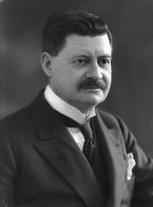 Sir
Charles Elliot (1862-1931), British diplomat and
colonial administrator, in his book, Hinduism
and Buddhism, vol. I, p 405 wrote: Sir
Charles Elliot (1862-1931), British diplomat and
colonial administrator, in his book, Hinduism
and Buddhism, vol. I, p 405 wrote:
"Zen
is the Japanese equivalent of Sanskrit
Dhyana (meditation) or Ch'an and is the name given to
the sect founded in China by Bodhidharma.
Dr.
Post
Wheeler (1869 - 1956) a diplomat and editor of The
Sacred Scriptures of the Japanese: With All Authoritative
Variants, Chronlogically Arranged also said:
‘Many fragments of the Japanese myth-mass
were unmistakably Indian. The original homeland of the first man
and women of Japanese mythology is said to have been in the
Earth-Residence-Pillar i.e. Mount Meru of Indian
mythology.
There is another story of Buro-no-Kami whose identity has been
established with the deity called Brave-Swift-Impetuous-male.
This Kami may be none other than the Indian deity Gavagriva, the
Ox-head deity. The story recounts in the style of the jatakas
how the deity punished the heartless rich brother and rewarded
the king hearted poor brother. In India one of the names of the
moon is Sasanka (lit. having a rabbit in the lap) and there is
an ancient Indian legend why it is so called. The belief
prevalent in ancient Japan that there lived a rabbit in the moon
was probably an outcome of the Indian influence."
(source:
India and Japan: A
Study in interaction during 5th cent - 14th century - By Upendra
Thakur p. 27 - 41).
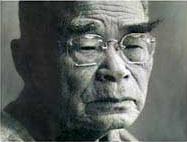 Dr.
D. T. (Daisetz Teitaro) Suzuki
(1870-1966) was
a Japanese Buddhist and Zen scholar, who has written
several books, including Zen Buddhism and Its Influence on
Japanese Culture and An Introduction to Zen Buddhism.
He has said: Dr.
D. T. (Daisetz Teitaro) Suzuki
(1870-1966) was
a Japanese Buddhist and Zen scholar, who has written
several books, including Zen Buddhism and Its Influence on
Japanese Culture and An Introduction to Zen Buddhism.
He has said:
“The
study of Japanese thought is the study of Indian thought”
(source:
India:
Mother of Us All - By Chaman Lal p. 25).
Donald
A. Mackenzie (1873 - 1936) author of Myths
of Pre-Columbian America has written:
"The Indian form of myth of
The
Churning of the Milky Ocean reached Japan.
"In a
Japanese illustration of it the mountain rests on a tortoise,
and the supreme god sits on the summit, grasping in one of his
hands a water vase. The Japanese Shinto myth of creation, as
related in the Ko-ji-ki and Nihon-gi,
is likewise a churning myth. Twin deities, Izanagi, the god, and
Izanami, the goddess, sand on "the floating bridge of
heaven" and thrust into the ocean beneath the "Jewel
Spear of Heaven". With this pestle they churn the primeval
waters until they curdle and form land."
(source: Myths
of Pre-Columbian America - By
Donald A. Mackenzie ASIN 185958490X p.190
-191).
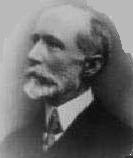 Basil
Hall Chamberlain (1850 - 1935)
One of the foremost Western interpreters of things
Japanese has observed:
Basil
Hall Chamberlain (1850 - 1935)
One of the foremost Western interpreters of things
Japanese has observed:
"In a sense Japan may be said to owe everything to India; for
from India came Buddhism, and Buddhism brought civilization –
Chinese civilization, but then China had been far more tinged
with the Indian dye than is generally admitted even by the
Chinese themselves.”
""They
do not realize, for instance, that the elderly man or woman who
become, as they say inkyo,
that is, hands over the care of the household to the next
generation....they do not realize that this cheery and eminently
practical old individual is the lineal representative of the
deeply religious Brahman
householder, who, at a certain age, - his worldly duties
performed, - retired to the solitude of the forest, there to
ponder on the vanity of all phenomena, and attain to the
absorption of self in the world-soul through profound
metaphysical meditation."
"Or
the "true name", which is kept a sacred, is an Indian
heritage. The fire-drill for producing the sacred fire at the
great Shinto shrines of Ise and Izumo seems to be Indian; the
elaboration of ancestor-worship seems to be Indian; all
philological research in the Far East is certainly of Indian
origin, even to the arranging of the Japanese syllabaries in
their familiar order. Not only can some of the current fairy
tales be traced to stories told in the Buddhist sutras,....but
so can some of the legends of the Shinto religion,
notwithstanding the claim confidently put forward, and too
easily accepted by European writers, to the effect that
everything Shinto is purely aboriginal. The very language."
"the
very language has been tinctured, many common words being of
Indian derivation, and even a few common ones, such as abata,
"pock marks"; aka, "water baled out of a boat;
dabi, "cremation" danna, "master" hachi,
"bowl" kawara, "title" sendean,
"sand-wood" (we English having borrowed the same
Indian word for this Indian thing); sora, "the sky";
to say nothing of such words connected with religion as garan,
"temple"; shamon, "priest" English shaman is
the same word); kesa, "vestment;
" shari, "relic," and numerous others. Indian
is the use of tea now so characterized of China and Japan;
India has dictated the national diet fostering rice-cultures and
discrediting the use of flesh, which seems to have been a staple
article of Japanese food in pre-Buddhistic days."
(source: Things Japanese
– By Basil
Hall Chamberlain p. 246 - 247).
 Dr.
Subhash Kak (1949 -
) is a widely known scientist and a Indic scholar. Currently a
Professor at Louisiana State University, he has authored ten
books and more than 200 research papers in the fields of
information theory, quantum mechanics, and Indic studies. He is
a Sanskrit scholar and is author of Astronomical
Code of the Rig Veda, and India
at Century's End:
Essays on History and
Politics. Dr
SubhashKak has recently resolved Einstein's twin paradox. Dr.
Subhash Kak (1949 -
) is a widely known scientist and a Indic scholar. Currently a
Professor at Louisiana State University, he has authored ten
books and more than 200 research papers in the fields of
information theory, quantum mechanics, and Indic studies. He is
a Sanskrit scholar and is author of Astronomical
Code of the Rig Veda, and India
at Century's End:
Essays on History and
Politics. Dr
SubhashKak has recently resolved Einstein's twin paradox.
He
has observed:
“The Vedic
devas went to
China
and
Japan
through
Kashmir
. The fourth great council was held there under the patronage of
the Kushana emperor Kanishka (r. 78-120) in around 100 CE, where
monks of the
Sarvastivādin
School
compiled a new canon. This became the basis of Mahāyāna.
The Vedic devas were a part of this understanding, as was dhyāna
of the Vedic tradition (Ch’an in
China
and Zen in
Japan
) with devotion to Īśvara (Śiva) as its ultimate
objective (Yogasūtra 1.23). The Parihāsapura monuments
(near
Śrīnagar
) of the Cankuna stūpa (Kārkota dynasty, 8th
century) “served as a model all across Asia from
the
Pamir
Mountains
to
Japan
”.
“Vedic
ideas were also taken to
Japan
by the sea route from South India and
Southeast Asia
. That serves to explain the specific transformations of some
Sanskrit terms into Japanese through Tamil phonology. For
example, consider the transformation of Sanskrit homa, the Vedic
fire rite, into Japanese goma, where the initiation
is given by the achari (Sanskrit ācārya). The Sanskrit
mantras in
Japan
are written the Siddham script of
South India
.”
***
Imperial Patronage
The new religion began to be widely professed, partly due to
the arrival in Japan of missionaries, magicians, the Scriptures
and various accessories for rituals, etc. Buddhism received its
first Imperial patronage from Prince
Shotoku (574-621), who became regent to the Female
Emperor Suiko in 593.
He drew up Japan's first Constitution, proclaiming the
"Three Treasures" (triratna), ie. The Buddha, The
Dharma and the Sangha, to be the ultimate objects of faith. At
government expense, he built Buddhist temples, pagodas,
hospitals, and asylums for the aged and the destitute. Horyu-ji
Temple built by him near the city
of Nara, is the most ancient wooden building still existing in
the world.

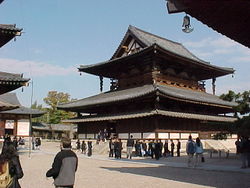
Portrait of
Prince Shotoku: An
oldest portrait in Japan with Prince Eguri on the left and
Prince Yamashiro-no-Oe on the right. Horyu-ji temple built by him near the city
of Nara, is the most ancient wooden building still existing in
the world.
***
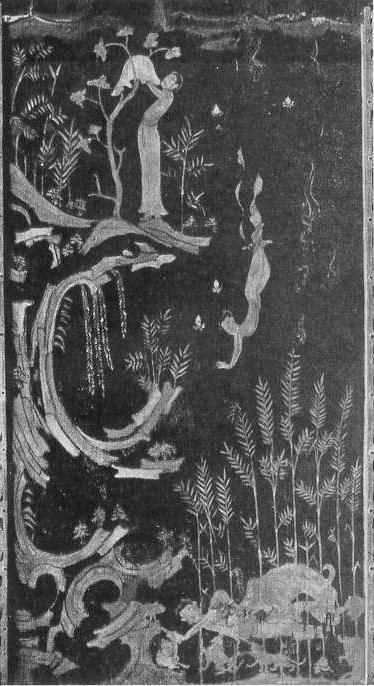
Brahmaprabha on the panel of Tamamushi-no-Zushi, preserved in
the Golden Hall of the Horyu-ji Temple, the paintings by
litharge technique.
(For
more refer to chapter on Greater
India: Suvarnabhumi and
Sacred
Angkor).
***
During
the past 1200 years, Indians have come to Japan from time to
time. It is said that in the period of Emperor Kotoku (645-654)
a seer called Hodo (Dharma-marga or Dharma-patha) came from
Rajagrha of India. The first Indian to come to our land was
Bodhisena, a Buddhist monk. He was born of a Brahmin family in
India. His clan (Gotra) was
Bharadvaja.
Receiving a mystic inspiration from Manjushri Bodhisattva,
he went to China and lived in the Wu t'ai shan Mountain. At the
request of several Japanese who were in China for diplomcatic
negotiations and for study, Bodhisena came to Japan along with
other Buddhist monks from China and Indo-China in 736. He
arrived at his destination in 736 AD. He was cordially received
by the Imperial Family, and was appointed Head Priest informally
called as Baramon (Brahman)
archibishop.
Hindu Gods Introduced to Japan
Hajime
Nakamura (1912 - 1999) His
field of research was exceedingly broad, encompassing Indian
philosophy, Buddhist studies, historical studies, Japanese
thought, comparative thought. Author of several books including Japan
and Indian Asia, he has written:
"Without Indian influence Japanese culture would not be
what it is today.”
"As most Japanese profess the Buddhist faith, needless
to say, they have generally been influenced by Indian ideas to a
great extent."

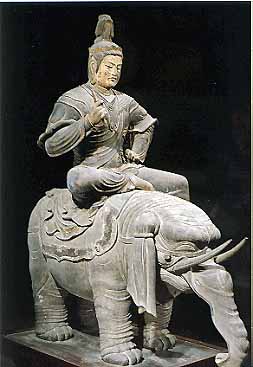
Indra, god of thunder found in the Rig Veda, is adored in
Japan as Taishakuten.
***
Indra, originally the god of thunder and then
most popular of
all gods to be found in the Rig Veda, is adored by people here
under the name of Taishakuten (literally, Emperor of Gods or
Shakra).
Ganesha, the Indian god of wisdom, who has the head of an
elephant and the trunk of a human being, is worshipped under the
name of Sho-ten, (literally, Holy God), in many Buddhist
temples, as one who confers happiness upon its votaries,
especially in love affairs. In Japan we very often find figures
of two Ganeshas, male and female, embracing each other (Mithuna).
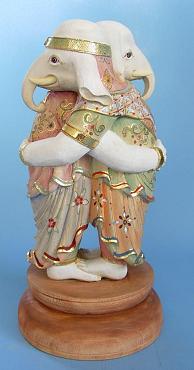
Ganesha
known as Sho-ten in Japan.
A new concept of Vinayaka couple both elephant-headed – a
unique development in the religious history of Japan. The concept of this twin form of
Ganesa (with Ganesani) could not develop in India proper.
***
A sea-serpent, worshipped by sailors, is called Ryugin/Ryujin
a
Chinese equivalent of the Indian Naga.
Hariti and Dakini, Indian
female demons, are also worshipped, the former under the name of
Kishimo-jin, and the latter retaining its original name.
Bishamon is the a Japanese equivalent of the Indian
Vaishravana (Kubera), the god of fortune. Not only Japanese
Buddhism, but Shintoism also, has been considerably influenced
by Indian thought. The following are some interesting examples:
Suiten (water-god) is a Shintoist name. But the god, widely
worshipped by people in downtown Tokyo, was originally Varuna
(water-god in India) and was introduced into the Buddhist
Pantheon by esoteric Buddhism, and then adopted by Shintoists,
though Shintoists may hesitate to agree with this explanation.
Kompira, a god of sailors, is worshipped at Kotohira Shrine, in
Kagawa Prefecture, on the island of Shikoku. Kompira is corrupt
form of Kumbhira, a Sanskrit word for crocodile in the Ganges.
Ben-ten (literally, Goddess of Speech) is the Chinese and
Japanese equivalent of Saraswati.
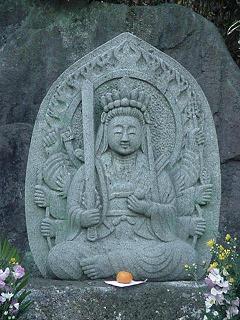
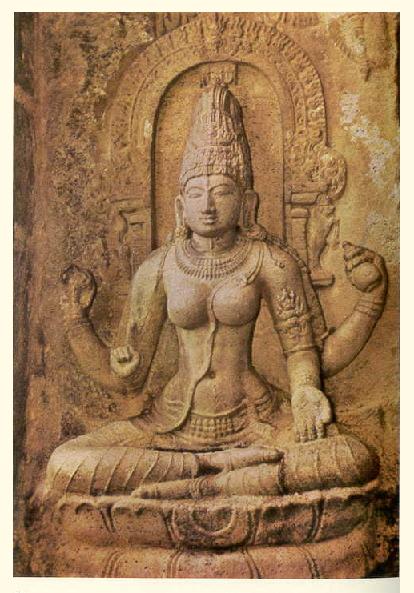
Benten from Japan.
Saraswati
from Brihadeshvara temple, Tanjore, India.
Sarasvati is yet another Hindu deity extremely popular in
Japan, and is known by various names such as Benzai-ten, Bezai-ten,
Benteu, Benten, Sama, Benzamini.
This concept of the goddess, it
appears, was irretrievably linked up with her personification
with the famous Vedic river Saraswati.
Watch
Scientific
verification of Vedic knowledge
(For
more refer to chapter on Greater
India: Suvarnabhumi and
Sacred
Angkor).
***
Along the sea coast and around
ponds and lakes, one often finds shrines of Ben-ten where her
image is installed. Daikoku, a God of fortune (literally, god of
great Darkness or Blackness) is a favorite god with the common
people. The name is the Chinese and Japanese equivalent of Mahakala, another name for
Lord Shiva, the mightiest god of the
Hindu Pantheon, though Daikolu is clad in Japanese robes and has
a benign and smiling countenance.
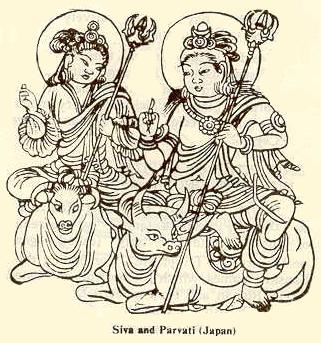
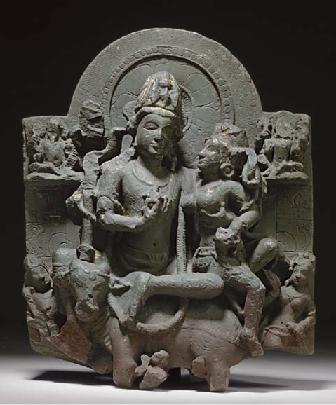
Shiva
(Mahakala) is known as Daikoku in Japan. Shiv Parvati 10th
century, India.
***
Visvakarman, maker of the world in the Rigveda, also was
esteemed as the god of carpenters in the royal court in ancient
times under the name of Bishukatsuma. Cf. “Eiga-monogatari.”
Sanskrit characters are also observed even in Shintoistic rites.
The traditionally dressed climbers of Mount
Ontake, put on
traditional white robes on which, sometimes, Sanskrit characters
(siddham) of an ancient type, are written all over. They
sometimes wear white Japanese scarfs (tenugui) on which the
Sanskrit character “OM” the sacred syllable of the Hindus,
is written, although the climbers themselves cannot read it."
Deep Influence
of India
Historical records show that an Indian drifted to the shore
of Aichi Prefecture in 799 AD and taught the people how to
cultivate cotton. An ethnology scholar has pointed out that
there is evidence that an Indian community existed in Shima
district in Mie Prefecture.
(source: Japan
and Indian Asia - Hajime Nakamura p. 1 - 31).
Hinduism
and Buddhism went from India to China and Korea to Japan. Images
of Ganesha and Vishnu have been found throughout Japan.
According to
Historian D. P. Singhal,
"Some Hindu gods, who had been incorporated into the
Buddhist pantheon, were amongst them. For example, Indra,
originally, the god of thunder but now also the king of gods, is
popular in Japan as Taishaku
(literally the great King Sakra); Ganesha
is worshipped as Sho-ten
or Shoden (literally, holy god) in many Buddhist
temples, and is believed to confer happiness upon his devotees.
A sea-serpent worshipped by sailors is called Ryujin, a Chinese
equivalent of the Indian naga. Hariti
and Dakini are also worshipped, the former as Kishimo-jin,
and the latter by her original name. Bishamon is a Japanese
equivalent of the Indian Vaisravana (Kubera),
the god of wealth.
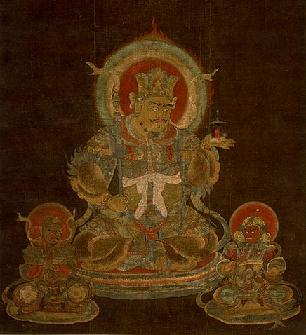
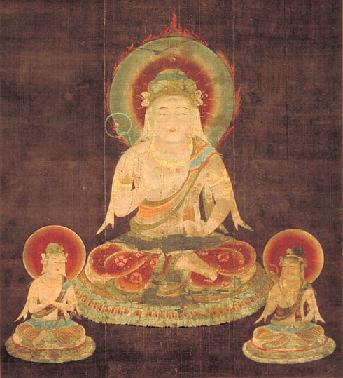
Bishamon is a Japanese
equivalent of the Indian Vaisravana (Kubera),
the god of wealth.
The Indian sea god
Varuna,
is worshipped in Tokyo as Sui-ten (water-god).
***
Even
Shinto adopted Indian gods, despite
its desperate efforts after the Meiji Revolution to disengage
itself from Buddhism. The Indian sea god Varuna,
is worshipped in Tokyo as Sui-ten (water-god); the Indian
goddess of learning, Saraswati,
has become Benten (literally, goddess of speech), with many
shrines dedicated to her along sea coasts and beside lakes and
ponds. Shiva is well known
to the Japanese as Daikoku (literally, god of darkness), which
is a Chinese and Japanese equivalent of the Indian Mahakala,
another name of Shiva. Daikoku is a popular god in Japan. At the
Kotohira shrine on the island of Shikoku, sailors worship a god
called Kompera,
which is a corruption of the Sanskrit word for crocodile,
Kumbhira. The divine architect mentioned in the Rig Veda,
Vishvakarma,
who designed and constructed the world, was regarded in ancient
Japan as the god of carpenters, Bishukatsuma. The Indian Yama,
the god of death, is the most dreaded god of Japan, under the
name of Emma-o,
the king of hell.
According to author Donald
A. Mackenzie: "The Indian form of myth of The
Churning of the Milky Ocean reached Japan. In a
Japanese illustration of it the mountain rests on a tortoise,
and the supreme god sits on the summit, grasping in one of his
hands a water vase. The Japanese Shinto myth of creation, as
related in the Ko-ji-ki and Nihon-gi,
is likewise a churning myth. Twin deities, Izanagi, the god, and
Izanami, the goddess, sand on "the floating bridge of
heaven" and thrust into the ocean beneath the "Jewel
Spear of Heaven". With this pestle they churn the primeval
waters until they curdle and form land."
(source: Myths
of Pre-Columbian America - By
Donald A. Mackenzie ASIN 185958490X p.190
-191).
Top
of Page
Hinduism played a very significant role in
molding Japanese
character and culture.
"Shintoism
has been designated by some scholars as the Japanese version of
Hinduism" - Chaman Lal.
***
The new teachings of the Shingon sect
originated in India much before it was introduced in China in
the 8th century A.D. The Shingon or esoteric
principles are based on Tantric rituals which were practiced in
India by the followers of Sanatan Dharma since early times.
China received esoterism in the fourth century A.D. it actually
flourished there from the eighth century onward. From there it
reached Japan through Saicho (Dengyo Daishi) and Kukai (Kobo
Daishi).
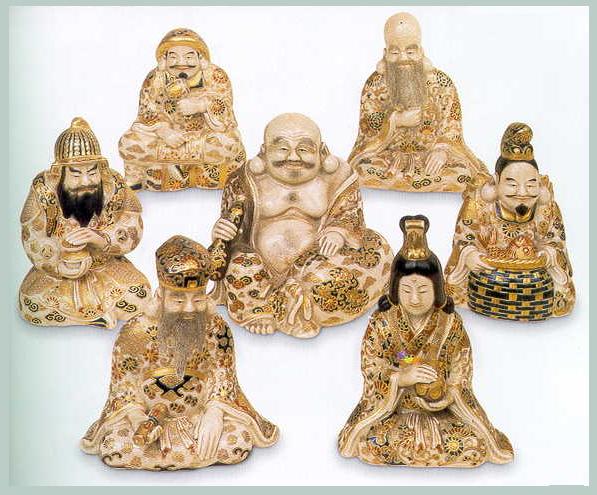
Seven
Gods of Japan.
Hindu Gods and Goddesses who
found their way to Japan and China slightly changed, ‘hued in
Chinese dye.’
***
Hindu deities accepted in Indian Buddhism found their way to
China as part of Buddhist pantheon, and the mode of worship of
these divinities was exactly the same as followed by the
Buddhists in India. The Chinese transformed the Indian elements
in Buddhism in their own way, with the result that the character
and role of the Buddhism oriented Hindu Gods and Goddesses who
found their way to Japan and China slightly changed, ‘hued in
Chinese dye.’

Seven
lucky Gods of Japan - Ebisu, Daikoku (Shiva, Mahakala),
Benzaiten (Saraswavti), Bishamonten (Vaisravana or Kubera),
Fukurokyu, Hoteil and Juroujin.
***
The Hindu deities in course of time again passed through
another phase of transformation to suit the Japanese thoughts
and ideas, and many of these transformed deities gained highly
revered positions which they had never before attained either in
India or China. In fact, several minor gods and goddesses who
were too insignificant to merit careful attention in India,
attained a considerably exalted position in Japanese Buddhist
pantheon. It is commonly believed in Japan that the Hindu deities if
worshipped properly, bestow quickly material benefits and other
favors in day to day life on their devotees rather than any
spiritual gain. This has made these gods and goddesses very
popular in Japan as “the common people are more interested in
worldly or material benefits than in the so-called abstract
spiritual achievement.”
Of the various Hindu deities who were widely worshipped in
Japan:
Indra (Taishaku-ten), Varuna (Sui-ten), Yama (Emma), Agni
(Ka-ten), Mahakala (Daikoku-ten), Sarasvati (Benzai-ten or
Banten), Ganesa (Sho-ten or Kangi-ten), Brahma (Bonten), Vayu (Hu-ten),
Vaisravana or Kubera (Bishamon-ten), Mahesvara (Makei-shura-ten),
Isana (Ishana-ten), Nilakantha (Shokyo-Kannon), Prithvi (Ji-ten),
Surya (Nit-ten), Chandra (Gat-ten), Narayana or Vishnu (Naraen-ten),
Kumara or Kartitikeya (Kumara-ten), Lakshmi (Kichijo-ten)
Marishiten,
Idaten (Skanda) and
many other minor deities.
These deities protected Buddha and the Buddhist world. Indra,
the king of gods, played an important role as a virtual
protector of Buddhism. In China and Japan, Indra was worshipped
with usual vajra (thunderbolt) and guarding the entrance of some
monastery or temple. Taishaku-ten, the Japanese name of Indra,
is derived from the Chinese Ti-shih-t’ien. He is variously
known in Japan as Shakudaikanin (Sakra devanam), Makaba (Maghavan),
Basaba (Vasava), Shashibachi, Kausika and Sngan (the
thousand-eyed: Sahassa natta).
The different Japanese texts, such as Dainichi-kyo (the
Mahavairocana Sutra), the Sonsho-Buccho-Shuyuga-Ho-Kigi, the
Seiryo-ki, the Shosetsu Fudo-ki and the Kongo-kai-Shichi-shu,
are unanimous in placing Indra in eastern gate, wearing jeweled
crown and ornaments and holding vajra in his hand.
Besides him,
Agni is also one of the twelve guardian-deities
in Japan who is everywhere depicted as guarding the south-east
corner. He naturally finds his place in Japanese Mandara which
has remarkable similarity with the representation of Agni in
some Indian sculptures.
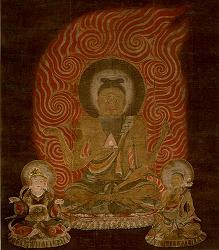

Agni
and Yama - Ka-ten and Emma-ten in Japan.
(source:
Tokyo National Museum).
***
The worship of Yama is incorporated in the Ju-o or Ten Kings.
He is known as Yama-ten ie. Yama deva when benign and Emma O
when dreadful as the Judge of the Dead. In Japan such shrines
are dedicated to Yama are called Emma-do ‘Hall of Yama’,
with drawings or paintings of ten kings inside the hall.
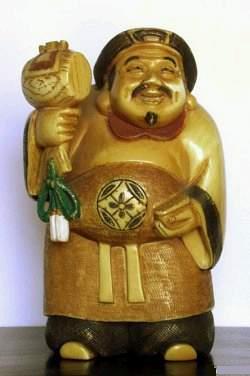
Shiva/Maheshvara - Makeishura-ten or Daikoku/ Also known as
Ishana. Of whom various forms have been conceived
in Japan.
***
The other god, who plays a significant part in the religious
life of the Japanese people, is Maheshvara (Makeishura-ten),
otherwise called Shiva of whom various forms have been conceived
in Japan. He is depicted as having two, four, eight and eighteen
arms and riding a white ox. Mahakala (Daikoku), the terrific god
(another form of Shiva), whose images abound in the temples of
Tibet and China enjoys an exhalted position as a household deity
in Japan whose association with wealth and prosperity gave rise
to a strange but interesting custom known as Fuku-nusubi
(fortune-stealing). This custom started with the belief that he
who stole divine figures (gods and goddesses) was assured of
good fortune, if not caught in the act of stealing. In the
course of time stealing of divine images became so common a
practice in Japan that the Toshi-no-ichi or the
‘year-end-market’ held in the Asakusa Kannon temple became
the main venue of the sale and disposal of such images by the
fortune-seekers. Many small stalls were opened where articles
including images of Daikoku or Mahakala were sold on the eve of
New Year celebrations.
In ancient times, the Japanese warriors went to war in
helmets bearing Sanskrit bijas as benediction for victory. Such
helmets can still be seen at the Reihokan Museum at Koyasan. The
Tokonoma or alcoves in Japanese parlor often have a smiling
image of Daikoku or Mahakala, clad in Japanese robes, and
standing on two bags of rice representing affluence. Mahakala,
as we know, symbolized the Great Time (maha = great and kala =
time): the time of affluence, in contradistinction to a-kala
(famine): the negation (a) of good time (kala). The Japanese
also maintain the Bijaksara of Mahakala as a Siddham-nagari
monogram. The traditional pilgrims climbing the holy Mount
Ontake wear tenugui on white Japanese scarves with the sacred
mantra Om.
Vishnu, one of the Puranic trinity, is not as popular as in
India. He is referred to as Naraen-ten (Narayana), also called
Kengo-rikishi or Kongo-rikishi
or Nio has many common features with
Vishnu (Bishinu-ten) in Japanese. Visnu-Narayana, according to
Japanese conception, possesses unusual physical strength,
generally rides Karura (Garuda), has one face and two arms, or
three faces with two arms, the left face assuming the face of an
elephant or lion and the right one having the form of a bear. He
is shown having four or eight arms only in rare cases. In the
Karura-o-Oyobi-Shoten-Mitsugon Kyo he is also refered to as
Vijaya, having three faces and four arms, with a halo of green
color behind his head. Karura (Garuda) received treatment in
Japan apart from his position as Nararen-ten’s mount, and the
Sesasayana aspect of Narayana is nowhere referred to in the
Japanese text.
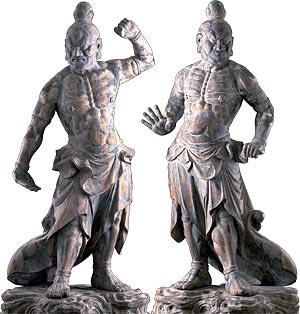
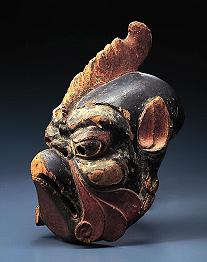
Vishnu
and Garuda
Vishnu
as Naraen-ten or Kongo-rikishi. Visnu-Narayana.
According to
Japanese conception, possesses unusual physical strength,
generally rides Karura (Garuda),
Nio
guardian figures are named Misshaku Kongo (Agyo) and Naraen
Kongo (Ungyo). They represent the use of overt power and latent
power, respectively. Naraen is also called Narayana (Sanskrit).
***
In Japan, the
Nio guardian figures are named Misshaku Kongo (Agyo) and Naraen
Kongo (Ungyo). They represent the use of overt power and latent
power, respectively. Naraen is also called Narayana (Sanskrit)
Ganesha or Sho-ten or Shoden (also Vinayaka in Japanese), on
the other hand, seems to have been widely worshipped god in
Japan with whom is associated the Chinese-Japanese conception of
the elephant-headed male-female embracing Vinayaka. One of the
most popular deities in Japan, Ganesa traveled through China.
Variously known as Daishokangi-ten (abbreviated as Kangi-ten),
Sho-ten, Ganabachi (Ganapati), Nandikeshvara and Binayaka-ten (Vinayaka),
he is without doubt the product of the introduction of
Tantricism in China and Japan (806 A.D onward) which envisaged
an elephant-headed Yogini form of female Vinayaka giving birth
to a new concept of Vinayaka couple both elephant-headed – a
unique development in the religious history of Japan. It is
really strange to find that though the Japanese Durani-shu-kyo (Dharani
Samuccaya) originated in India, the concept of this twin form of
Ganesa (with Ganesani) could not develop in India proper.

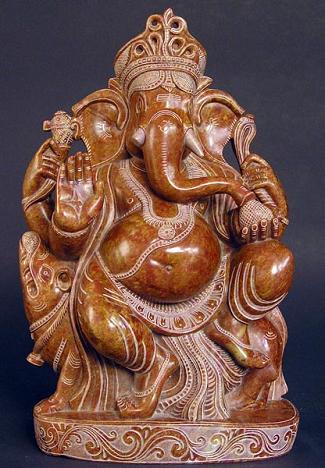
Lord
Ganesha known as Kankiten, Shoten, Shoden in Japan.Kankiten
statue in front of Fukuoka Tower.
One of the
most popular deities in Japan, Ganesa traveled through China.
***
The popularity of this god can be judged from the fact that
there were about 250 temples in Japan in which the images of Sho-ten
and Kongi-ten are worshipped either as a single image or
double-bodied images. In the Hozan-ji temple on Mt. Ikoma in
Nara, Sho-ten is worshipped mainly by the merchants. In Osaka we
have the biggest temple of Sho-ten, where, besides devotees, a
permanent priest offers prayers daily. Moreover, the priests
also separately offer prayers to him to remove obstacles in way
to success.
In the Japanese test
Daisho-kangi-Soshin-Binayaka-tongyo-Zohon-Giki (vol. I) he is
also called Daijizai-ten (Maheshvara) a conception which we come
across also in Brahaddharma Purana, where Ganesha is given fifty
different appellations one of which says that “Shiva and
Sankara’ are but the two appellations ascribed to Ganesa which
is further corroborated by the Agni Purana (chap. 71) wherein
Mahadeva is said to be one of the many appellations of Ganesha.
Ganesha is still worshipped in Japan. A special temple is
consecrated to the esoteric Twin Ganesa at the Jingoji monastery
of Takao where every year worship is held in his honor. Besides
this, special shrines are also dedicated to Ganesha in some
other Mantraynic monasteries. Sometimes, even in shops one comes
across graceful images of either standing or seated Ganesha.
Skanda-Karttikeya also appears to have been one of the
extremely popular deities in Japan. Variously known as
Kumara-ten, Kenda or Ida-ten he is regarded as the son of
Daijizai-ten (Maheshvara) in Japanese mythology.
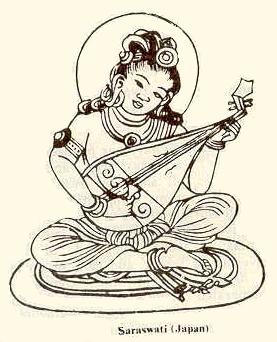
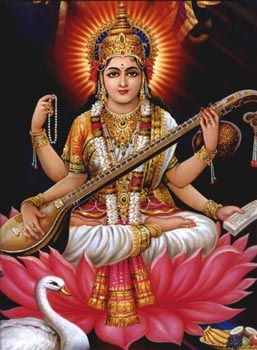
Goddess
Saraswati known as Ben-ten in
Japan.
***
Saraswati
is yet another Hindu deity extremely popular in
Japan, and is known by various names such as Benzai-ten, Bezai-ten,
Benteu, Benten, Sama, Benzamini, Myo-ongakuten, Meoongten,
Myo’on-ten (goddess with sweet voice), Daiben, Dai-Benzai-ten
(goddess of great intelligence), Dai-bentenno, Bio-ten, Ku-doku,
Mio-on-Tennio. Etc.
The first such goddesses made in Japan were
of Kichijo-ten (Sridevi or Lakshmi) and Benzai-ten (Sarasvati).
The Indian concept of Sarasvati being the consort of Brahma is
also retained in Japan. Generally considered as an extremely
beautiful lady, she is supposed to be the ideal of feminine
beauty, and the goddess of music, wealth, fortune, beauty,
happiness, eloquence and wisdom.
This concept of the goddess, it
appears, was irretrievably linked up with her personification
with the famous Vedic river Saraswati.
It is interesting to note
that while in India she is always depicted as a charming goddess
of music, fine arts, and learning holding a vina with her both
hands, in Japan she is sometimes portrayed as a ferocious
goddess too, embodying ugliness as well as beauty. Benten with a
lute is a beautiful lady, but Benten with a sword is a brave
lady like Itanuka of whom the people are frightened. There is an
image of Benten in war-like posture, in Enoshima, holding a
sword in her hand with a serpent and tortoise sitting at her
foot and two Deva kings standing on either side.
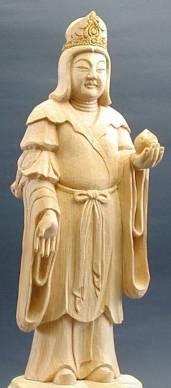 

Lakshmi
- Kichijo-ten, the goddess of wealth in Japan. Lakshmi from
Angkor, Cambodia.
The
elegant image of Kichijo-ten was first made it impressed the
Japanese Buddhist monks so much that they became ardent devotees
of this goddess and her popularity spread far and wide within a
very short period.
(For
more refer to chapter on Greater
India: Suvarnabhumi and
Sacred
Angkor).
***
Lakshmi (Kichijo-ten), the goddess of wealth, is extremely
popular. She is variously known as Kichisho-ten or Kissho-ten or
Makashiri (Maha Sri) and as Lakushmi.
From the Mikkyo-no-Bijutsu
we learn that the image of Laksmi (Kichijo-ten) was the first
image of a female deity in Japan in the Nara period (645 – 794
AD) which for the first time witnessed the making of the images
of the female divinities like Lakshmi and Sarasvati (Benzai-ten)
and Hariti (Kishi-mojin).
From the Mikkyo-no-Bijutsu
we learn that when the elegant image of Kichijo-ten was first
made it impressed the Japanese Buddhist monks so much that they
became ardent devotees of this goddess and her popularity spread
far and wide within a very short period. This is further
confirmed by a passage in the Nihon Ryoki. The “dazzling
beauty” of this goddess “aroused more than ordinary interest
on the part of the priests. Needless to say, the popularity of
Kissho-ten worship spread quickly. There is even an old story
about a man who fell in love with a picture of this splendid
beauty.”
She is depicted in various forms. She is generally seen beside Bishamon-ten.
In the Nara period the images of this goddess were made
“both in icons and objet d’art. Two images of this deity
belonging to the Nara period are still preserved in the
refectory of the Horyuji temple
and in the Hokke-do shrine of the Todai-ji
temple. One of the many images of this goddess, one
preserved in the Yakushi-ji temple
is very famous. It is painted in fine colors on fine hemp cloth.
Another beautiful image made of wood (1078 AD) of the Heian
period is preserved in the Golden Hall of the Horyu-ji temple.
Yet, another very famous sculpted image of the goddess is
preserved in a Zushi or shrine of the Jaruri-ji temple, Kyoto.
Besides these Vedic deities, the
Raksasas
and the Asuras
were also
given due place in the Japanese pantheon. In Japanese mythology,
Raksasa and Nairrti are known as Rasetsu and Nirichi (Niri-ieio)
respectively.
Garuda, the mythical bird and mount of Lord
Vishnu is known as Karura in Japanese mythology which is also
associated with Naraen-ten or Narayana as his vehicle.

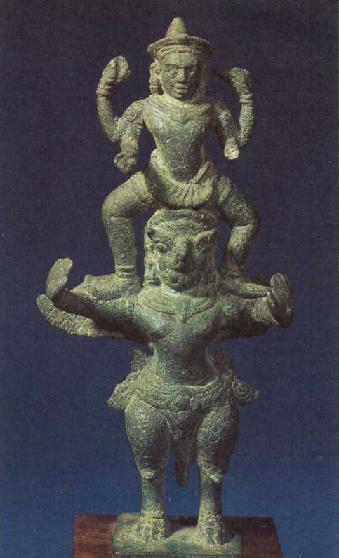
Garuda, the mythical bird and mount of Lord
Vishnu is known as Karura in Japanese mythology which is also
associated with Naraen-ten or Narayana as his vehicle.
Lord
Vishnu on Garuda, his vehicle.
***
Co-existence of the native Shinto and Indian Buddhists
and Vedic deities in the same temple was, and is a common
feature in Japan. Like Buddhism, Tantricism, an inseparable part
of Hinduism spread far beyond the boundaries of India, Nepal,
Tibet and Burma. Thus, we find that the Hindu gods who were
incorporated into Indian Buddhism gradually found their way to
China and then to Japan where many of these Hindu deities found
a status which they had never attained either in India or China.
(source: India and Japan: A
Study in interaction during 5th cent - 14th century - By Upendra
Thakur p. 27 - 41).
Top
of Page
Indian
Influence on Japanese Stories
A
considerable portion of the cosmogonical and mythological
literature of Japan bears traces of Indian influence. Hajime
Nakamura observed ' Some stories of ancient India were very
influential in shaping Japanese stories by providing them with
materials. In the process of shaping, however, Indian materials
were greatly modified and adapted in such a way as would appeal
to the mentality of common people of Japan in general' quoted
from Lokesh Chandra and
others - India's Contribution to World
Thought and Culture.
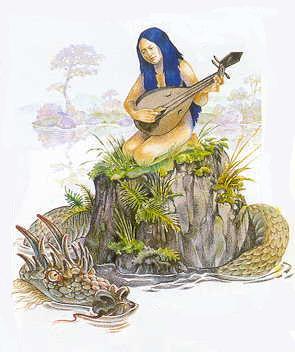
In
the annals of the Todaiji temple, it has been stated that the worship
of Sarasvati
and Lakshmi was first introduced in 722 AD.
and continued down the centuries.
***
Post
Wheeler editor of The
Sacred Scriptures of the Japanese: With All Authoritative
Variants, Chronlogically Arranged, also said ‘Many fragments of the Japanese myth-mass
were unmistakably Indian. The original homeland of the first man
and women of Japanese mythology is said to have been in the
Earth-Residence-Pillar i.e. Mount Meru of Indian mythology.
There is another story of Buro-no-Kami whose identity has been
established with the deity called Brave-Swift-Impetuous-male.
This Kami may be none other than the Indian deity Gavagriva, the
Ox-head deity. The story recounts in the style of the Jatakas
how the deity punished the heartless rich brother and rewarded
the king hearted poor brother. In India one of the names of the
moon is Sasanka (lit. having a rabbit in the lap) and there is
an ancient Indian legend why it is so called. The belief
prevalent in ancient Japan that there lived a rabbit in the moon
was probably an outcome of the Indian influence.
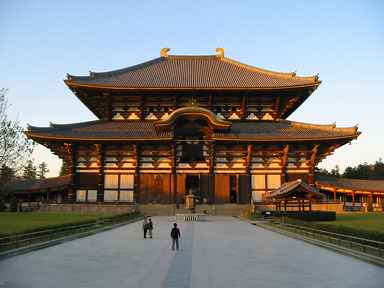 In
the annals of the Todaiji temple, it has been stated that the worship
of Sarasvati
and Lakshmi
was first introduced in 722 AD.
and continued down the centuries. In
the annals of the Todaiji temple, it has been stated that the worship
of Sarasvati
and Lakshmi
was first introduced in 722 AD.
and continued down the centuries.
In Bessom Zakki (Description
of Gods) written in the 12th century written in the
Siddham script, a corrupt Sanskrit mantra reads:
'Sarasvatai
svaha namo sarasvatyai mahadevyai svaha, namo bhagavati mahadevi
sarasvati sidhyatu mantrapadami svaha'.
A description of
Sarasvati occurs in the voluminous text Asabasho by Shocho
1205-82 and the rituals connected with her worship have been
recorded by Ryoson 1279 to 1349 in Chapter CXLIX of his
Byaku-hokku-sho (The White Jewel of Indian Tradition). The
adoption of these Hindu deities into the Buddhist and Shintonist
pantheons of Japan indicate the influence of India on Japanese
religions as well as the syncretic character of the religious
systems of Japan.
The
survey made above reveals the immense contribution of India to
the theology of Japanese Buddhism as well as to Japanese
literature. The present indications are that the texts utilized
were all written in Sanskrit, probably in the Siddham script,
and there was no intrusion of Pali, unlike in the Buddhist
countries of South-East Asia.
"Shintoism
has been designated by some scholars as the Japanese version of
Hinduism"- Chaman Lal
- author and researcher.
(source: Indian
Influence on Japanese Stories - esamskriti.com).
Top
of Page
Language and
Literature in Japan Sanskrit
language has been kept in Japan for nearly 1,400 years in the
colleges attached to the great Buddhist temple. Several Sanskrit
texts in the Chinese script had also been brought to Japan. We
have some very ancient Sanskrit manuscripts preserved in some of
the Japanese temples which were brought from India or Central
Asia to China and from there to Japan. It is really surprising
to note that some of the manuscripts found in the Japanese
temples are much older than those preserved in India. Moreover,
there are few countries in the world where so many scholars are
learning Sanskrit as in Japan.
 Hajime Nakamura (1912 - 1999) author of
The
History of Early Vedānta
Philosophy, has pointed
out that the
Hindu Ramayana and its
various versions are found in the name of ‘Taiheiki’
in China and Japan. Even Indian logic was introduced
in China by Hiuan-Tsang (600-664 AD). Hajime Nakamura (1912 - 1999) author of
The
History of Early Vedānta
Philosophy, has pointed
out that the
Hindu Ramayana and its
various versions are found in the name of ‘Taiheiki’
in China and Japan. Even Indian logic was introduced
in China by Hiuan-Tsang (600-664 AD).
The
Japanese scholars regard the arrangement of the Japanese
syllabary into fifty phonetic sounds as "no more than an
adoption of the Sanskrit alphabet. The Japanese characters are
generally constructed on the lines of Chinese characters, like
the Devanagari letters, are phonetic and are arranged in a
sentence in the same order as in Sanskrit - subject (kartta),
object (karma) and verb (Kriya). Bodhisena, the great Buddhist
thinker, made this change in Japanese system possible. Had the
Chinese language and alphabet not penetrated into Japan before
the Japanese came into contact with the Nagari character, the
Japanese no doubt would have adopted the Indian script rather
than the Chinese character.
Some
Japanese warriors in medieval Japan went to the battle ground
with helmets bearing Sanskrit characters
for blessing (mangala)
on their heads. While scaling the sacred Mt. Ongake as a
religious observance, the Japanese climbers wearing traditional
white dress have inscribed on their robes Sanskrit Saiddham
characters of early type. Sometimes they put on white Japanese
scarfs (tenugui) carrying Sanskrit character Om, the sacred
sound symbols of the Hindus.
The
Sanskrit word maha meaning great, appears in Japanese as
maka.
The word moment 'ksana in Sanskrit is setsuna in Japanese. The
Chinese transliteration Chana is close to the original. The
Sanskrit homa, meaning sacrificial fire, becomes goma in
Japanese. The mythical mountain Sumeru which was supposed to
occupy the center of the world, towering 84,000 Yojanas high, is
called Shumisan in Japanese, sau meaning mountain. It is also
interesting to note that the Japanese also used Yojun (Yojana)
in this context.
It
is interesting to note in this connection that some stories of
ancient India proved very influential in shaping Japanese
stories by providing them with interesting themes which in turn
were greatly modified and adapted in such a way as to suit the
taste and mentality of the common people in Japan. People in
early times in India commonly believed that a hare or a rabbit
lived in the moon and hence the latter was called Sasin
(literally 'containing a hare'). The idea influenced the ancient
Japanese so much that they too in the course of time came to
believe that there lived a hare in the moon which made
rice-cakes and pounded cooked rice with pestle which is evident
from the popular Japanese stories like The Fascinating Story of
Monkey and His Liver and The Story of Monoceros (Ekasrnga) as
contained in the Sase Kishu, a medieval collection of popular
Japanese stories.
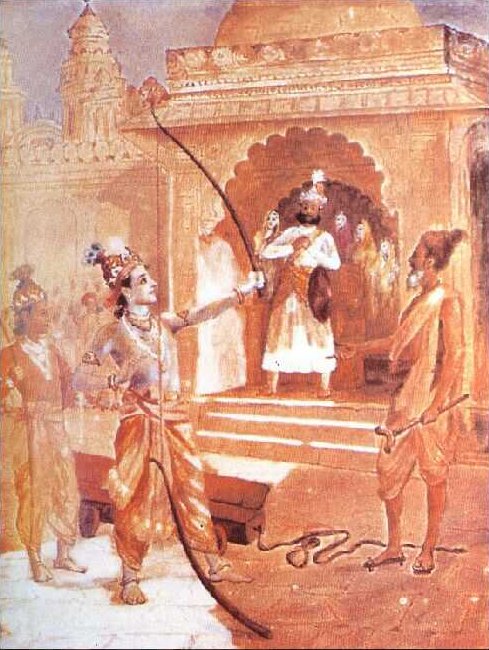
Hajime
Nakamuar has pointed
out that the
Hindu Ramayana and its
various versions are found in the name of ‘Taiheiki’
in China and Japan.
One
can also see the influence of the Indian epic Ramayana in the
traditional Japanese dance forms of 'Bugaku' and 'Gigaku'
***
The story of
Rsyasrnga describes how a saint
who had never seen a woman was seduced by the daughter of King
Lomapada - a famous story graphically narrated in the
Mahabharata which also finds
mention in another important Japanese work, the Taiheiki,
the Japanese Ramayana. The Rishi is called Ikkaku
Sennin or Ekasrnga (Unicorn). This
Japanese version of the story also inspired the composition of
the famous Kabuki drama.
 Maurice
Winternitz (1863-1937) famed
Indologist, author of History
of Indian Literature, while explaining the purpose of this legend says that various
versions of this legend "may be found in other Indian works
of literature, especially in the Ramayana, in the
Padma Purana
and in other Buddhist Jataka books. But, how popular this humorous
tale was, is shown by its being familiar in different
versions in Tibet, China and Japan, and in its having left
traces behind even in the Unicorn-legend of the West. Maurice
Winternitz (1863-1937) famed
Indologist, author of History
of Indian Literature, while explaining the purpose of this legend says that various
versions of this legend "may be found in other Indian works
of literature, especially in the Ramayana, in the
Padma Purana
and in other Buddhist Jataka books. But, how popular this humorous
tale was, is shown by its being familiar in different
versions in Tibet, China and Japan, and in its having left
traces behind even in the Unicorn-legend of the West.
Besides
the Ramayana, Indian logic, called Immoyo
(Hetuvidya), was introduced in China by Hiuen
Tsang (600 - 664 A.D.) which later found its way into
Japan along with the study of Yuishiki (consciousness only)
thought. The Japanese name for this (Indian science of causes)
is Immoyo-gaku and it continues to the present time in the
so-called Hosso Sect.
(source: India and Japan: A
Study in interaction during 5th cent - 14th century - By Upendra
Thakur p. 53 - 79).
Textual theme of Ramayana in Japan
- By Minoru Hara
Two renditions which apparently are derived from the
Valmiki Ramayana as preserved in Mediaeval
Japanese literature.
The first is an abridged version of the Rama story as given
in a collection of popular tales, named the Hobutsushu
(Ratna-samgraha?) by Tairano Yasoyori in the 12th
century, and the second is a modified story of an episode given
in the second book of the Valmiki
Ramayana, that is, Dasaratha’s unwitting slaughter
of a young ascetic, which foreshadows the tragic death of the
king in his later days.
The two Japanese versions are in
their main framework undoubtedly derivations of the Valmiki
Ramayana, but they have come to differ in detail from their
original in the course of their transmission through India to
China, and China to Japan. These Japanese versions are not
directly taken from their Indian original, but came through the
Chinese Tripitaka.
(source: The
Ramayana Tradition in Asia - By V Raghavan. p.
334 – 347).
Top
of Page
Japan's Hindu linkages still alive
One
can also see the influence of the Indian
epic Ramayana
in the traditional Japanese dance forms of 'Bugaku'
and 'Gigaku'
Apart
from the widely known fact that Buddhism in
Japan
has its origin in
India
, not many probably know that so many Hindu deities surround the
life of a Japanese. Speaking
at a lecture titled 'Hindu Gods and Goddesses rooted to
Japan' here Friday, Lokesh
Chandra, the director of International Academy of Indian Culture, highlighted how deeply Indian religion and
culture has influenced Japanese culture and tradition over the
past centuries.
He said that many temples across Japan
are full of Hindu deities.


Lokesh
Chandra, the director of International Academy of Indian Culture
and Japanese Ambassador to India Yasukuni Enoki.
***
Chandra said Japanese couples who desire to have a
beautiful daughter pray to goddess 'Saraswati' even to this
day.
Saraswati is also believed as the patroness of writers and
painters. 'In ancient times, Japanese generals prayed to
Saraswati to be victorious in war,' Chandra told the gathering
which was also attended by the Japanese Ambassador to India
Yasukuni
Enoki and his wife. Year 2007 is being celebrated as Japan-India
Friendship Year to commemorate the 50th year of the cultural
agreement between the two countries.

Benzaiten
or Saraswati in Japan.
***
According to Chandra, who has travelled to Japan
many times to study the country's culture and tradition,
Saraswati is also worshipped as the 'goddesses of kitchen'. Many
traditional Japanese plays are dedicated to the Indian deity.
Sharing a trivia he said how in 1934, a Japanese woman had a
vision that she was the incarnation of goddess Saraswati and
stared writing in Sanskrit, a language she never heard
off.
There
is a suburban district in
Tokyo
named Kichijo,
which traces its roots to 'Lakshmi',
the Hindu goddess of wealth. Lakshmi
was propagated to
China
along with Buddhism in the ancient time, to be known as Kichijo
in its Chinese form and then reached
Japan
as a Buddhist goddess.
Chandra
also spoke extensively about how Sanskrit language has influenced traditional
Japanese calligraphy.
The Indian text was introduced into Japanese
society many centuries ago. Japanese monks had to study Sanskrit
in order to master Buddhism from original Indian scriptures and
textbooks. Lord
Ganesha in Japan
symbolises the joy of life that arises from the power rooted in
the virtues of wisdom and compassion. Young Japanese worship Ganesha to win in love
whereas the old worship the deity to get success in business. There
are roughly 100 temples dedicated to Ganesha in Japan.
An
11th century Ganesha temple is the oldest among them.
Together with Hindu gods and goddess, ancient
Japanese society was also introduced to Indian dance forms and
musical instruments. A typical example is the '
Biwa
',which actually had its origin from the Indian 'Veena'. One of
Japan
's largest lake is also known as
Lake
Biwa. One can also see the influence of the Indian epic
Ramayana in the traditional Japanese dance forms of 'Bugaku' and
'Gigaku'. The yearlong cultural celebration was kicked off here
last week that was attended by former Japanese prime minister
Yoshiro Mori among others.
(source:
Japan
's
Hindu linkages still alive
- rxpgnews.com).
***
Japan
wants to encourage studies of Hindu gods
Japan
wants to encourage studies of Hindu gods and goddesses found in
their country. Saraswati, Laxmi, Brahma, Ganesha among large
number of other deities are still prayed to there though under a
different names.
Saraswati's sketches (Benzaiten in Japanese) sanctify
kitchens in rural areas of Japan
even now, says Director International Academy of Indian Culture
Lokesh Chadra. Japanese understood her as sa-rasavati or the
goddess of the kitchen, Rasavati is 'rasoi' in Hindi.
Talking to the Hindustan Times the Japanese Cultural
Counsellor Shigeyuki Shimamori said, "We would like to
encourage more studies by scholars on the Hindu deities found in
Japan."It is the Mantrayana sect of Buddhism emphasising mantras
(chants) and rituals through which Hindu deities reached Japan, Dr Chandra said. The Japanese also perform "homa"
known as "goma" to their deities even today, they get
ghee flown from Australia, he added.
Sarasvati or Benzaiten in Japanese is one of the Seven
Lucky deities (Shichi-fuku-jin) blessing every home. Couples who
desire to have beautiful daughters pray to her . She is known as
the patroness of writers, composers, musicians and painters.
Besies veena holding Saraswati's another popular form of
Sarasvati found in Japan
is eight armed Saraswati holding weapons in each. In the Rig
Veda itself Sarasvati is termed as "Vritra-hantri" or
slayer of demons, Dr Chandra said.
In Golden Light Sutra
there is a hymn to Sarasvati:
"May Goddess Saraswati protect us in the field of
war".
Many Japanese Generals used to pray to her to defeat
their enemies. Japanese classical theatre NOH
has a drama
dedicated to Saraswati"
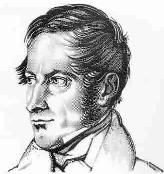 Philipp
Franz von Siebold (1796 - 1866) German scholar has written that
in 1832 there were 131 Shrines
dedicated to Goddess Sarasvati and 100 to Lord Ganesha in
Tokyo
itself . Philipp
Franz von Siebold (1796 - 1866) German scholar has written that
in 1832 there were 131 Shrines
dedicated to Goddess Sarasvati and 100 to Lord Ganesha in
Tokyo
itself .
A 12th century temple to Ganesha in Asa kusa suburb of
Tokyo
is a National Treasure of Japan." Hindu Gods and Goddesses
were introduced into
Japan
in 806 AD by Kobodaishi a Japanese saint who went to China
and brought with him Manytrayana text, scrolls and images.
Ganesha is worshipped as god of love by many young boys and
girls for achieving success in their courtship. The old worship
him for success in business, Dr Chandra said.
Letters or 'bijaksharas' for twelve devas like Agni,
Varuna, Indra, Chandra, Nairritri, Prithvi, Ishana, Brahma,
Aditya ,Yama, Vaishravana, Vayu,were calligraphed by Master
Chozen in Siddham script (called Shittam in Japanese) a seventh
century form of modern Devanagari, he added.
(source: Japan
wants to encourage studies of Hindu gods
- By Satyen Mohapatra - hindustantimes.com
- February 21, 2007).
Top
of Page
Art and Painting in Japan
We have a large number of
representations of Hindu gods and goddesses in old Japanese
paintings and sculptures meant for worship in temples, which
unmistakably vouchsafe for widespread prevalence and popularity
of these deities.
The door panels and walls of miniature shrines contain
paintings which also form part of murals on wooden pillars of
temples. The Mandaras (Mandalas) constitute bigger painted
scrolls, generally on silk, and hung on temple walls, often
portraying figures of Hindu gods and goddesses. Moreover, we
have representations of individual, or group of Hindu deities in
paintings of different kind, such as eight armed Sarasvati, and
Hariti appearing in a panel of the Kichijo-ten Zushi (Lakshmi),
painted representation of Indra in Tamamushi shrine and figures
of Shi-Tenno (Four guardian deities_ on the door of Lady
Tachibana’s shrine. Indra also figures in paintings in the
Tamamushi shrine, Toda-ji temple and Joruri-ji temple, in
addition to his various images made in the refectory of the
Horyu-ji temple along with his famous vajra (thunderbolt).
The lively painting of Bon-ten
(Brahma) in To-ji temple at Kyoto is another
remarkable feat in this series. Portrayed on the panel of a pair
of six-fold screens as one of the Juni-ten
(Twelve Deva Kings or
Guardian Deities) in colors on silk, this and other images of
this set were painted by Takuma Shoga for use at a religious
service. The four-headed and four-armed images of Brahma vividly
portrayed in bright colors stands on lotus pedestal with a long
trident in one of the left hands and the other left holding a
longish pot (kamandalu). The most striking feature of this
presentation is that each of its four faces bears the third eye
placed vertically on the forehead. Varuna, the water-god, also
figures in some of the paintings in Japanese shrines. There is a
ninth century painting of Sui-ten(Varuna) in color, depicted as
one of the Twelve Guardian Deities in Toda-ji temple in Nara.
Seated on a large tortoise and wearing a crown decorated with
the figures of five dragons he is represented as “the god of
seas and rivers.” We have yet another colored painting of
Varuna done on a piece of silk and kept in the To-ji temple in
Kyoto. It is decorated with
ornaments and is no doubt a fine piece of painting.
Another important piece of painting we have is the very old
painted image of Nit-ten (Surya) which is preserved in the
Jingo-ji temple and is depicted without any mouth. The most
interesting point to remember about this god is that while he is
considered to be a goddess in Shinto conception, he is very much
masculine god in Japanese Buddhism. However, Ji-ten or Prithvi
is the earth god (not goddess) in Japanese Buddhism.


Bon-ten
(Brahma) in To-ji temple at Kyoto. Brahma, Chola period. India.
***
Sho-ten or Ganesa or Vinayaka
seems to have been a most popular god in Japan who, like other
Hindu deities, reached there through China. We have various
kinds of Vinayakas painted in outer frame of Ryokai Mandara.
Six kinds of Vinayaka are arranged in four different
directions on the outer hall of Kongo-kai Mandara and are
variously known as Kongosai-ten or Sangai Vinayaka, Onjiki-ten
or Kemon Vinayaka, Kongoi-ten or Kakyusen Vinayaka,
Kongo-chobuku-ten or Chofuku-ten or Kutu Vinayaka and Kangi-ten
or Vinayaka-ten – all elephant headed gods. While in India
Ganesha is regarded as the God of Learning, in Japan he is
popularly believed that the devotees of Ganesa or Vinayaka gain
wealth. The biggest temple of Sho-ten in Osaka attracts a large
number of people every day for offering worship.
Saraswati, the goddess of
learning, music and fine arts, is also regarded as the goddess
of good luck and plenty in Japan and figures in many of the
paintings in different forms. Sarasvati came to be worshipped in
Japan as the Goddess of River and her image is generally
installed in temples besides a river or lake or pond, and a
snake is assumed to be the messenger of Benzai-ten.
The school of meditative or Dhyana
Buddhism produced the greatest influence on Japanese
art. This is popularly known in Japan as Zen Buddhism which
reached Japan from India through China.
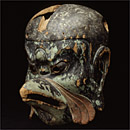 The earliest known music dance of Japan is Gigaku
a kind of mask-play which Mimashi brought to Japan from Korea in
1200 AD. This art (Gigaku) was of Indian origin as indicated by
masks representing Indian features which are still preserved in
a considerable number in the temples of Nara. There were
characters among the dancers who represented a lion and an eagle
which does suggest links with India,
because in China and Japan
there were no lions. Moreover, the term for the eagle character
is Karuna which is nothing but the derivative of the Sanskrit
world Garuda. The earliest known music dance of Japan is Gigaku
a kind of mask-play which Mimashi brought to Japan from Korea in
1200 AD. This art (Gigaku) was of Indian origin as indicated by
masks representing Indian features which are still preserved in
a considerable number in the temples of Nara. There were
characters among the dancers who represented a lion and an eagle
which does suggest links with India,
because in China and Japan
there were no lions. Moreover, the term for the eagle character
is Karuna which is nothing but the derivative of the Sanskrit
world Garuda.
Gugaku is the name for a piece of music, and the dance
accompanying it is known as Bugaku. It is the great Indian monk
Bodhisena and Fu-che, a Vietnamese (old Champa), who are
credited with having introduced these two popular forms in Japan
from India about 1200 years ago. For the first time this court
dance and music was performed in 752 AD, on the occasion of the
opening of the Todai-ji temple at Nara when Shomu unveiled the
statue of the Vairocana Buddha. It is said, hundreds of foreign
musicians, including a large number of Indian musicians,
participated in this great performance. Though about 1200
hundred years old, this music drama is still preserved in its
original form in Japan, not only in records, musical instruments
and masks, but in the dance form itself in the Horyu-ji temple.
It is surprising to note that the original form is not preserved
in present-day India, nor in other Asiatic countries. The
Japanese are justly proud of this art which they have succeeded
in preserving through the centuries.
Japanese music
is
composed of eight (probably more) pieces
- botatsu, garyobin, konju, bairo, bato, riowo or roy-o
amaninomai and banshurako. Some of these names can easily be
traced to Indian origin: eg, botatsu (Sanskrit. Bodhisattva),
bairo (Sanskrit. Bhairava), garyobin (Sanskrit. Kalavinka, a
sonorous, sweet-voiced bird) etc. According to Takakusa, the
Riowo dance is a part of an ancient Indian opera Nagaananda (The
Joy of the Snake) which was written by Emperor
Harsavardhan. The
famous Chinese traveler, I-tsing, while in India, had seen a
performance of this music-drama, and it was probably he who
brought this drama to China whence it entered Japan.
Another remarkable feature of Japanese art is the No
plays which means Dengaku-no-noh, field-music
performance. The two men responsible for this music performance
were Kanami, the priest of the Kasuga temple near Nara (1333-
1384 AD and his son Zeami an outstanding author, actor and
composer. It is interesting to note the analogies between Indian
drama and the Japanese No plays. Just as the Indian drama was a
combination of song and dance, usually performed at sacred
festivals, so was the Japanese No play. The narrative connection
in Indian drama was often preserved by interpreters whose
function closely resembled that of the chorus in Japanese No.
The wonderful art of
Ikebana which means putting living
plants in water is to love flowers as living beings and tend
them with kind feelings. The Japanese bow before the flowers
after arranging them. An aesthetic creation, it was the essence
of life itself, pervaded by the warmth of the human heart. The
Japanese tradition speaks of “Indian monks who, in their
universal love, were the first to pick plants injured by the
storm or parched by the heat, in order to tend them with
compassion and endeavor to keep them alive. While they developed
different trends and schools of flower-arrangement, the fine
feeling for form and the “three main lines” as the
foundation remained constant, which correspond to the tribhanga
in Indian art. In the course of time the ceremony of incense
burning added to the essence of the ritual discipline which a
budding flower and a few leaves inculcated. The clouds of
incense, the gracefully created form, a profound thought
caligraphed on a scroll by the hand of a Master were the Zen
expression of the pancopacara wherein puspa and dhupa had a core
role: so that man may be touched by the deeds of life itself.
Despite the great distance and natural barriers between India
and East Asian countries, cultural exchange on such a large
scale is truly a fact in world history that merits admiration.
(source: India and Japan: A
Study in interaction during 5th cent - 14th century - By Upendra
Thakur p. 65 - 84).
Top
of Page
Follow up
History
Persecuting the
indigenous religions of Japan: forced conversions, murders and
demolished temples
In Japanese, Kyushu
means
both arsonist and a Christian. Its origins lie
in the fact that, besides employing other means of persecution, Nihonjin
Christians would burn down Buddhist
temples and Shinto shrines in
order to convert the
Kyushu
population. It was one of the reasons for
Japan
banning Christianity. As seen before, Christianity caused the same
problems wherever it went and amongst all populations practising
pre-Christian religions. In the history of
Japan
we have an even more striking instance of
Vatican
aggressiveness with profound repercussions in the world. As in
China
and
Siam
, the basic policy was to see that Catholic merchants and Catholic
priests worked together so that both, by extending their own
interests, should ultimately extend those of the Catholic Church.
As is explicit in her doctrines, the Japanese converts
could not remain the subjects only of the Japanese civil
authorities. The mere fact that they had entered the Catholic
Church made them also the subjects of the Pope. Once their loyalty
was transferred outside
Japan
, automatically they became potentially disloyal to the Japanese
civil rulers. This brought serious dangers to both the internal
and the external security of the Japanese Empire. Internally, religious
intolerance led to violence against other religions
because of the fundamental Catholic tenet that only Catholicism is
the true religion. This, of course meant civil
strife. In the external field, Japanese communities, by
following the directives of foreign missionaries, had to favor not
only the commercial interests of Catholic foreign merchants but
also the political plans of Catholic powers intent on political
and military penetration of the Orient. Not many years after the
first Catholic missionaries appeared, Japanese civil rulers began
to realize that the Catholic Church was
not only a religion, but a political power intimately connected
with the imperialistic expansion of Catholic countries like
Portugal
,
Spain
, and other Western nations.
To
the Japanese, anything connected with Christianity had become
suspect of deceit, intolerance, and conquest.
(source: History
of Christianity in Japan).
***
US drops bombs
on Japan
"We,
the undersigned scientists, have been working in the field of
atomic power for a number of years. ..The war has to be brought
speedily to a successful conclusion and the destruction of
Japanese cities by means of atomic bombs may very well be an
effective method of warfare. We feel, however, that such an
attack on Japan could not be justified in the present
circumstances..."
Atomic
bombs are primarily a means for the ruthless annihilation of
cities. Once they were introduced as an instrument of war it
would be difficult to resist for long the temptation of putting
them to such use.
The last few years show a marked tendency toward increasing
ruthlessness. At present our Air Forces, striking at the
Japanese cities, are using the same methods of warfare which
were condemned by American public opinion only a few years ago
when applied by the Germans to the cities of England. Our use of
atomic bombs in this war would carry the world a long way
further on this path of ruthlessness.
(source: Hiroshima
& Nagasaki -the Worst Terror Attack in History
The Record Speaks
-
tamilnation.org).
For
U.S political
and military intervention,
refer
to Perpetual
War for Perpetual Peace – By Gore Vidal
Admiral Halsey recommended that Shinto
shrines
be bombed ?
Much of the discussion about racism and the bomb deals only with
the question of whether racism played a role in the decision to
use the weapon. Just as anti-Japanese racism documented by
Takaki and others helps explain the far greater hatred by the
American public and GIs for Japanese than Germans, the
relocation into concentration camps of people of Japanese, but
not German or Italian, descent, and the
lesser degree of hesitation and caution shown in launching
conventional attacks on civilians in Japan than in Germany, so
too racism made Japan an easier atomic target than Germany would
have been.
(source: The
obliteration of Hiroshima – By Stephen R Shalom).
***
India's
2000 year-old connection with South Korea
India’s
early contacts with Korea date back more than 2000 years.
Two thousand years ago, a 16 year old princess from Ayodhya,
accompanied by her brother, sailed from India for Korea. We only
know her by her Korean name, Huh Wang-Ock. There she wed King
Kim Suro, founder of the ancient Korean kingdom of Karack. The
King himself received her upon her arrival, and later built a
temple at the place where they had first met. She is said to
have died at the grand old age of 189. Her story is narrated in
the ancient Korean history books, "Samkuksaki" and
"Samkukyusa".
Her tomb is located in Kimhae
and there is a stone pagoda in front of the tomb. The pagoda is
built with stones, which the princess is said to have brought
with her from Ayodhya. They have engravings and red patterns.
They are believed to have a mysterious power to calm stormy
seas. The Kimhae kingdom's influence is still felt in modern-day
South Korea. Kimhae Kims and Kimhae Huhs trace their origins to
this ancient kingdom and Korea's current President Kim Dae Jung
and Prime Minister Jong Pil Kim are Kimhae Kims. In February,
2000, Kimhae Mayor Song Eun-Bok led a delegation to Ayodhya. The
delegation proposed to develop Ayodhya as a sister city of
Kimhae and there are plans to set up a memorial for Queen Huh.
Note: Ayodhya is the modern
Faizabad in Uttar Pradesh. It was the capital of the kingdom of
Lord Ram, the seventh incarnation of Lord Vishnu.
***
Follow
up History
Kristallnacht
-
Destruction of Native Culture in South Korea - Lessons
for Hindus
"The
US
is one of the most extreme religious fundamentalist societies in
the world.
"
- Naom
Chomksy is
an American linguist, philosopher, political activist, author,
and lecturer. He is an Institute Professor and professor
emeritus of linguistics at the Massachusetts Institute of
Technology. He is author of several books including Hegemony
or Survival: America's Quest for Global Dominance -
American
Empire Project
and Year
501: The Conquest Continues.
***
Even
though this region was once overwhelmingly Buddhist, aggressive American
Christian evangelism after the
Korean War converted
South Korea
into a region where politicians have to be Christian to get
elected. This conversion was not without violence: during the
1990s, Buddhist temples were burned and Buddha statues were
beheaded as the then-president, a Christian, openly equated
Buddhist images with Satanism.
(source:
Competing
for Souls - crusadewatch.org). For more refer to
chapter on Glimpses
IV,
Greater
India: Suvarnabhumi and
Sacred
Angkor
and Conversion.
University
equally famous and bigger than Nalanda found in South India
A
bigger and more prominent university than
Nalanda
University
has been discovered near Hampi. Believed to have housed more
native and foreign students than Nalanda, the
Lokapavana
University
at Chakratheertha near Hampi is expected to open up new vistas
of discussion in history.
The newly discovered
Lokapavana
University
was built by Vyasaraya during the Vijayanagar era in Hampi.

Virupaksha
Temple at Hampi.
Lokapavana
University
was built by Vyasaraya during the Vijayanagar era in Hampi.
***
However,
the persons who discovered this historical monument do not
belong to any research group. They are commoners, illiterates,
to whom this monument was just the ‘Vyasa Mutt’.When the
Deccan Herald reporter visited the spot, photographed the sites
and discussed them with experts, more startling facts came to
light.
The University, located opposite the Vali
Sugriva cave, near Chakratheertha, faces the western
direction. To the South West of the varsity, one can see the
gopura of
Virupaksha
Temple
; on one side is also the Mathanga Parvatha, while on
the other (South) is the
temple
of
Anjaneya
, who was the well-revered God for Vyasaraya. To the left of the
varsity is a sloping road and a Purandara Mantapa while to the
North East is Vijaya Vittala temple, the abode
of the lord of Vyasaraya’s poems, Krishna.
At
the entrance to the main building of the varsity is an statue of
Goddess Saraswathi.
Alongside the Goddess, are two elephants holding a Kalasha each,
atop the Goddess’ head. In the nearby columns there are two
sets of Ashtadalas etched within a circle. There are also nine
kindis to the north wall of this room.
There is a gopura to the south of the main building and a
mantapa on the first storey, which is etched with beautiful
inscriptions. If one sees the monument from its front, one can
see Anjaneya to the left and Garuda to the right, as if
welcoming the visitor. Similar inscriptions are seen at the rear
portion of the monument too.
A Mutt was built for Vyasaraya, who was the Rajaguru of
Vijayanagar emperor Sri Krishnadevaraya, near Chakratheertha in
the 15th Century. A hall, library and a
school was built within this Mutt. Vyasaraya, who set up a
scholarly institution, expanded it gradually into the
Lokapavana
University
.
Eventually, people began referring to the Mutt as the
Vishnupavana Mutt.
The head of the University was Vyasaraya himself and over 10,000
students were educated here, among them German and Yehudi
students too. In addition to Vedic education, students were
trained in Vaasthu, sculpting, psychology, commerce, mechanics
and other such streams. In fact, the varsity is said to have had
many branches across the country.
In
Hardwar
, it was Sathyanath, in Kashi Jayadev, in
Bengal
it was Eshwarsoori, in Gaya Harimishra, in Udupi Vadiraja, in
Mulbagal Pragnanidhi, in Kanchi it was Srinivas Theertha who ran
the show — these men were made vice-chancellors in the
respective areas, according to ‘Vyasayogi Charitha’, a
Sanskrit Champu Kavya by Somanatha and ‘Saraswatha Parinama’,
an epic by Raghavendrappa in 1811.
The foreign traveler Nannis,
in his writings about the Vijayanagar empire, speaks of the long
processions, a decorated yathi seated in a golden chariot, with
musical accompaniments, as part of the varsity’s convocation.
(source: Varsity
equally famous as Nalanda found - deccan herald.com).
Top
of Page
Education
shorn of values in India
 Ngugi
WaThiong'o (1938 - ) who
renounced English, Christianity, and the name
James Ngugi as colonialist; a Kenyan author of Decolonising
the Mind: The Politics of
Language in African Literature, 1986
writes on
the effect of devaluing our native languages: Ngugi
WaThiong'o (1938 - ) who
renounced English, Christianity, and the name
James Ngugi as colonialist; a Kenyan author of Decolonising
the Mind: The Politics of
Language in African Literature, 1986
writes on
the effect of devaluing our native languages:
"The effect (of a cultural bomb) is to annihilate a
people's belief in their names, in their languages, in their
environment, in their heritage of struggle, in their unity, in
their capacities and ultimately in themselves."
***
"Indian
intellectuals look to the West with and adulation that is often
blind, if not obsequious."
- observes David Frawley ( ?
) the American teacher and
practitioner of Ayurvedic medicine.
***
There
are occasions when one wonders why people the world over still
admire India for its past contributions to the growth of
civilisation and the evolution of thought. How could Indians
achieve such spiritual insights that have eternal relevance on the
time scale of history? This puzzle now has a contemporary context.
 The
aura and influence of India in the ancient world was not confined
to the shores of India alone. The invaders and the conquerors did
retard the progress of India's search for knowledge and the quest
for understanding what lies beyond this world. The systems of
generating, disseminating and utilising information and knowledge
were relegated to the background for obvious reasons. The
aura and influence of India in the ancient world was not confined
to the shores of India alone. The invaders and the conquerors did
retard the progress of India's search for knowledge and the quest
for understanding what lies beyond this world. The systems of
generating, disseminating and utilising information and knowledge
were relegated to the background for obvious reasons.
Yet,
we managed to become the world's most illiterate nation. There can
be no more comprehensive articulation of the distressing state of
education in India than the famous words of Mahatma
Gandhi, delivered at Chatham lines, London, on October
20, 1931:
"I say without fear of my figures being challenged
successfully, that today India is more illiterate than it was 50
years ago or a hundred years ago, and so is Burma, because the
British administrators, when they came to India, instead of taking
hold of the things as they were, began to root them out. They
scratched the soil and began to look at the root, and left the
root like that, and the beautiful tree perished."
A
couple of points that emerged in the scrutiny of the educational
records, prepared and authenticated by the British officers
between 1813 and 1830 established that almost every village had a
school. G L. Pendergast, a
senior British officer, wrote about the Presidency of Bombay
around 1920: "There is hardly a
village great or small throughout our territories, in which there
is not at least one school; in larger villages, more."
Several
such details have been unearthed from the records and indicate the
existence of a widespread educational network extending to higher
education in various disciplines. Supported entirely by charity
and funding from the rulers of the area, these had more than 800
per cent students from what are classified as the lower strata of
the society. Poverty or social status never debarred a young
learner.
The
British began a process of dispossession, ensuring that the
revenue sources to the educational institutions got dried up.
The collector of Bellary, in his report on indigenous education
wrote: "In many villages where formerly there were schools,
there are now none." This indicates how the system was
allowed to whither away. It's inner strength, combined with
India's collective indomitable spirit, however, helped it maintain
a semblance of continuity.
Every
Indian is an inheritor of that powerful ancient heritage that
attracts even the most modern-minded young person from every
corner of the globe in search of peace, spirituality and in
locating the real meaning of life and living.
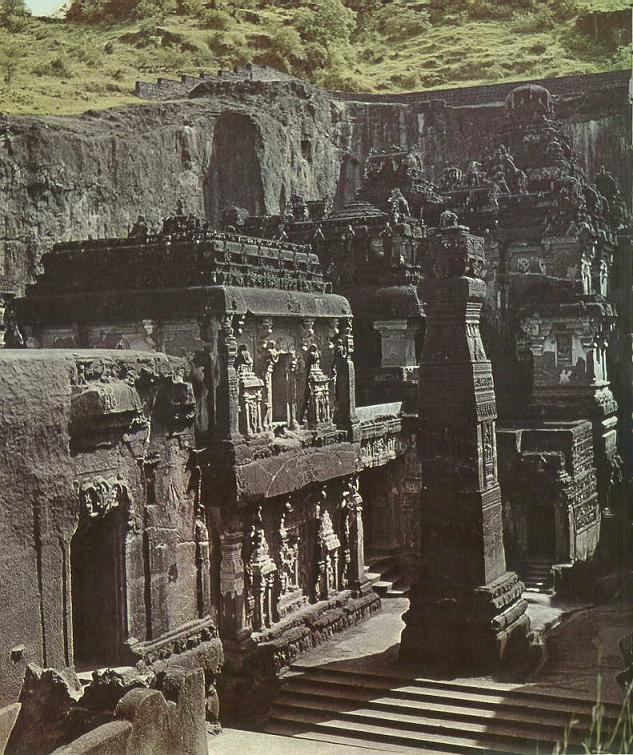
Kailashnath
temple at Ellora caves.
Every
Indian is an inheritor of that powerful ancient heritage that
attracts even the most modern-minded young person from every
corner of the globe in search of peace, spirituality and in
locating the real meaning of life and living.
Unfortunately, in India,
the very usage of terms like "Ancient Indian culture",
"Civilisation", "Vedanta",
"Sanskrit", etc., makes our Marxist
intellectuals squirm.
"Since
childhood, I was curious to know why there has been such a big
mismatch between our traditional knowledge and the formal
education system that portrays a perverse picture about our
history. Brainwashing young, impressionable Indian minds in the
name of modern science by the former colonists and their Indian
sycophants have coloured our education system and the media beyond
recognition. It has been to such an extent that we have almost a
negative impression of our rich heritage."
"Arrogance
and elitism are the hallmarks of the India's leftist intellectuals."
***
Growth
and evolution of cultures rarely follow linear paths. By the end
of the 20th century, it was clear to everyone that the colonial
era had damaged the cultural and educational context of hundreds
of nations who were materially exploited for centuries.
They
needed their own futuristic education systems in place of the
transplanted models forced upon them by their alien rulers.
UNESCO
now accepts that education in every country must be "rooted
to culture and committed progress". Unfortunately, in India,
the very usage of terms like "Ancient Indian culture",
"Civilisation", "Vedanta",
"Sanskrit", etc., makes our Marxist
intellectuals
squirm.
Character assassination, the most potent weapon in their armory, is thrown in to action: the canard of "Saffronisation".
It also must be realized that these people, now in power with Left
support, are becoming willing partners in the designs of their
supporters to cut off India's new generation from its glorious
heritage and legacy.
(source:
Education
shorn of values - By J
S Rajput - dailypioneer.com
February 25 06). Refer
to Dharampal:
Not
many know the Indian past he had discovered!
- By S Gurumurthy.
Watch
Ganapati
Om Kirtan - By Dave
Stringer.
Watch Kirtan
in Boulder, CO. USA. Refer
to Indian-American
scientists restore Hindu scriptures
and Space
Shuttle Astronaut Sunita Blasts off with Ganesha
and
The Bhagawad Gita
Top
of Page
Hindu
Intellectual’s Deep Sense of Inferiority Complex
Why is Indian Media shy of reflecting our achievements?
 "You cannot be proud
of a heritage you know nothing about, and in the name of
secularism, we have spent 50 years in total denial of the Hindu
roots of this civilisation. We have done nothing to change a
colonial system of mass education founded on the principle that
Indian civilisation had nothing to offer." "You cannot be proud
of a heritage you know nothing about, and in the name of
secularism, we have spent 50 years in total denial of the Hindu
roots of this civilisation. We have done nothing to change a
colonial system of mass education founded on the principle that
Indian civilisation had nothing to offer."
"As
for me I would like to state clearly that I believe that the
Indic religions have made much less trouble for the world than
the Semitic ones and that Hindu civilisation is something I am
very proud of."
-
writes
Indian columnist Tavleen
Singh - The
Indian Express June 13, 2004.
"The
desire of Indians to ingratiate themselves to the British is a
wonder to behold. Spies, masquerading as journalists and
academics, perfectly well-known to Indian intelligence, strut
about in the company of Indian government ministers, including
the prime Minister himself. They are lionised by the rich and
powerful in Indian cities and now leaven Indian film sequences
in shameless displays of white allure because they are
unspeakably desirable to many Indians. In private these same
white Europeans speak contemptuously of cloying Indians though
to true to form they never refuse the proverbial free lunch
thrust upon them by the same Indians. Be it noted that these
same irredeemable Indians have not the slightest compunction
insulting their own compatriots either because they misjudge
them to be inconsequential or merely because they are humble,
however honourable.
In the UK itself, Hindus are singularly obsessed with
professional advancement and making money. .
Once they attain these twin evil catalysts of pride the
abandonment of Godliness, they stop at nothing to be recognised
by the same white Europeans that regard them as mere irritants
at best. And elevation to a British peerage or knighthood,
though few of the illiterates can tell the difference even after
their own anointment, turns them in a trice into spies against
their community and the country of their ancestors. It is
impossible to join the House of Lords and remain an honourable
Indian in a society that cleverly divides non Europeans with
devious propaganda and by rewarding the few willing to
collaborate against their own."
- writes Dr. Gautam Sen who
taught at the London School of
Economics - The
Organiser
***
"The
word 'secularism'
has been so prostituted that it has ceased
to have any relevance. It has been reduced to mean
self-denigration. "
"India’s
worst enemies are not external they are us, ourselves."
***
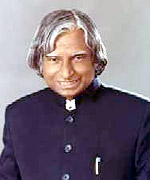 In
an address delivered in Hyderabad early in May, President
A. P. J. Kalam spoke about his three visions of India
and he felt that the points he raised were so important which
indeed they are that the paper he produced was put in general
circulation in the Internet. In
an address delivered in Hyderabad early in May, President
A. P. J. Kalam spoke about his three visions of India
and he felt that the points he raised were so important which
indeed they are that the paper he produced was put in general
circulation in the Internet.
The
first vision he envisaged was freedom. Freedom not just for
India but for everyone. He asked: “In 3,000 years of our
history, people from all over the world have come and invaded
us, captured our lands, conquered our minds, looted us and took
over what was ours.
Yet
we have not done this to any other nation. We have not conquered
anyone. We have not grabbed anyone’s land or tried to enforce
our way of life on them. Why?” His own answer to that question
was: Because we respect the freedom of others”.
The
inferiority complex we suffer from is colossal and this, even
after we have been an independent nation for six decades. The
British tried to destroy our respect for Sanskrit
and sought to dismiss Sanskrit as “a dead language”. (Refer
to chapter on Sanskrit).
When
under the BJP-led NDA government an effort was made to put
Sanskrit back on the school and college curricula, a hue and cry
was raised by none other than a decadent set of Hindu
intellectuals.

Lord Brahma -
Angkor wat 13th century.
Hindu intellectuals feel that to be known as a
liberal whatever that means one must deride Hinduism, Hindutva
and everything that is associated with them. How can a nation with a Hindu majority thrive, when
the majority itself is ashamed of its history, culture and
achievement?
Arrogance
and elitism are the hallmarks of the India's leftist
intellectuals.
***
For
them Hinduism itself was something to be ashamed of.
It was that
utter sense of self demeaning that gave birth to the war cry of
Hindutva and provoked the Mumbai-based Sena, for example, to
raise the slogan: Garv se kaho hum Hindu hai. (Say with Pride
that I am a Hindu).
Matters have come to such a
stage that our Hindu intellectuals feel that to be known as a
liberal whatever that means one must deride Hinduism,
Hindutva and everything that is
associated with them. How can a nation with a Hindu majority thrive, when
the majority itself is ashamed of its history, culture and
achievement? The achievements themselves, as Dr Kalam has
pointed out, are truly remarkable.
President
Kalam recalled how, when once he was in Tel
Aviv in Israel there was an attack from outside by
the Hamas resulting in a lot of deaths that was shocking.
“But” President recalled, “the front page of the newspaper
had the picture of a Jewish gentleman who in five years had
transformed his desert land into an orchid and a granary”.
Added
Dr Kalam: “It was this inspiring picture that everyone woke up
to. The gory details of killings, bombardments, deaths, were
inside, buried among other news”. Contrast this with what is
happening in India. Even as Dr Kalam was addressing a meeting in
Hyderabad, a handful of TV channels were trying their utmost to
trigger communal riots in Gujarat, if not the rest of India.
 As
Swapan Dasgupta, a former
editor of India Today,
writing in The Pioneer (7 May) noted, As
Swapan Dasgupta, a former
editor of India Today,
writing in The Pioneer (7 May) noted,
“it
was clear as daylight that the media was bent on stirring things
up” following the riots in Vadodara in the wake of a
demolition of a dargah dictated “by the imperatives of urban
renewal in this case, road widening”. Forgotten by the media
was the fact that at least ten Hindu shrines had also been
demolished in the city for the same reason.
As
Dasgupta put it: “To suggest that the roadside shrine should
have been left because it was so dear to local Muslims suggest
that there should be one rule for the aam admi and one rule for
minorities”. And the blame for the fury of Muslims was
automatically laid on Narendra Modi.
The
loathsome hatred of Modi is a reflection of the Hindu
intellectual’s deep sense of inferiority complex which he
makes no effort to overcome. The word `secularism’ has been so
prostituted that it has ceased to have any relevance. It has
been reduced to mean self-denigration.
India deserves inner self respect more
than external recognition. The first thing the Government should
do is to pull up the media especially the electronic media for
its utter misbehaviour and irresponsibility. India’s worst
enemies are not external they are us, ourselves.
(source: Why
is Indian Media shy of reflecting our achievements? - By M V
Kamath - samachar.com). Refer
to Timeless
universality - By V Sundaram - newstodaynet.com.
Refer to
chapters on First
Indolgists and European
Imperialism.
Watch the
Bloody
History of Communism
-
videogoogle.com.
***
What’s
nectar for secular US is toxin for secular India!
Saffron
Concepts?
 Just
a century ago, Max Weber
(1864 - 1920) political economists and sociologist, declared
that the Hindus and Buddhists remain backward because they
believed in their ancient, faulty faiths! Just
a century ago, Max Weber
(1864 - 1920) political economists and sociologist, declared
that the Hindus and Buddhists remain backward because they
believed in their ancient, faulty faiths!
Weber was a celebrated socio-economic thinker of the West. He
counselled that belief in Karma - in which, he believed,
fatalism hid - led people to accept their lot as their fate. He
thus saw the Hindu-Buddhist faith
in Karma as fatal to
development itself. He diagnosed that Karma-centric faiths,
which denied hopes to individuals, rendered their adherents
unfit for modern development process.
Indian intellectualism, particularly in
free India, carbon-copied Weber’s thesis and almost accepted
that the traditional Indian beliefs are the nemesis of India.
This turned the Indian establishment thinking apologetic about
not just ancient Indian faiths but about ancient India itself!
Under the pressure of Weber’s interpretation, some bright
Indian minds sidestepped the Aurobindo-Vivekananda
view on ancient India as world’s future hope. They took refuge
in socialist and secular ideas and delegitimised and drove the
ancient Indian ideas underground. This
enabled free India’s secular intellectualism, which saw
ancient Indian thoughts as its principal adversary, declare
everything about ancient India - whether it was Patanjali’s
Yoga or Krishna’s Gita – as
saffron toxic and anti-secular. In the end, Weber prevailed over
free India.
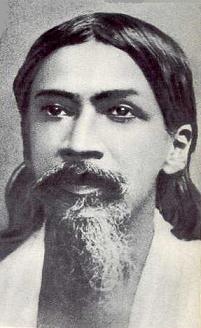
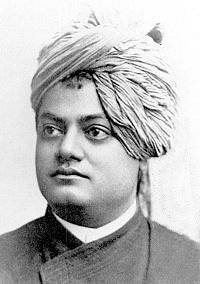
Sri Aurobindo
and Swami Vivekananda.
Under
the pressure of Weber’s interpretation, some bright Indian
minds sidestepped the Aurobindo-Vivekananda
view on ancient India as world’s future hope. This enabled
free India’s secular intellectualism, which saw ancient Indian
thoughts as its principal adversary, declare everything about
ancient India - whether it was Patanjali’s Yoga or Krishna’s
Gita – as saffron toxic and anti-secular. In the end, Weber
prevailed over free India.
For
secular India Bhagwat Gita and Karma Yoga are toxic substances
to be kept out of the Indian discourse.
That
is the measure of its hate for thoughts and things Indian. Yes
the secular India dismisses as toxin what secular America
realises as nectar.
Watch the Bloody
History of Communism
-
videogoogle.com.
***
Now comes, a full century after Weber theorised on how fatal is
Karma, a surprising U-turn in the West. The very idea of Karma,
which Weber had diagnosed as the nemesis of India, seems to be
emerging as the life vest of the West! The West, fatigued with
the ‘greed-is-good’ capitalism for over a century, is now
looking for an alternative to the greed-based capitalism.
International Business Week
in its recent issue (Oct 20, 2006) sees the emergence of ‘Karma
Capitalism’, that is, capitalism founded on the
idea of karma! The magazine defines karma capitalism as a
gentler, more emphatic ethos that resonates in the post-Enron
and post-technology bubble in the West.
“Big business is embracing Indian philosophy,” says the
“Business Week”. Look at what it sees as Indian philosophy.
“Phrases from ancient Hindu texts such as the Bhagwat
Gita are popping up in management tomes and on web
sites of consultants,” it says. And it goes on: “Top
business schools have introduced “self-mastery” classes that
use Indian methods to help managers boost their leadership
skills and find inner peace in lives dominated by work”.
Not only that. Bhagwat Gita, according to “Business Week”,
has replaced the 6th century BC Chinese classic Art of War of
Tsun Tsu, which dominated business schools two decades earlier.
The magazine says that while it used to be ‘hip in management
circles’ to quote from the Chinese classic, the ‘trendy
ancient Eastern text on Thursday is Bhagwat Gita”, which the
magazine says “more introspective”.
For secular India Bhagwat Gita and
Karma Yoga are toxic substances to be kept out of the Indian
discourse. The Indian management gurus and spiritual
leaders are doing what Swami Vivekananda did over a century ago
- namely proclaim that greatness of the Indian thought in the US
and import it from the US to India. They are actually validating
in the US what has been driven underground in secular India.
If
the Indian management gurus did something similar in India it
would attract the abuse of the seculars that they are toxifying
even business and economics with saffron
concepts! It may even charge that
the corporate America is becoming addicted to toxic saffron.
That is the measure of its hate for thoughts and things Indian.
Yes the secular India dismisses as toxin what secular America
realises as nectar.
(source:
What’s
nectar for secular US is toxin for secular India! - By S
Gurumurthy - newindpress.com).
***
Refer to A
'M K Hussain' of Tamilnadu: We hate Hinduism
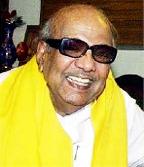 Chief
Minister M Karunanidhi Chief
Minister of Tamilnadu has failed to publicly
apologize for the 'vulgar remarks' he recently made against the
Hindu Gods and Deities. Chief
Minister M Karunanidhi Chief
Minister of Tamilnadu has failed to publicly
apologize for the 'vulgar remarks' he recently made against the
Hindu Gods and Deities.
There
is no doubt whatsoever that the Chief Minister of Tamilnadu is
well known for his Islam-embracing, Christianity-coveting and Hindu-hating
or Hindu-baiting stances and postures, often laced
with either malicious or ludicrous statements from time to time
during the past five decades.
(source:
A
'M K Hussain' of Tamilnadu: We hate Hinduism - By V Sundaram
- newstodaynet.com).
Top
of Page
Umberto
Eco speaks of "Rasa and Taste"
JNU
Gods and Priests Writhe
Arrogance
and elitism are the hallmarks of the India's leftist
intellectuals.
 The
JNU (Jawaharlal Nehru
University - Citadel of Indian
Marxism) high priests must have cursed the moment they decided to
invite Umberto Eco (1932
- ) novelist and philosopher, to speak. The
JNU (Jawaharlal Nehru
University - Citadel of Indian
Marxism) high priests must have cursed the moment they decided to
invite Umberto Eco (1932
- ) novelist and philosopher, to speak.
Says this report:
Celebrated
Italian author Umberto Eco left many academics and students at
Jawaharlal Nehru University squirming with embarrassed ignorance
on Monday.
Delivering
a lecture on " Rasa and Taste", Eco spoke with great
scholarly confidence and even greater scholarly tentativeness
about Bharata's Natyashastra, Anandavardhana
and Avinavagupta,
which he had read in translation but few in his audience seemed
to be acquainted with.
Few?
I daresay that almost none in the "red" audience
would've read about these Masters leave alone their works. For
it is taboo in the Citadel of Indian
Marxism. They're banned
there for their feudal, backward-looking ideas. Eco heaped
further agony on the crowd:
As
he constantly struggled, with a spirit of genuine inquiry, to
understand the rasa theories in relation to Western philosophers
- St Augustine, David Hume, Kant and Aristotle - many in Delhi's
academia looked as if they were completely at sea.
"You
would know, according to Abinavagupta, the ninth rasa is peace
and tranquility?"
He looked up to find mostly blank faces
staring at him in the audience.
If Prof Eco had only begun on
Marx and Engels…
No wonder no major newspaper has given his visit extensive
coverage.
(source:
JNU
Gods and Priests Writhe - www.sandeepweb.com
- October 25, 2005).
Top
of Page
Death throes
of Aryan Invasion theory?
People in north and south India belong to the same gene
pool: ICHR Chairman
Aryans
came here 15,000 years before the Common Era does not hold water.
Deoxyribonucleic acid (DNA) tests
of blood samples from people in the Indian subcontinent have
confirmed that the human race had its origins in Africa and not
Europe or Central Asia as claimed by a few historians.
The test has classified the
people in north and south India as belonging to one gene pool,
and not different ethnic groups such as Aryans and Dravidians.
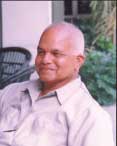 Giving
the information to The Hindu here, Chairman of the
Indian
Council of Historical Research D. N. Tripathi
said geneticists from Pakistan had collected samples for
genetics analysis of the people of Indian subcontinent and sent
them to cellular and molecular biology laboratories in the U.S.
Scientists in Pakistan concluded from the test results that the
human race spread out of Africa 60,000 years before Christ. They
settled in the subcontinent. Geneticists in Pakistan concluded
that people living in the northern and southern regions of India
and those in the West Asian region were from the same gene pool,
he added. Giving
the information to The Hindu here, Chairman of the
Indian
Council of Historical Research D. N. Tripathi
said geneticists from Pakistan had collected samples for
genetics analysis of the people of Indian subcontinent and sent
them to cellular and molecular biology laboratories in the U.S.
Scientists in Pakistan concluded from the test results that the
human race spread out of Africa 60,000 years before Christ. They
settled in the subcontinent. Geneticists in Pakistan concluded
that people living in the northern and southern regions of India
and those in the West Asian region were from the same gene pool,
he added.
Asked about the argument of many
historians tracing the lineage of people in north India to
Aryans, Prof. Tripathi said test results had proved this wrong.
"We have the results of studies.
The
conclusion of some historians that Aryans came here 15,000 years
before Christ does not hold water," he added.
(source: People
in north and south India belong to the same gene pool: ICHR
Chairman -
hindu.com). For more refer to chapter on Aryan
Invasion Theory and First
Indologists. Also refer to Indology
Researchers’ fan club - http://irffanclub.blogspot.com/
Top
of Page
Censorship of
Internet Websites?
Hypocrisy of India's UPA Government?
Hizbollah
web site acceptable; but not Hindu Human Rights?
The
'intelligentsia' in India are not worried. stands to reason,
because a lot of the English-language media's (ELM) hypocrisy is
being exposed on Blogs.
In Arjun
Singh
lexicon, Hindu
Human Rights =
Religious Extremism, but christist/mohammedan/marxist terrorism
= good. A very neat encapsulation of
UPA policy.
Now stand
by for an announcement of the Emergency, any day now.
Hizbollah
web site
acceptable; but not Hindu
Human Rights?
India
was
the first country in the world to ban The Satanic Verses by
Salman Rushdie. The book Understanding Islam through Hadis by
Ram Swarup was also banned. Several books of Bangladeshi writer
Taslima Nasrin have been banned in Bangladesh and West Bengal. Book
banning in India
There
have also been claims that the history of the Islamic invasion
of India is being systematically whitewashed and censored in
Indian school-books and in other media (e.g. Eminent
Historians - By Arun Shourie
1998). Refer to chapter on Islamic
Onslaught.
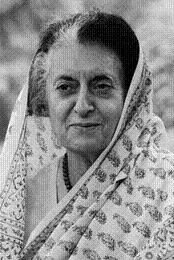 Refer
to Indira
Gandhi and Emergency - Indian democracy lay in
serious jeopardy in the summer of 1975 as Indira Gandhi's
Emergency destroyed the country's democratic framework. Twenty
years ago the Indian people voted decisively to defeat the hated
regime of Prime Minister Indira Gandhi which had clamped a state
of Emergency and sent democracy to jail. It is frightening even
to contemplate what would have happened if Indira Gandhi had
won. Refer
to Indira
Gandhi and Emergency - Indian democracy lay in
serious jeopardy in the summer of 1975 as Indira Gandhi's
Emergency destroyed the country's democratic framework. Twenty
years ago the Indian people voted decisively to defeat the hated
regime of Prime Minister Indira Gandhi which had clamped a state
of Emergency and sent democracy to jail. It is frightening even
to contemplate what would have happened if Indira Gandhi had
won.
The
Emergency would have continued, deepening public discontent and
leading to a violent confrontation between the government and
sections of the restive population. The Emergency, proclaimed on
June 26, 1975 had lasted 21 months. The
most shameful aspect of the Emergency was not its imposition but
the manner in which almost the whole country succumbed to it and
accepted it meekly. "Not a dog
barked," Indira Gandhi said later.
Sadly, this was true. Less
than half a dozen newspapers denounced the action. A
few judges and lawyers protested. As Soli
Sorabjee, an eminent constitutional expert and later
attorney general of India, noted that the performance of the
Supreme Court as a guardian of fundamental rights was deplorable
Also
refer to Internet
censorship in the People's Republic of China and
to Internet
censorship in Pakistan and
How to
Bypass Internet Censorship and
Censorship
in India, Also
refer to the chapter on Glimpses
XVIII for the Terrorism
in India - Mumbai Blasts 7/11.
(source: Internet
Censorship
and
Govt
cracks down on websites, blogs and
Hizbollah
web site acceptable; but not Hindu Human Rights?
Why
my website was banned in India
? - By Rusty Shackleford
Two days after the Mumbai bombings last week that killed more
than 180, the government of India issued a directive banning 17
websites. These websites were singled out because, according to
the Indian government, they might incite religious violence. The
nine American websites banned by India are all critical of the
Islamist movement. Not a single website of Islamic extremists
justifying and even celebrating the Mumbai bombings has been
banned.
Why
did India ban these websites? And what is the larger
meaning of this action? The short
answer to the first question is that we offended Islamists, and
India is afraid of its own Muslim citizens. The short answer to
the second question is that liberty may not be able to exist
where there are large populations of Muslims.
A nation cannot truly have freedom
of religion if that religion is immune from public
criticism. A nation cannot truly have freedom
of speech if blasphemy becomes a criminal act.
India is said to be a secular
state with aspirations of greatness. Its recent
actions show that it is neither completely secular nor ready for
its proper place on the world stage. This is all doubly sad
because India is also a natural ally against the cancer of
Islamic fundamentalism.
It is India,
not the U.S., which has bloody borders with Islam. Mumbai should
be a reminder to India who its real friends are and who are its
enemies.
The move towards religious
censorship by India is a mistake. A nation does not cement its
alliances by adopting the values of its enemies and rejecting
those of its allies. Despite this slap in the face by India, I
will continue to wish her continued progress and prosperity. A
wealthy India is an India better able to stave off the attacks
of the barbarians who are our common enemies at her gates.
India may have turned its back on
us, but we should not be so petty as to completely turn our
backs on her.
(source: Why
my website was banned in India
- By Rusty Shackleford - worldnetdaily.com).
***
Hindu
Website Ban Backfires. More People Log in
On
July 18th, the Indian Government banned www.hinduhumanrights.org
along with a few other websites. Ostensibly, the reason to
block access to Hinduhumanrights.org
was that it could cause religious disharmony and civil
disturbances in India.
The
real reason may be the websites differences of opinion with some
Indian academics in UK with close links to the current Indian
Government.
The
ban has actually backfired. The Indian State does
not have the resources to implement such a ban which is
practically impossible on the internet. Thousand of more
people logged in to the website to see what the fuss was all
about, giving Hinduhumanrights a big boost. Natural justice
processes were not followed – one morning the people running
the website woke up to hear it had been banned. Techgoss
checked out the website for the first time yesterday and found
that except for a few graphic photos, there was nothing
which could justify a blanket ban by a liberal democracy like
India which takes great pride in respecting all opinions. Like
it or not, some of the causes taken up by this
organization have been quite popular with the general Hindu
population in Europe and USA.
(source:
Hindu
Website Ban Backfires. More People Log in - By Ratna
Singh
- techgoss.com). Refer
to World Conquering
Creeds in chapter Glimpses XVI.
Top
of Page
The
centre of east and west
 Speaking
to Rainer Kellers, a German journalist on a short stint with
this newspaper, was edifying. He was pleasantly surprised to see
that Indians, even after letting in the winds of globalisation,
had not lost their strong cultural moorings - something that
wasn't true of many other places he had seen even in his own
native Germany. This, when we often hear the lament amongst
ourselves that we are in danger of getting knocked off by
Americanism; or that the rate at which our urban youth is
changing, our culture will soon get subsumed by a new identity
that will be wholly alien to what we were till recently. Such
backsliding logic beats me because the indications are rather to
the contrary. There is an increasing interest in the West about
India and if one were to take note of its trajectory, this
appeal has only been intensifying. Speaking
to Rainer Kellers, a German journalist on a short stint with
this newspaper, was edifying. He was pleasantly surprised to see
that Indians, even after letting in the winds of globalisation,
had not lost their strong cultural moorings - something that
wasn't true of many other places he had seen even in his own
native Germany. This, when we often hear the lament amongst
ourselves that we are in danger of getting knocked off by
Americanism; or that the rate at which our urban youth is
changing, our culture will soon get subsumed by a new identity
that will be wholly alien to what we were till recently. Such
backsliding logic beats me because the indications are rather to
the contrary. There is an increasing interest in the West about
India and if one were to take note of its trajectory, this
appeal has only been intensifying.
However,
that is an acceptance of India on the world stage at a more
general level. For, classical India with its music, yoga and
astrology - together constituting the "mystic package"
- has always found "converts" to Hinduism in the West.
This is true to such an amazing extent that I often find a
greater - and more refined - understanding of India in
westerners than many of us at home. To many people in the West,
India answers their academic and spiritual quests to a higher
degree and with far better results than their own
socio-religious and philosophical contexts.

For, classical India with its music, yoga and
astrology - together constituting the "mystic package"
- has always found "converts" to Hinduism in the West.
Watch
Ganapati
Om Kirtan - By Dave
Stringer.
Watch Kirtan
in Boulder, CO. USA.
***
This
search had brought Rainer Kellers to India twice before. As a
back-packing trekkie, he discovered the quieter, gentler side of
India. In fact he reminded me of another German I had met three
years ago at Rishikesh who held similar appreciation of India.
From my notes of that period, I recall he was Peter
Meir, a
chartered accountant from Bremen in his mid-50s.
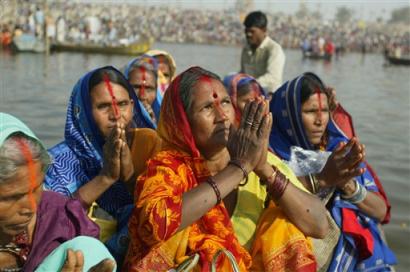
worshippers at
Magh mela
"Most
of the places in my country have become monstrously ugly.
Concrete forests populated by automatons. When I come to
Rishikesh, I realise there isn't a single place in my country
that connects us with our past in the same way. There is no
inhabited place in Germany where time has stopped." Meir
and Kellers are both among a growing tribe of Westerners who,
given a chance, could reacquaint Indians with India. But there
are others as well, who do so in even more profound ways.
(source:
The
centre of east and west - Gautam
Siddharth
-
dailypioneer.com May 1 2005). Watch
An
Invasion through Conversion
- videoyahoo.com
Top
of Page
Mahabharata
in Chinese sold out, goes into second edition
"There
is a growing desire in China to learn about India's culture and
traditions."
"For
a long time, Chinese scholars paid too much attention to the
West. Now, there is a growing desire to know Indian
civilisation and imbibe its wisdom," Huang
Baosheng, who headed the five-member team of
translators at Beijing University.
"The 5,000 sets released in the first edition were bought
not just by libraries as happens m the case of most such works
- but also by ordinary readers," Huang, who is a teacher at
the university's Sanskrit
department,
said. The sets are moderately priced at 680 yuan (Rs 3,862)
each.

There
is a growing desire in China to learn about India's culture and
traditions. The
Mahabharata
in Chinese sold out, goes into second edition.
***
Huang and his team worked for over 10 years translating the epic
from the Sanskrit edition brought out by the Bhandarkar
Oriental Research Institute in Pune. The
institute's version, Huang said, is the best of the epic in
Sanskrit.
"The Chinese version has more than 30 illustrations taken
from the original. The work has been appreciated by scholars
around the world, including those from Harvard, who recently
visited us in Beijing." The
Mahabharata's version comes several years after
the Ramayana was translated into Chinese. Ji Xianlin, a Sanskrit
scholar, secretly translated the epic in 1976. Huang and most
Sanskrit scholars in China are students of the 95-year-old Ji,
who is now in hospital near the university. The other scholars
involved in the Mahabharata project are Huang's wife Guo Liang
Yun, and Ge Weijun, Li Nan and Duan Qin.
(source: Mahabharata
in Chinese sold out, goes into second edition - By Saibal
Dasgupta - timesofindia.com November 22, 2006).
Refer
to chapter on Hindu
Scriptures and India
and China.
Top
of Page
Idea of INDIA Under Assault
UPA Government Communalizing
Vande Mataram ?
"
India
’s leaders are too secular to even fight for the survival of
their nation. They would rather witness the end of their civilization
and escape with a green card to
America
to join their children. "
-
Dr.Gautam Sen
***
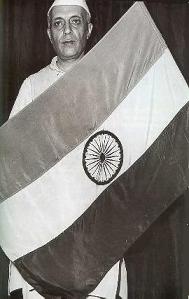 Jawaharlal Nehru
(1889-1964) first prime minister of free
India, the archangel of our secularists, wrote: Jawaharlal Nehru
(1889-1964) first prime minister of free
India, the archangel of our secularists, wrote:
"Vande Mataram is obviously and indisputably the
premier national song of India, with a great historical
tradition, and intimately connected with our struggle for
freedom. That position it is bound to retain and no other song
can displace it. It represents the position and poignancy of
that struggle."
Mahatma
Gandhi, too, saw Vande Mataram as the most powerful
anti-imperialistic battle cry and had declared that he
associated the purest nationalist spirit with it.
***
Ode
to Motherland
Vande Matram
- the first expression of Indian Nationhood.
"I bow
to you, my mother"
Vande maataram
Sujalaam suphalaam malayaja shiitalaam
Sasyashyaamalaam maataram
Shubhrajyotsnaa pulakitayaaminiim
Pullakusumita drumadala shobhiniim
Suhaasiniim sumadhura bhaashhiniim
Sukhadaam varadaam maataram
Koti koti kantha kalakalaninaada karaale
Dwisapta koti bhujaidhrat kharakaravaale
Abalaa keno maa eto bale
Bahubaladhaariniim namaami taariniim
Ripudalavaariniim Maataram
Tumi vidyaa tumi dharma
Tumi hridi tumi marma
Tvam hi praanaah shariire
Baahute tumi maa shakti
Hridaye tumi maa bhakti
Tomaara i pratimaa gadi
Mandire mandire
Tvam hi Durgaa dashapraharanadhaarinii
Kamalaa kamaladala vihaarinii
Vaanii vidyaadaayinii namaami tvaam
Namaami kamalaam amalaam atulaam
Sujalaam suphalaam
Maataram
Vande Mataram
Shyaamalaam saralaam susmitaam bhuushhitaam
Dharaniim bharaniim Maataram
***
 Bankim
Chandra Chatterjee (1838
- 1894) wrote the lyrics of Vande
Mataram, or at least the first two stanzas of the
song, much before he penned Anandamath, his novel celebrating
the sanyasi uprising against the tyrannical rule of Bengal's
Muslim subedars. The original version was written sometime in
the early 1870s - probably 1875 - and was later expanded into
its full version and incorporated in Anandamath in 1881. Bankim
Chandra Chatterjee (1838
- 1894) wrote the lyrics of Vande
Mataram, or at least the first two stanzas of the
song, much before he penned Anandamath, his novel celebrating
the sanyasi uprising against the tyrannical rule of Bengal's
Muslim subedars. The original version was written sometime in
the early 1870s - probably 1875 - and was later expanded into
its full version and incorporated in Anandamath in 1881.
Much later, when Vande Mataram became the rallying cry of
India's freedom movement, after it was set to music by Gurudev
Rabindranath Tagore and adopted as the National Song
at the Varanasi session of the Congress on September 7, 1905 (it
was accorded this status, bringing it at par with the National
Anthem, officially by the Constituent Assembly on January 24,
1950), leaders of what was then incipient Muslim separatism
began to raise the bogey that Bankim Chandra Chatterjee's
creation was "idolatrous" and, therefore, unIslamic.
In time, this became, and continues to remain, the chant of
those sections of the clergy and community who remain hopeful of
setting the clock back by 150 years, if not more, when much if
not all of India was ruled through firmans issued from the
masnad of Delhi, more specifically Lal Qila. In Hyderabad,
Maulana Syed Shah Badruddin Qadri, president of the Sunni Ulema
Board, issued a fatwa, instructing Muslims not to sing the
National Song and added that Muslims should not send their
children to schools where Vande Mataram is sung. In Allahabad,
India's all-weather Islamist and Shahi Imam of Delhi's Jama
Masjid Syed Ahmed Bukhari turned apoplectic with rage and
described any attempt to make Muslims sing the National Song as
"oppression of Muslims".
Such resistance and refusal has been registered by the
ulema earlier too. Maulana Abul Hasan Ali Nadvi, aka Ali Mian,
who, while he was alive, came to represent theological
fanaticism and practised it with unabashed gusto as chairman of
the All-India Muslim Personal Law Board, often raved and ranted
against Vande Mataram while rubbishing all suggestions that the
National Song defines the idea of Indian nationhood as something
sacred and divine. Nor is it surprising that the same Ali Mian,
in his stirring address to a gathering of Indian and Pakistani
Muslims in Jeddah on April 3, 1986, should have exulted,
"Cow slaughter in India is a great Islamic practice, (said)
Mujadid Alaf Saani II. This was his farsightedness that he
described cow slaughter in India as a great Islamic practice. It
may not be so in other places. But it is definitely a great
Islamic act in India because the cow is worshipped in
India."

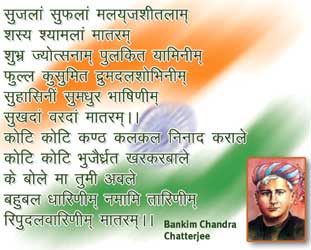
Bharat
Mata: Mother India - By Abanindranath Tagore and Bankim Chandra
Chatterjee who composed Vante Mataram.
(source: Indian
Art - By Vidya Dehejia).
The soft if not servile attitude of the UPA Government,
Marxist dominated media, left-minded social activists and
'liberal' Muslim scholars towards the on going controversy has
only strengthened the Muslim communalists. Insult to National
Song is not only an insult to the nation but it is the replay of
the same pre-partition divisive politics of All India Muslim
League.
***
 Hence
the renewed rage against Vande Mataram because it symbolises the
motherland India worships; it must be profaned because we
associate with the "ode to the motherland", to
quote Mohandas Karamchand Gandhi, "the purest national
spirit"; it must be denigrated because, as Bipin
Chandra Pal (a "terrorist" in the present
UPA regime's jaundiced eyes) put it, "The new nationalism
which Vande Mataram reveals is not a mere civic or economic or
political ideal. It is a religion." It is this religion of
nationalism and patriotism, and not merely India's National
Song, which is once again under attack from those who hawk
Islamic revanchism and preach bigotry and separatism in the
guise of protecting the identity of India's Muslims. Hence
the renewed rage against Vande Mataram because it symbolises the
motherland India worships; it must be profaned because we
associate with the "ode to the motherland", to
quote Mohandas Karamchand Gandhi, "the purest national
spirit"; it must be denigrated because, as Bipin
Chandra Pal (a "terrorist" in the present
UPA regime's jaundiced eyes) put it, "The new nationalism
which Vande Mataram reveals is not a mere civic or economic or
political ideal. It is a religion." It is this religion of
nationalism and patriotism, and not merely India's National
Song, which is once again under attack from those who hawk
Islamic revanchism and preach bigotry and separatism in the
guise of protecting the identity of India's Muslims.
Before independence, the Congress
sacrificed the cultural and civilisational content of Vande
Mataram, which even in its truncated form is nothing but a
hymnal tribute to an idyllic Mother India, on the altar of the
Muslim League's separatist politics. We see a similar
capitulation today with the Congress declaring, in response to
the ulema's rant against Vande Mataram, that it is not
compulsory to sing the National Song. Soon, it will be the turn of the National Anthem, and then the idea
of India as a nation and a nation-state. No price, it would
seem, is too high to pay in order to keep the ulema
in good humour.
***
The ongoing controversy over Vande Mataram is an insult to
our freedom movement and the nation as a whole. History is
replete with instances when the song enthused our freedom
fighters besides providing a common ground for equality of
religions in our national life.
 Composed by Bankim Chandra
Chatterjee in 1876, the song was incorporated in the
novel, Anandamath, in 1882. The first occasion when it was sung
was at the Calcutta session of the Indian National Congress in
1896. Rahamatullah M Sayani, president of that session, was not
only a leading advocate, but also the secretary of
Anjuman-i-Islam. Rabindranath Tagore
composed the music of Vande Mataram for that historic session. Composed by Bankim Chandra
Chatterjee in 1876, the song was incorporated in the
novel, Anandamath, in 1882. The first occasion when it was sung
was at the Calcutta session of the Indian National Congress in
1896. Rahamatullah M Sayani, president of that session, was not
only a leading advocate, but also the secretary of
Anjuman-i-Islam. Rabindranath Tagore
composed the music of Vande Mataram for that historic session.
During the partition of Bengal in 1905, the Bengal
provincial conference of the year was held in Muslim-dominated
Barisal (now in Bangladesh) in August. A leading Muslim presided
over the conference and Vande Mataram was sung there. After the
conference, the delegates marched in a procession through the
streets of Barisal, shouting Vande Mataram to protest the
partition of Bengal. Soon, it became a battle cry of Hindus and
Muslims alike. Then it was not considered a Hindu song, but a
slogan against imperialism and communalism.
Then came the 1906 Calcutta
session of the Indian National Congress. Dadabhai
Naoroji came from England to
preside over the session, which was heralded by Vande Mataram.
Vande Mataram is free from
regionalism, parochialism and communalism. It was the first
revolutionary song against foreign rule in India. Every Indian
should remember its historic importance, which reminds us of the
heroic deeds of our freedom fighters.
(source:
A Horst Wessel? - Op Ed dailypioneer.com
August 26, 2006 and National Song that
unites -
Sarat
Chandra Mallick Edit page august 24, 2006 –
dailypioneer.com
and Idea of INDIA Under Assault – By
Kanchan Gupta.
Refer to the chapter on European
Imperialism. Refer
to Confront
the anti-Hindus: The only way to rescue Hinduism
- By J.G. Arora. Refer
to Seizing
India
with some help from Hindus - by Dr. Gautam Sen
Madame
Cama and Vande Mataram
On August 22, 1907 Madame Bhikaji
Cama (1861 - 1936) and her band of exiled
revolutionaries hoisted the Indian flag at the International
Socialist Congress at Stuttgart in Germany. This flag
too had Vande Mataram inscribed on it.
Madame
Cama set up base in London. There, she became Dadabhai
Naoroji's private secretary. He was an important
Indian dignitary. Through him, Madame Cama allied herself with
many patriots and began speaking against British rule.
Madame Cama became so famous and
influential, the British concocted an assassination or murder
plot against her! When Madame Cama caught wind of
this plot, she secretly escaped across the English Channel to
France! She turned her French home into a secret hideaway for
revolutionaries worldwide. She made friends by sending pistols
disguised as Christmas gifts to Irish and Russian nationalists.
As the British saw her influence abroad increase, they begged
France to send her back to India. When the French government
refused, the English exiled her from her motherland and seized
her inheritance. Naturally, despite all British attempts to
disillusion Madame Cama, she continued championing her cause. In
1905, Madame Cama with other patriots, designed India's first
tricolour flag. The flag had green, saffron, and red stripes.
The top, green stripe had eight blooming lotuses representing
India's then eight provinces. ‘Vande
Mataram’ was written across the central, saffron stripe in
Hindi. On the bottom, red stripe, a half moon was on
the right and the rising sun on the left.
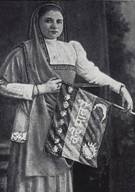

Madame
Cama, became private secretary to Dadabhai Naoroji designed
India's first tricolor flag with Vande Mataram on flag. Madame
Cama became so famous and influential, the British concocted an
assassination or murder plot against her!
For more refer to chapter on European
Imperialism.
***
Madame Cama's flag was smuggled into
India by socialist leader from Gujarat Indulal Yagnik and later
displayed in the library of Maratha
and Kesari (the publications started by Bal
Gangadhar Tilak) in Pune. The portrait of Madame Cama
displayed in Parliament has her holding this flag.

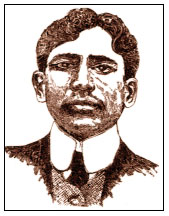
Lokmanya
Tilak and Madan Lal Dingra who assassinated Lord Curzon-Wyllie
and was hanged with cries of Vande Mataram on his lips.
Madame
Cama's flag was smuggled into India by socialist leader from
Gujarat Indulal Yagnik and later displayed in the library of
Maratha and Kesari (the publications started by Bal Gangadhar
Tilak) in Pune.
For
more refer to chapter on European
Imperialism.
***
The
song travelled across the seven seas and became the binding
factor for the Indian entity. In July 1909 Madan
Lal Dhingra
(1887
- 1909) assassinated an India
office bureaucrat Sir William Hutt
Curzon-Wyllie (lieutenant colonel in the Indian Army
and of the government of India foreign department, also served
in the Afghan War 1879
-1880)
in London and went to the scaffold with memorable enunciation of
an ode to Motherland:
"Neither
rich nor able, a poor son like myself can offer nothing but his
blood on the altar of Mother's deliverance... may I be reborn of
the same Mother and may I re-die in the same sacred way, till my
mission is done and she stands free for the good of humanity and
to the Glory of God." He
kissed the noose with cries of Vande Mataram.
Vande Mataram as the expression of Indian Nationhood, was
soon to travel to the Pacific coast of the United States of
America. By early 1920s a substantive colony of Punjabis had
come into existence, which faced extreme racial discrimination.
As protest to this, the famous Ghadr
Movement began in 1913 with Sohan Singh Bhakna as its
founder and later Lala Hardayal as its most famous leader.
(source:
Émigré Indians' ode to Motherland
- By
Sidharth
Mishra - Top stories dailypioneer.com
September 1, 2006 and Madame
Cama - deccanherald.com and Madame
Bhikaji Cama - Zorastrian
Association
of Victoria.
***
India: The siege within
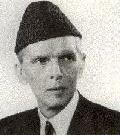 Senior
citizens who lived through the traumatic days of partition must
be feeling a sense of déjà vu when they hear Muslim clerics
launching a shrill attack on our National Song Vande Mataram, 56
years after India became a secular, democratic republic. They
know that in the past such arguments became the basis of
separatist demands. Senior
citizens who lived through the traumatic days of partition must
be feeling a sense of déjà vu when they hear Muslim clerics
launching a shrill attack on our National Song Vande Mataram, 56
years after India became a secular, democratic republic. They
know that in the past such arguments became the basis of
separatist demands.
While
the Muslim League
formally put forth the demand for partition, Mohammed
Ali Jinnah prepared the ground for
the vivisection of India three years earlier when he raised
objections to the singing of Vande Mataram, the tricolour which
we adopted as our National Flag and Hindi, our national
language. Jinnah told a party conference in Lucknow in 1937 that
the song, the tricolour and the language were all Hindu symbols,
which ought to be shunned by Muslims.
 Muslim clerics like Syed Abdullah
Bukhari, the Shahi Imam of Delhi's Jama Masjid, and Maulana
Khalid Rasheed who are now saying that Muslims cannot
sing Vande Mataram because it is "un-Islamic" are
therefore not saying anything new. Jinnah had said this before.
His discomfort with Vande Mataram, our National Flag and our
national language eventually culminated in the partition of
India. The Bukharis and the Rasheeds are the new voices of
discord. Emboldened by the pusillanimity of the Congress and the
prevarication of many of its leaders on issues pertaining to
national symbols and national pride, they have begun to gnaw at
the vitals of Indian nationalism. We need to stop them in their
tracks if we wish to remain secular, democratic and united. Muslim clerics like Syed Abdullah
Bukhari, the Shahi Imam of Delhi's Jama Masjid, and Maulana
Khalid Rasheed who are now saying that Muslims cannot
sing Vande Mataram because it is "un-Islamic" are
therefore not saying anything new. Jinnah had said this before.
His discomfort with Vande Mataram, our National Flag and our
national language eventually culminated in the partition of
India. The Bukharis and the Rasheeds are the new voices of
discord. Emboldened by the pusillanimity of the Congress and the
prevarication of many of its leaders on issues pertaining to
national symbols and national pride, they have begun to gnaw at
the vitals of Indian nationalism. We need to stop them in their
tracks if we wish to remain secular, democratic and united.
Vande Mataram has been sung at every session of the
Congress over the last 100 years and every session of our
Parliament ends on this patriotic and mellifluous note. We also
ushered in freedom with Vande Mataram when Sucheta Kripalani
sang it at 11 pm on the night of August 14, 1947, when the
Constituent Assembly met to formalise the transfer of power from
Britain to democratic India.
 Rajendra
Prasad settled the issue in regard to the
status of Vande Mataram in his statement before the Constituent
Assembly on January 24, 1950, just before the formal signing of
the Hindi and English versions of the Constitution by the
members. Prasad said: Rajendra
Prasad settled the issue in regard to the
status of Vande Mataram in his statement before the Constituent
Assembly on January 24, 1950, just before the formal signing of
the Hindi and English versions of the Constitution by the
members. Prasad said:
"The composition consisting of the
words and music known as Jana Gana Mana is the National Anthem
of India, subject to such alterations in the words as the
Government may authorise as occasion arises; and the song Vande
Mataram, which has played a historic part in the struggle for
Indian freedom, shall be honoured equally with Jana Gana Mana
and shall have equal status with it." The record of the
proceedings of that day says that the members
"applauded" Prasad's announcement.
Today, the Muslim population in India
has risen from 35 million in 1947 to over 150 million and though
blessed with a secular, democratic environment, all that the
community has to show is "leaders" like the Shahi
Imam, who are now attacking the symbols of our nationalism. They
are targeting Vande Mataram today. They will go after the
National Flag tomorrow. These are persons who do not fit into
modern, secular, democratic societies. We must coax them to
leave for "purer" Islamic pastures like the ones in
our neighbourhood because with them around we will be saddled
with the feeling "India khatre mein".
(source: India: The siege within -
By A Surya Prakash
- Edit dailypioneer.com August 29 2006). Refer
to chapter on Islamic
Onslaught and Islamic Terrorism in Mumbai -
chapter on Glimpses
XVIII. Refer
to Politics
of a Song - It’s
not about Vande Mataram. It is about vote banks
-
indiareacts.com and
Confront
the anti-Hindus: The only way to rescue Hinduism
- By J.G. Arora.
Refer
to Appeasement
of Minorities Destroying Hinduism
- By Dr. T Hanuman Chowdary.
***
UPA
Government Appeasing
Minorities?
Justice
KT Thomas Former Supreme Court Justice of India has
remarked:
 It
is quite an unnecessary move on the part of the Government to
lessen the importance of Vande Mataram (by making its singing
optional) as it is a song that has inspired millions during and
after our freedom struggle. The three songs, Vande Mataram, Jana
Gana Mana and Saare Jahan Se Achha have been weaved into the
national ethos of our country. It
is quite an unnecessary move on the part of the Government to
lessen the importance of Vande Mataram (by making its singing
optional) as it is a song that has inspired millions during and
after our freedom struggle. The three songs, Vande Mataram, Jana
Gana Mana and Saare Jahan Se Achha have been weaved into the
national ethos of our country.
Giving less importance to one as part of a move to
appease minority communities is not in good taste and is against
the secular fabric of our country. I still don't understand what
is objectionable about Vande Mataram.
It is unnecessary to deflect public attention from the real
message of the National Song (just because) ...religious
obscurantists cannot shift their vision towards a patriotic song
that has inspired millions of hearts. Theologians are twisting
some verses of the song out of context. In every song even
atheists will find religious elements. That should not be
encouraged. I am shocked to see such a controversy even erupting
over a patriotic song.
The content and the patriotic
fervour present in Vande Mataram are lucid and cloudless.
Therefore, I fail to understand why some people are creating an
issue out of it. A question that the dispute raises is: How
loyal is a person to the nation?
I strongly feel that the present
arguments against the singing of Vande Mataram are highly
objectionable and unwarranted. This is certainly not the way to
appease minorities. Nobody is asking anyone to sing the song or
bow before the song, but one should not forget history and the
role played by Vande Mataram in the national freedom struggle.
Every Indian should understand and spread the message of the
National Song rather than engage in such petty controversies.
(source:
Unnecessary
controversy
- By Justice
K T Thomas Top stories – August 28 2006
dailypioneer.com).
Communalization
of 'Vande Mataram': An avoidable controversy
Bankim Chandra Chattopadhyay composed Vande Mataram (Salute
to Motherland) song in 1870 for his historic novel Anandmath.
Later, this song became a vibrant chorus of the freedom movement
and also a battle cry against the British power. The
thundering slogan of 'Vande Mataram' thrilled the students and
youth of the country irrespective of their religious faith till
the Muslim League linked it with idolatry and called it an
insult to Islam.
After independence despite objections raised by some Muslim
leaders the constituent Assembly settled the issue and adopted
Vande Nataram and Jana gana mana Adhinayak jaya he Bharat Bhagya
Vidhata as National Song and National Anthem of India
respectively on January 24, 1950. National leaders like Dr.
Rajendra Prasad, Jawaharlal Nehru and others had fully endorsed
this decision and since then both the songs got constitutional
status. Any controversy over these two symbols of national unity
and integrity is therefore an insult to the constitution.
It is sad that the present
Government instead of taking action against the fanatics showing
disrespect to the National Song succumbed to the pressure of the
latter and made the singing of national song optional.
The soft if not servile attitude
of the UPA Government, Marxist dominated media, left-minded
social activists and 'liberal' Muslim scholars towards the on
going controversy has only strengthened the Muslim communalists.
Insult to National Song is not only an insult to the nation but
it is the replay of the same pre-partition divisive politics of
All India Muslim League.
(source:
Communalization
of 'Vande Mataram - An avoidable controversy - By
R.Upadhyay - saag.org).
***
This
song keeps us together- By Bharat Bala, producer of Vante
Mataram video
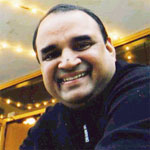 The
political brouhaha over (the singing of the National Song) Vande
Mataram is futile. People are giving vent to their
personal grouses and emotions in public and it's alarming to see
the extent to which some of them are going to politicise the
issue. It is a historical song and Indians have been singing it
for ages. Now, all of a sudden, a problem has been created. The
political brouhaha over (the singing of the National Song) Vande
Mataram is futile. People are giving vent to their
personal grouses and emotions in public and it's alarming to see
the extent to which some of them are going to politicise the
issue. It is a historical song and Indians have been singing it
for ages. Now, all of a sudden, a problem has been created.
Vande Mataram is such an
imaginative description of our country that every citizen can
relate to it, regardless of race, religion or caste. It
glorifies India and stands for its aesthetics that lies in
people's hearts and minds and must be left at that.
The song is
not about destabilising any faith. Through the years of our
freedom struggle the song served to unite us and
marked the sacrifice of every Indian martyr. In the 21st
Century, too, with its global cultural influences, this song can
keep us together.
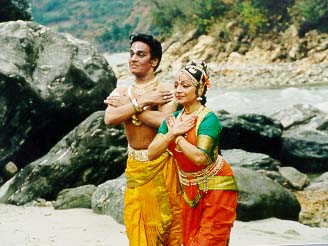
Vande
Mataram - Maa Tujhe Salam.
Through
the years of our freedom struggle the song served to unite us
and marked the sacrifice of every Indian martyr.
A
R Rahman, the symbol of today's Indian youth, gave it
the Gen-X touch. My primary motive was to re-present the
National Song so that every Indian child can be proud of his/her
nationality. Every Indian, regardless of his or her religion,
should be proud of our National Song. Anyone who delves deeper
into its lyrics will understand the true meaning of its sublime
poetry. Let's not be vulgar and disrespect our National Song.
(source: This song keeps us together - By
Bharat Bala - Top stories dailypioneer.com August 29
2006 and Vande
Mataram - rediff.com).
Refer
to the chapter on European
Imperialism
Top
of Page
'We have fallen on evil
days'
 No one except communalist
politicians will gain from the present controversy about the
song Vande Mataram. And no loss in the current course of events
is greater than the loss of that indefinable aura which usually
surrounds the National Song in every country. No one except communalist
politicians will gain from the present controversy about the
song Vande Mataram. And no loss in the current course of events
is greater than the loss of that indefinable aura which usually
surrounds the National Song in every country.
About a hundred years ago when
Rabindranath
Tagore, Aurobindo Ghosh (not yet the sage of
Pondicherry) and others ushered the song into the public sphere
from out of the pages of Bankim Chandra Chatterjee's novel
Anandamath, the song and the slogan Vande Mataram was decidedly
not read as a battle cry against another community. The song was
an evocation of the beauties of the motherland, shading off in
the latter part into a militant representation of what mother
might have been.
That did not worry the thousands who shouted the slogan for
decades all over India. It is indeed surprising how rapidly this
difficult text, written in Sanskrit and Bengali by Bankim
Chandra Chatterjee, was translated into other Indian languages.
Versions in Marathi and Kannada were available in 1897, in
Gujarati in 1901, in Hindi in 1906, in Telugu in 1907, in
Malayalam in 1909, and so forth.
The use of Sanskrit in the initial
verses of the song no doubt helped in the case of languages
derivative from Sanskrit, but in Tamil Nadu, too, the song was
translated by the great poet, Subrahmanya Bharati, first in 1905
for a periodical and later in 1908 when it was included in a
collection titled sapta koti. While the song was accessible only
to the educated, the words Vande Mataram entered the lexicon of
most Indian languages and common people shouted it as an act of
defiance or as a rallying cry.
From the beginning of the Swadeshi movement in 1905-07,
when Tagore personally led processions in Calcutta singing Vande
Mataram, for at least three decades the song held its own as the
first of the national songs then current. It is well-known from
the decade leading to the Partition of 1947 a communalist cast
of mind led to the rejection and denigration of the song - and
simultaneously on the other side there was a Hindu communalist
tendency towards the political appropriation of the song.
 One is reminded today of
Mahatma
Gandhi's words in Harijan
in July 1939: One is reminded today of
Mahatma
Gandhi's words in Harijan
in July 1939:
"... we have fallen on evil days. All that
was pure gold has become base metal today. In such times it is
wisdom not to market pure gold and let it be sold as base metal.
I would not risk a single quarrel over singing Vande Mataram at
a mixed gathering. It will never suffer from disuse. It is
enthroned in the heart of millions."
I read this as a
strident condemnation not only of communalism, but also of the
political instrumentalisation of the creative and intellectual
element in national life.
(source:
'We have fallen on evil days' - By Sabyasachi Bhattacharya
- August 31 2006 daily pioneer.com Top stories). Mr. Bhattacharya
is formerly professor at JNU and V-C at Visva-Bharati,
Santiniketan, is author of Vande Mataram: The biography of a
poem (Penguin, 2003). Refer
to the chapter on European
Imperialism
Top
of Page
Perversity
of Indian Secularism
Fatwa against singing Vande Mataram
With the new academic year set to start next week
and the admission process at its peak, several city--based
muftis issued a fatwa on Tuesday asking Muslims not to admit
their children in schools where Vande Mataram is sung every
morning. Children who are already studying in such institutions
must be immediately shifted to other schools, the fatwa ordered.

Vande Mataram was written by Bankim Chandra
Chatterjee (1838 - 1894). Among
those who approved the singing of Vande Mataram at the Nagpur
Congress was Mahatma Gandhi.
Mahatma
Gandhi, too, saw Vande Mataram as the most powerful
anti-imperialistic battle cry and had declared that he
associated the purest nationalist spirit with it.
Refer
to the chapter on European
Imperialism.
***
Muftis, including All--India Sunni Ulema Board
president Moulana Syed Shah Badruddin Qadri Aljeelani, Moulana
Mohammed Hasnuddin, Moulana Mohammed Mastan Ali, Nazima Aziz and
Rizwana Zarreen of Jamiat--ul--Mominath, jointly issued the
fatwa when some parents approached them seeking a shariah ruling
on Vande Mataram.
Several schools in the city start their day with a
recital of the national song. “Vande
Mataram was written by Bankim
Chandra Chatterjee (1838 - 1894).
It emphasises that Indians treat their land as God.
Ours is a secular country. Asking Muslims to do something like
this cannot be advocated,” Moulana Badruddin Qadri Aljeelani
told TOI after issuing the fatwa.
(source: Fatwa
against singing Vande Mataram - timesofindia.com).
Refer
to A
spectre haunting India
- economist.com
and Al-Qaeda
letter says Taj next target
- ibnlive.com.
Refer to
Islamic Terrorism in Mumbai - chapter on Glimpses
XVIII.
***
There's
nothing anti-Islamic in Vande Mataram - By Firoz
Bakht Ahmed (Educationist and grandnephew of Maulana Abul Kalam
Azad)
The melody, the thought content and the ambience
of patriotism of Vande Mataram is unmatchable.
As an Indian, I simply fail to understand as to why some of my
co-religionists are trying to make a religious issue out of
Vande Mataram that has a universal appeal for all Indians
irrespective of caste, creed and faith.
As a Muslim, I would like to
convey a message to all my countrymen and especially my own
community that some politically motivated people are trying to
make an emotive issue of Vande Mataram, gem of a song which in
my view should have been the national anthem in place of Jana
gana mana...
What is unfortunate is that clerics like the Shahi Imam
(of Jama Masjid), Maulana Khalid Rasheed Firangimahli and others
give Hindutva forces the handle to beat Muslims with. Why should
we fault VHP leaders for giving anti-Muslim statements when our
own clerics utter vitriolic things which give an impression that
Muslims are less patriotic than the Hindus?
The beautiful song got caught up with
the electoral calculations keeping in view the approaching UP
elections. The media
is also responsible for creating such an impression by
repeatedly giving publicity to speeches by these clerics who are
no more than bigots. It is because of irresponsible statements
made by these people that Muslims have to suffer.
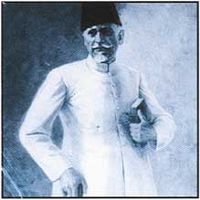
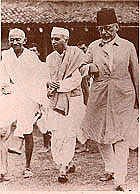
Maulana
Abul Kalam Azad and Mahatma Gandhi and Jawaharlal Nehru.
Then
how can singing Vande Mataram be un-Islamic? Moreover, the words
of Vande Mataram “Mother, I bow to thee! Rich with thy
hurrying streams, Bright with thy orchard gleams... Mother, to
thee I bow...”,
The
voices of secular, patriotic and liberal Muslims never get a
forum.
***
The
voices of secular, patriotic and liberal Muslims never get a
forum. We live in a liberal society where we are
encouraged to know about one another’s religion. Does a Hindu
become ‘ashuddh’ by going to Jama Masjid or a church?
Don’t the Muslim children going to Christian schools sing
psalms from the Bible in the morning assembly like “Our Father
which art in heaven, Hallowed be thy name”? Do they come back
home losing their faith?
Then how can singing Vande Mataram be
un-Islamic? Moreover, the words of Vande Mataram “Mother, I
bow to thee! Rich with thy hurrying streams, Bright with thy
orchard gleams... Mother, to thee I bow...”, found
to be objectionable to the clerics, have nothing of that kind as
we are not making ‘sijda’ (bow) before anyone except Allah.
Where’s the controversy except in the minds of the misguiding
fundamentalists?
Muslims must
follow the example of Maulana
Abul Kalam Azad, independent India’s first
education minister, who though born in a predominantly Hindu
environment, was bold enough to propagate nationalism to Muslims
at variance with the prevalent political consciousness based on
communalised politics while supporting the same with Islamic
sanction.
Maulana Azad saw in Vande Mataram the
fusion of the endogenic creativity, the Vedantic vision of many
parts of truth with the Islamic doctrines of Wahdat-e-Deen
(unity of religion) and Sulah-e-Kul (universal peace).
(source:
Don't colour Vande Mataram with religion - By
Firoz
Bakht Ahmed (Educationist and grandnephew of Maulana Abul Kalam
Azad
- dailypioneer.com August
25, 2006
and
There's
nothing anti-Islamic in Vande Mataram
-
By Firoz
Bakht Ahmed (Educationist and grandnephew of Maulana Abul Kalam
Azad
-
economictimes.indiatimes.com).
Top
of Page
Veda
will be chanted in US Senate
“I
am sure the report ’Hindu Prayer to open US senate Session’
(June 27), about the chanting of Rig Veda, Upanishads and
Bhagavad-Gita in the US Senate at its inaugural session on July
12 would have gladdened the hearts of millions of Hindus."
"Even though the majority of US
citizens are evangelists, its legislature has taken this
momentous step of honoring an ancient religion like Hinduism.
This is true secularism where all religions are respected.
Only in India
does secularism mean ‘anti-Hinduism’. For some so-called
secularist parties, Hindutva is a dirty word and any party that
advocates Indian tradition and culture is treated like a
political pariah”.
-
Rajalakshmi
Subramanian
from USA.
received
via email. Published by Times of India, New Delhi
in the column ‘My Times, My Voice’
Refer
to
Statement
from the Hindu American Foundation Celebrating Opening of the
U.S.
Senate With Hindu Prayer - HAF - "The Hindu
American Foundation joins all Hindu Americans in celebrating
yesterday's epochal events in our community's history in the
United States. Yesterday, the faith of 2
million American Hindus and nearly 1
billion of the world's population was represented in the
chambers of the U.S. Senate for the first time."
***
Washington
D.C. June 25, 2007: Rajan Zed, a Hindu chaplain living in
Nevada, is scheduled to give a Hindu prayer at the July 12 opening of
United States Senate in Washington
DC. It is believed this will be the first time any Hindu prayer
will have been delivered in the US Senate since its formation in
1789. According to US Senate website, "...Throughout the
years, the United States Senate has honored the historic
separation of Church and State, but not the separation of God
and State...During the past two hundred and seven years, all
sessions of the Senate have been opened with prayer, strongly
affirming the Senate's faith in God as Sovereign Lord of our
Nation..." Usually the Senate Chaplain delivers the opening
prayer, but sometimes guest chaplains are invited from all over
the country to read the prayer. According to a Senate Chaplain
Office communique, the purpose of the opening prayer is to seek
God on behalf of, and for the Senators and the prayer should
affirm our rich heritage as a Nation "under God".
(source: Veda
will be chanted in US Senate - Hinduism Today).
Intolerance
and Christian Fundamentalism in America?
Prayer War on the Hill: Hindu Invocation In Senate Reveals
Religious Right Rancor
 John Adams (1797 – 1801) Second President of the US
and a Unitarian, wrote to Thomas
Jefferson, December 25, 1813 describing Hinduism and
noting how it contains the same basic teachings as Christianity:
John Adams (1797 – 1801) Second President of the US
and a Unitarian, wrote to Thomas
Jefferson, December 25, 1813 describing Hinduism and
noting how it contains the same basic teachings as Christianity:
“Where
is to be found Theology more orthodox or Phylosophy more
profound than in the Introduction to the Shast[r]a
[a Hindu Treatise]? “God is one, creator of all,
Universal Sphere, without beginning, without End. God Governs
all the Creation by a General Providence, resulting from his
eternal designs — Search not the Essence and the nature of the
Eternal, who is one; Your research will be vain and
presumptuous. It is enough that, day by day, and night by night,
You adore his Power, his Wisdom and Goodness, in his Works.”
(source:
John
Adams - positiveliberty.com).
Refer
to Our
Founding Fathers were not Christians. Refer
to Top
Military Officials Endorsed Evangelizing In The Pentagon
and Evangelical Pentagon?-
Christian
Embassy video.
 Thomas
Jefferson (1743 - 1826)
was the third President of the United States
(1801–1809), the principal author of the Declaration of
Independence (1776), and one of the most influential Founding
Fathers
and the author of the concept that the
United States
should maintain a "wall of separation" in order to
avoid the development of a state religion of the sort that had
existed in the monarchies of
Europe, was a student of Hinduism. Thomas
Jefferson (1743 - 1826)
was the third President of the United States
(1801–1809), the principal author of the Declaration of
Independence (1776), and one of the most influential Founding
Fathers
and the author of the concept that the
United States
should maintain a "wall of separation" in order to
avoid the development of a state religion of the sort that had
existed in the monarchies of
Europe, was a student of Hinduism.
His
library included Hindu texts, and when he wrote the
Virginia Act for Religious Freedom, which laid the groundwork
for the Constitution protection of religious practice and
pluralism, he specifically avoided making reference to the
Christian faith -- though its adherents dominated the public
life of Virginia and other colonies -- because he wanted it to
be known that all religions, including Hinduism, were respected
and welcomed in the United States.
In
his notes on the
Virginia
statute,
Jefferson
specifically argued that Hinduism and other faiths would be
afforded the full protection and privileges of the act. Noting
the overwhelming rejection by Virginia legislators of an
amendment to his statute that proposed to insert a reference to
Jesus Christ, Jefferson found "proof that they (the
legislators who enacted the measure) meant to comprehend, within
the mantle of its protection, the Jew and the Gentile, the
Christian and the Mohammedan, the Hindoo and the (non-practicing
and disbelieving) infidel of every denomination."
Jefferson
's respect for religious pluralism in general, and Hinduism
in particular, led him to compare notes with other
founders of the American experiment. The third president and his
predecessor, John Adams corresponded at some length about their
respect for the teachings of the Hindu religion.
(source:
Sectarian
Extremists Versus
Jefferson - By John Nichols - thenation.com).
***
Heckling
on the Capitol Hill
Feeling Ashamed to be an American?
Our
nation’s Religious Right cabal carps constantly about a lack
of religion in the public square and promotes the wildly
misleading notion that the nation’s Founding Fathers
envisioned a government devoted to Christianity.
This
morning an incident unfolded in the U.S. Senate that provided a
glimpse of the nastiness that movement has wrought. Senate
Majority Leader Harry Reid (D-Nev.) had invited a
Hindu clergyperson to offer a prayer to open today’s session,
and it was disrupted by angry howls from a gaggle of Religious
Right protestors.


Senate
Majority Leader Harry Reid (D-Nev) a Mormon and Hindu chaplain Rajan
Zed.
Senate
Majority Leader Harry Reid (D-Nev) had invited a Hindu
clergyperson to offer a prayer to open today’s session, and it
was disrupted by angry howls from a gaggle of Religious
Right protestors. Reid
has commented on the event: “If people have any
misunderstanding about Indians and Hindus, all they have to do
is to think of Gandhi.”
Today was a historic first for religion in America
's civic life: For the very first time, a Hindu delivered the
morning invocation in the Senate chamber — only to find the
ceremony disrupted by three Christian right activists. Hindus
constitute only 4% of America's population.
Disgrace
on American Democracy and Pluralism? Shockingly,
far from being an isolated and spontaneous incident of hatred,
it is reported that a large number of well-organized
fundamentalist Christian groups throughout the nation had been clamoring
against allowing a Hindu priest to lead a prayer in our nation's
capital. The American Family Association has been on the
forefront of urging Christians to take direct action against
religious tolerance and asked their followers to contact the
Senate to ban a Hindu from leading prayer.
Christian Right
Activists Disrupt First Hindu Prayer In Senate: "This Is An
Abomination" American
Taliban? Intolerance
and Christian Fundamentalism. America
- Is it the Land of Philosophers like Emerson and
Thoreau or
Rabble rousers like that of
Pat Robertson, Jonathan
Falwell, Franklin Graham and Ann
Coulture?
***
As Rajan
Zed prepared to give his prayer,
one protestor shouted that what was about to occur was “an
abomination” and a woman protestor wailed something about the
nation only belonging to Christ.
Those
protestors, the news service reported, called themselves
“Christians and patriots” as they were being led from the
chamber.
Intolerant,
uninformed and rude are more fitting descriptors. But
Religious Right activists,
such as the American Family Association
and “Christian nation”
lobbyist David Barton, have
spent decades fomenting such behavior. Indeed, when they got
word of Reid’s invitation to Zed, they began prodding their
followers to deluge the Senate with complaints about the planned
prayer. The AFA’s news arm reported that Barton knocked
Hinduism as having few followers in America
and spouted drivel about prayer to a “non-monotheistic god”
as being un-American.
Pastor Rod Parsley, president of
the Columbus, Ohio-based Center
for Moral Clarity, said in an interview that Zed's
appearance reflects American diversity, and said he had no
objections.
"My opinion would be that
America
is the marketplace of ideas and that we should open our doors
and our hearts to those of differing religious persuasions than
ours, and in a free and open society allow points of views to be
heard as loudly and clearly as they can be made,"
he said.
As the
Rev. Barry W. Lynn, Americans United executive director, noted
to the AP, the disruption and complaints from the Religious
Right revealed their intolerance and the fact that the only
religion they want paraded around in the public square is their
own. Regarding the Religious Right’s claim that the nation’s
founders wanted a government devoted to God, one
should look at the work of James Madison, often dubbed
the “Father of the Constitution.”
The Religious Right has spent years working to re-write American
history, and they’ve unfortunately influenced some people and
inflamed others. The movement as today’s religious squabble in
the Senate chambers shows is a divisive one. It promotes
religious conformity, not religious liberty. Far removed from
the nation’s constitutional principles, the Religious Right
movement remains hostile to liberty for all.
(source:
Prayer
War on the Hill: Hindu Invocation In Senate Reveals Religious
Right Rancor and
Conservative
Christian Groups Protest Hindu Prayers in Senate).
Refer
to Christianity
has persistently fought against Pluralism and Victims
of Christian Faith and A
Christian jihad?
- By Khaled
Diab - guardian.co.uk and
Theocracywatch.org
and Dominionism
- religioustolerance.org. Refer
to When
Feds Forget Freedom of Faith (and the Fundies Who Love Them)
- By Tim Mitchell - crusadewatch.org. Watch
video - http://www.youtube.com/watch?v=EZ9To30Hz7A
Good ole Christian tolerance
?
Are
majority religions by the power of their numbers and economic
clout going to smother Vedic
religions?
It's
absurd but so typical of Christian extremists that they would
freak out at the imposition of a prayer that does not reflect
their beliefs — welcome to my world, guys. We learn from an
early age that the appropriate response is just to wait it out
and not participate … and that any protests have to be made at
an appropriate opportunity.
(source:
Good
ole Christian tolerance - By P Z Myers). Watch Rapture
Ready: The Christians United for
Israel
Tour
Watch
video. Refer
to Defaming
of Hinduism-I – By V Sundaram – newstodaynet.com and
Defaming
of Hinduism-II – By V Sundaram – newstodaynet.com. For
more on Christian Intolerance refer to chapters on
The
Goa Inquisition, European
Imperialism, Conversion,
and First
Indologists.
Hindu
Prayers and Christian Hegemony
Mind
you, when we criticize the fact that the Senate begins every
other day with a Christian prayer, we are accused of trying to
destroy religious freedom. When any other type of prayer is
offered, this magically has nothing at all to do with religious
freedom. Silly Hindus, don't you realize that only Christians
get to have the official government imprimatur upon their
religion? You just sit back and enjoy your cheeseburger and let
the Christians pray.
But wait, it gets better.
Three whackos from a religious right group called Operation
Save America decided to disrupt the Hindu
invocation and got hauled away by the police.
(source: Hindu
Prayers and Christian Hegemony
- By Ed Brayton).
Refer to US
Senate Opens With Hindu Prayer, Confuses David Barton
- talk2action.org.
Violated
by a false Hindu god? Gross Idolatry?
The
Senate was opened with a Hindu prayer placing the false god of
Hinduism on a level playing field with the One True God, Jesus
Christ. This
would never have been allowed by our Founding Fathers.
"Not one Senator had the backbone to stand as our Founding
Fathers stood. They stood on the Gospel of Jesus Christ! There
were three in the audience with the courage to stand and
proclaim, 'Thou shalt have no other gods before me.' They were
immediately removed from the chambers, arrested, and are in jail
now. God bless those who stand for Jesus as we know that He
stands for them." said Rev.
Flip Benham, Director, Operation
Save America/Operation Rescue.
He also
said it is emblematic of the modern tendency of
"other
religions being held on a par with Christianity. Of course, we
have said that is not true, that indeed Christianity is one
way."
(source:
Theology
Moved to the Senate and was Arrested - christiannewswire.com
and Head
Of Christian Right Group Calls Hindu Senate Invocation
"Gross Idolatry"). Watch
Rapture
Ready: The Christians United for
Israel
Tour
Watch
video. Also
refer to Christian
Right Up in Arms Over Hindu Chaplain's Prayer in
U.S.
Senate - jewsonfirst.org and Prayer
to Whom? – By Tom Perkins – Family Research Council.
Refer
to Our
Founding Fathers were not Christians.
'Christian'
Wahabbis rising in the West
Just
as the institution
of slavery
was incompatible with the teachings of Jesus Christ, so too is
the religious supremacist approach, demonstrated by the three
hecklers who sought to prevent a Hindu priest from opening the
July 12 session of the U.S. Senate by a prayer that called for
reflection on "the glory of the Supreme Deity, who is
inside the heart of the Earth, inside the life of the sky, and
inside the soul of Heaven." Rajan Zed of Nevada ended with
the traditional Hindu invocation: "Peace, peace,
peace." This
is hardly stuff that can be said to challenge the Christian
scriptures, but to the protestors, any "non-Christian
prayer" was sacrilegious, even one that celebrated the
unity of the divine.
These
days, fundamentalist groups that have misappropriated the term "Christian"
fund missions to India, where
preachers use language against local beliefs and deities that
is, to put it mildly, uncomplimentary. In
this, they are following in the path of the
"professors" at
Islamabad
's Red Mosque, who told their charges that Hindus were
"pigs" and Christians "dogs."
(source: 'Christian'
Wahabbis rising in the West
- By M D Nalapat - crusadewatch.org).
Refer to To
Rajan Zed’s Hecklers: Who Are You? What Are You? (Beatles
parody)
- dailykos.com. Also refer to The
Business of the Catholic Church – By Bill Maher - Huffingtonpost.
Was
the US Senate attack on Hinduism an isolated instance?
 The
denigration of Hinduism influences the way Americans relate to
Indians. Andrew
Rotter, an American historian, and professor
at Colgate University, in his book on the US foreign policy’s
tilt against India and towards Pakistan during the Nehru era,
cites declassified documents revealing US presidents’ and
diplomats’ suspicions of Hinduism. The
denigration of Hinduism influences the way Americans relate to
Indians. Andrew
Rotter, an American historian, and professor
at Colgate University, in his book on the US foreign policy’s
tilt against India and towards Pakistan during the Nehru era,
cites declassified documents revealing US presidents’ and
diplomats’ suspicions of Hinduism.
They
regarded “Hindu India” as lacking morality and integrity,
and its “grotesque images” reminded them of previous pagan
faiths conquered by Christians, such as Native Americans.
American ideas about
India
are intertwined with stereotypes about Hinduism.
(source: Was
the US Senate attack on Hinduism an isolated instance?
- By Rajiv Malhotra - usinpac.com).
Backhanded
or Genuine?
It
took America, a nation that supposedly prides itself on religious freedom
and diversity, over 200 years since its establishment to ask
someone from one of the largest non-Abrahamic faiths in the
world to give a prayer in both its House of Representatives and
Senate. This delayed invitation, in addition to
America
's ongoing support of evangelical Christian missionary efforts
in the Hindu homeland of
India, makes this inclusion of a Hindu chaplain feel more
backhanded than genuine, even if protestors hadn't been present.
Bible
class advocates argue that Christianity is part of America's
heritage, the indigenous tribal
religions that inhabited America before the arrival
of Europeans were not Christian at all and often faced
prejudicial treatment from the American government for their
non-Christian beliefs and practices. To follow the resulting
analogy: "Christianity" is to "Be American"
as "Traditional American Indian Religions" is to
"Not Be American"
(source: When
Feds Forget Freedom of Faith (and the Fundies Who Love Them)
- By Tim Mitchell - crusadewatch.org). Watch
Rapture
Ready: The Christians United for
Israel
Tour
Watch
video
Top
of Page
Secular
means anti-Indian
The
Washoe County Commission in the
US
observed Sanskrit Day on
January 12 and organised a two-day seminar to mark the occasion.
What could be more ironical than knowing that a Sanskrit seminar
was held on American soil while the mother of most Indian
languages, the dev bhasha (language of gods), is ignored in its
own country.
Sanskrit,
German scholar Max Müller had
observed, was the greatest language of the world. Mahatma
Gandhi had said that without the
knowledge of Sanskrit, nobody could become a truly learned man.
Only in
India
could such a language take shape and flourish. Unfortunately,
Government does not realise what a national treasure this
language is; this reminds one of the Sanskrit saying which means
"a monkey cannot value the gift of a necklace of
pearls".
This
cannot be a result of ignorance. It must be a part of the larger
conspiracy to eliminate Indian languages. Our present-day rulers
are doing with impunity what Lord Macaulay could only partly
achieve through his policies in the 19th century. His system of
education has now got a new name -- 'secular education'. It
seems it is now a sin to teach students the glory of ancient
India
.
Everything
non-Indian, even anti-Indian, is being taught in classroom in
order to give the curriculum a 'secular' look. If our textbooks
praise the Vedic period, the
descendants of Lord Macaulay raise a hue and cry. The
authors of the textbooks would rather heap praise on the Mughal
period in order to add a 'secular' colour to the books.
If
the 'secularists' find some tatsam (undistorted) words in Hindi
textbooks, they accuse it is 'saffronisation'
of Hindi. In order to make the Hindi books 'secular',
the language has to be replete with words of Arabic and Persian
origin.
The
mere mention of the word Ganesh, the lord of wisdom, in a
textbook of a south
Indian
State
, was so unbearable for the self-styled champions of secularism
in the country that the chapter had to be replaced by one on an
animal. But an entire opening chapter,
"Jisu mahan" (Jesus, the great), of a Government
textbook in a
North-Eastern
State
invites no resentment from any quarter.
(source:
Secular means anti-Indian
- By Indulata Das
Edit page dailypioneer Jan 22, 2008).
Top
of Page
UPA
Governments' Arjun
Singh's fatwa against things Hindu
Marxists denigrating India's Spiritual Foundation ?
(Note:
Communism
is dead - What
we are witnessing in
India
today is a conflict between living history and dead ideology. Their
present indignation represents the mortal thrashes of a faith
that is dead everywhere else in the world but flickers on with a
semblance of life in the immense scope for opportunism that
Indian politics provides. source: Ancient
Indian Logic - By Sunanda Dattaray
- telegraphindia.com).
 Soon
after becoming Human Resources
'Destruction' Minister, Arjun Singh took care to
carefully select men like Prof J S
Grewal and Prof Irfan Habib,
who have jointly authoured the medieval India section of the
Indian History Congress' notorious Index of Errors, which
spearheaded the Leftist attack on NCERT. Soon
after becoming Human Resources
'Destruction' Minister, Arjun Singh took care to
carefully select men like Prof J S
Grewal and Prof Irfan Habib,
who have jointly authoured the medieval India section of the
Indian History Congress' notorious Index of Errors, which
spearheaded the Leftist attack on NCERT.
These two historians
are to the Hindu 'refugees' of India what Hitler was to the Jews
of Germany. It is now widely known that Prof Habib met Arjun
Singh's committee, as did the activists of Sahmat, an
organisation that hosted the press conferences wherein Leftist
academics spat venom against NCERT.
As
Rajeev Srinivasan has stated
in this context: 'This, however, is what one expects:
"Each
nation and culture pumps up the valorous deeds of its people, as
part of its propaganda efforts, and to establish its greatness.
India, misled by sundry nattering nabobs of negativism, is the
only nation that does the opposite, namely downplaying the real
and brilliant achievements of its culture and civilisation and
its citizens. The stunning accomplishments of Indian
civilisation have been denigrated in a sustained campaign. With Nehruvian
Stalinists and Marxists
in power, this process has received fresh impetus'.
What
is the upshot of all this attempts at de-saffronisation of
history text books engineered by the HRD Minister Arjun Singh?
UPA, fully supported by the Marxists, Leninists and the
Nehruvian Stalinists rests on an effective denial of the
spiritual foundations of Indian civilisation and of its
original, sustained, varied contributions to the progress of
humanity. How our spiritual culture has had a great cementing
and unifying impact on the Indian masses is also passed over in
silence.
 What
is Arjun Singh's definition of de-saffronisation? What
is Arjun Singh's definition of de-saffronisation?
The
whole world would be shocked by the way in which Sri Ramakrishna
Paramahamsa has been introduced in a text book for children
officially produced by Arjun Singh's HRD Ministry through the
National Council for Educational Research and Training (NCERT).
The
non-communal, cosmopolitan and secular author of this book is
comrade Satish Deshpande.
He is part of Arjun Singh's crusade to detoxify the students
afflicted by the so-called 'saffronisation'.
He
has written in this book that 'Sri Ramakrishna was an illiterate
and mentally unbalanced person'. This blasphemous statement
cannot be casually dismissed as an individual's perversion but
driven by a Marxist philosophy of class hatred.
In
this context I have to refer to the great writings of Romain
Rolland (1866-1944) who was awarded the Nobel Prize
for Literature in 1915 for his famous novel 'Jean
Christophe'.
He
wrote the biography of Swami
Vivekananda in two volumes. In one of those volumes
he wrote how Sri Ramakrishna
Paramahamsa identified the genius and potential of
Swami Vivekananda as a spiritual leader of humanity:


Sri Ramakrishna
and Swami Vivekanada.
Sri
Ramakrishna was an illiterate and mentally unbalanced person'.
This blasphemous statement cannot be casually dismissed as an
individual's perversion but driven by a Marxist philosophy of
class hatred.
***
'Ramakrishna
Paramahamsa with his intuitive genius for souls, for whom time
was not, and who could discern in the twinkling of an eye the
whole flood of the future, believed that he had seen his great
disciple in the womb of the elect before he met him in the
flesh. I will give here an account of his beautiful vision. We
know that a mighty vision creates and produces that which it has
seen. In a deeper sense, the prophets of the hereafter have been
real characters of what was not yet, but which was trembling on
the verge of being. The torrent forming the remarkable destiny
of Vivekananda would have been lost in the bowels of the earth,
if Ramakrishna's glance had not, as with one blow of an axe,
split the rock barring its way, so that through the breach thus
made the river of his soul could flow'.
Unfortunately
for us comrade Satish Deshpande cold-bloodedly writes otherwise
about Sri Ramakrishna Paramahamsa. Arjun Singh and his Marxist
comrades would run down Romain Rolland
as 'communal' and uphold world-famous comrade Satish
Deshpande as 'secular' and transcendental(!) with the full
blessings and benediction of de jure Prime
Minister Dr Manmohan Singh and de facto Prime Minister 'Mother
Superior'.
Petty
men like our HRD Minister cannot silence Hindu voice for ages to
come. Hinduism has withstood the onslaught of external invaders
for more than 2000 years.
It
is capable of defending itself against all its internal
invaders, the torchbearers of pseudo-secularism, who are trying
to hold aloft the green flag of de-saffronisation.
(source:
Arjun
Singh's fatwa against things Hindu - By V Sundaram -
newstodaynet.com).
Refer
to A
spectre haunting India
- economist.com
and Al-Qaeda
letter says Taj next target
- ibnlive.com.
Refer
to Shameful
-
By
Dr. T Hanuman Chowdary
Top
of Page
Dark
Clouds Descend on India
Quota
system, Communist ruled states in India
Medical
students and practitioners have launched massive strikes and
protests in India lately. For a notion of what the fuss is
about, consider the following stories.
In
2005, the NY Times reported
that a patient undergoing routine cataract surgery in a hospital
within the ‘worker’s paradise’ of Communist
ruled West Bengal, India, died when ants ate her
eyeballs following the procedure. This ghastly incident is an
example of shoddy medical treatment offered in leftist and
Communist ruled states in India.
Amazingly,
India is routinely feted as having the best medical
professionals and facilities in the world. Time magazine devoted
many pages recently to medical tourism in Asia, and 60
Minutes last year profiled the tens of thousands of
American and British residents who fly annually to India and
receive the most complex treatment for bargain prices.
This
dichotomy is present in every sphere in India. The
private sector, a few select educational institutions like the
elite IITs and states like Gujarat, which emphasize merit over
quotas, prosper and provide the world’s highest caliber
doctors, engineers, and professionals of all stripes. By
contrast, populist leftist leaders like the former Laloo Yadav
who court Muslims and lower castes, have rendered infrastructure
and development in basket cases like Bihar state equivalent to
sub Saharan Africa.
India’s
economy provides ample merit based advancement opportunity for
all minorities.
The
wealthiest community in India is the Zoroastrian
minority, which fled Islamic
oppression in Iran for sanctuary in India. Jains
also enjoy higher than average incomes and enormous success. All
of these groups prospered without quotas or special
privileges.


UPA
Government: Human Resources
'Destruction' Minister, Casteist
divide and rule, Arjun
Singh and Roman Catholic Sonia Maino Gandhi.
The government is in the process of making caste the only
reality in India." The
Congress-led Indian government, which relies on a coalition with
Communist parties for support, will go down in history as the
most destructive regime to ever rule India.
Watch
the Bloody
History of Communism
-
videogoogle.com.
Where
do Arjun, Sonia's grandkids study?
The
Saudi media has heaped praise on the visiting
Union Minister for Human Resource and Development Arjun Singh,
describing him as a very ‘seasoned politician’ and an
‘icon (?) of Indian secularism’.
***
The
dark cloud which mars India has always been favoritism which
populist governments use to win votes from minorities, like
Muslims, and supposedly ‘underprivileged’ castes. The
‘caste system’ is a myth: employment
discrimination based on caste has not existed for decades.
Successive leftist regimes, in the all-consuming goal of
courting votes, falsely used the bogey of caste discrimination
to impose ridiculous quotas for ‘backward castes’ in public
universities and government employment. Currently, quotas range
from 22.5% in federal institutions to as high as 60% in states
such as Tamil Nadu.
The
current leftist federal government, keen on currying minority
votes, will reverse this progress by increasing quotas by
another 27% in universities and public firms. This additional
reservation will increase the quota in federal government
institutions to 50% and will result in obscene levels in some
states such as Tamil Nadu, where up to 87% of seats will be
reserved for the "so called" lower castes. These
ruinous quotas may be extended to private sector firms later.
This constitutes the beginning slide which will lead to the
destruction of India’s economic miracle, and wiping out
billions of dollars of foreign investment in India.
This
issue is not just a domestic Indian affair: as the intellectual
economies of the West and India have become entwined, we have a
vested interest in ensuring that the excellence in products and
services that our economies need continues to be developed.
Every major American firm, especially in technology, today is
critically dependent on Indian talent to provide cutting edge
design and innovation, not just low-end services.
Destruction
of the Indian jewel will drag down the entire global economy
along with India, and considerably weaken American
competitiveness and innovation, especially compared to China.
The Congress-led Indian government,
which relies on a coalition with Communist
parties for support, will go down
in history as the most destructive regime to ever rule India.
(source:
Dark
Clouds Descend on India - By Ron Banerjee -
canadafreepress.com)
Refer
to Anti-Brahmanism
should stop!
- By Francois Gautier - rediff.com).
Refer
to A
spectre haunting India
- economist.com
and Al-Qaeda
letter says Taj next target
- ibnlive.com.
Quotas
- they're just Marie Antoinette solutions'
 Andre
Béteille (1934 - ) is appalled by the
recent quota announcements as a potentially damaging
interference in caste relations that were of their own showing-
signs of positive -alteration. His resignation
from the National Knowledge Commission this month
is a stance backed by decades of consistency. Andre
Béteille (1934 - ) is appalled by the
recent quota announcements as a potentially damaging
interference in caste relations that were of their own showing-
signs of positive -alteration. His resignation
from the National Knowledge Commission this month
is a stance backed by decades of consistency.
"I
have been a skeptic, not an opponent but a skeptic of
reservations," he says.
"We
go on creating rights which cannot be enforced and which are
probably unenforceable," he says. "I call it the Marie
Antoinette solution. They don't have schools so give them
rights.
Why do you only allow these
children abysmal schooling and then think you can make up for it
by quotas in the IIT's?"
(source: Quotas
- they're just Marie Antoinette solutions' - By Shyama
Halder - tehelka.com).
Top
of Page
Caste-based reservation is
‘Operation Destroy India’
First,
may one point out to a paragraph in a circular to the presidents
of all Pradesh Congress Committees issued by none else than Jawaharlal
Nehru, on May 26, 1954?
That
paragraph said: "In particular, we
must fight whole-heartedly against those narrow divisions which
have grown up in our country in the name of caste, which weaken
the unity, solidarity and progress of the country...."
When
the British Government sought to give separate electorates to
the Scheduled Castes, Mahatma Gandhi went
on a hunger strike that is old history
now, which ended in the Poona Pact in
1932.
Some
seven and a half decades later, on September 6, 1990 Rajiv
Gandhi made a similar, though not as sensational,
effort to promote national unity in a speech in parliament
criticising the Mandal Report,
lasting, to his eternal credit, some two and a half hours. Rajiv
Gandhi, like the Mahatma before him, was not opposed to enabling
the Scheduled Castes, make progress in all fields.
Addressing
the Lok Sabha he said: "If you believe in a casteless
society, every major step you take must be such that you move
towards a casteless society. And you must avoid taking any step
which takes you to a caste-ridden society.
”Unfortunately,
the step that we are taking today (accepting the Mandal Report),
the manner in which it has been put, is a casteist formula.
While accepting that is a reality, we must dilute that formula
and break that formula by adding something on to it".



Jawaharlal
Nehru, Rajiv Gandhi and Mahatma Gandhi all were against dividing
the nation in the name of caste.
Nehru wrote: "In
particular, we must fight whole-heartedly against those narrow
divisions which have grown up in our country in the name of
caste, which weaken the unity, solidarity and progress of the
country...."
Rajiv
Gandhi wrote in 1990: "Even now there
is time to pull the country back from this caste
division…Ministers are provoking caste wars".
When
the British Government sought to give separate electorates to
the Scheduled Castes, Mahatma Gandhi went on a hunger strike
that is old history now, which ended in the Poona Pact in
1932.
***
 Attacking
the then Prime Minister V P Singh whom he charged with not
having the guts to stand up and say whether he believes in a
casteless society or not, Rajiv Gandhi said: "This
government is creating a vested interest in casteism and the
country is going to pay a very high price for it". Attacking
the then Prime Minister V P Singh whom he charged with not
having the guts to stand up and say whether he believes in a
casteless society or not, Rajiv Gandhi said: "This
government is creating a vested interest in casteism and the
country is going to pay a very high price for it".
An
angry Rajiv Gandhi shot out: "Does the government subscribe
to the Mandal Commission view that political constituencies
should be carved out on a caste basis? Are we going back to the
Round Table Conference for having separate electorates? That was
designed to break our country, Sir".
Warming
up in his address, Rajiv Gandhi said that "even at this
late hour (and this was in 1990) there
is time to pull the country back from this caste
division…Ministers are provoking caste wars".
Continuing,
he said: "The Raja Saheb's (V P Singh's) statement
doesn’t command wide acceptance in the country. They (the
Ministers) have weakened our national fabric and to add to that,
the Central Government, the Ministers, have deliberately
provoked the caste confrontation and caste wars....".
Rajiv
Gandhi said that "an issue like reservation cannot be
treated in a piecemeal manner. We must look at the whole
picture." He quoted Mandal himself who had said that
"the aim is to overcome historical and geographical
handicaps, not to create new vested interests" and
admitting that "the categorisation of backward classes has
always been difficult".
The concept of "Other Backward Castes"
has always been a joke. Attacking the Mandal Report, Rajiv
Gandhi has said: "I know for a fact that Reddys are
included, Vokkaligas are included, Kammas are included,
Lingayats are included, Gounders are included, Chettiyars are
included. Are these Backward Castes? Do they need help?"
Rajiv
Gandhi quoted V P Singh as having told a newspaper that
implementation of the Mandal Commission Report "was
purely a political strategy".
And
he went on to say: "Raja Saheb's
policies are not very different from what the Britishers
were doing. It was the British who tried to divide our country
on the basis of caste and religion and today it is Raja Sabheb
sitting there, who is trying to divide our country on caste and
religion... Already you are taking this country towards
religious electorates. First you are dividing into reservations
in jobs. This government is taking the country in this
direction".
Are you
reading this, Soniaji? Are you reading this Manmohan Singh?
Kindly read the parliamentary proceeding in full, and carefully.
Rajiv Gandhi believed in the unity of this country. Are you?
(source: Caste-based reservation is
‘Operation Destroy India’ - By M V Kamath - free press
journal).
Top
of Page
Where
do Arjun, Sonia's grandkids study?
 First,
let us drop the pretense that Mr Arjun 27 per cent was acting on
his own when he announced his new quotas. In the Congress party
and the Manmohan Singh Government, nothing, absolutely nothing,
happens without Sonia Gandhi's
authorisation. Everyone connected to political Delhi knows this.
First,
let us drop the pretense that Mr Arjun 27 per cent was acting on
his own when he announced his new quotas. In the Congress party
and the Manmohan Singh Government, nothing, absolutely nothing,
happens without Sonia Gandhi's
authorisation. Everyone connected to political Delhi knows this.
Second,
let us drop the pretense that the new quotas have anything to do
with education. They do not. They have everything to do with
next year's elections in Uttar Pradesh which, unlike anything
you may have heard about Rae Bareli, are Rahul baba's
real
political test. Fawning, sycophantic political commentators have
gushed over his having shown himself ready for a ''bigger role''
by running Mummy's political campaign during her needless
re-election.
So,
some cynical political pundits in the backrooms of the Congress
party came up with the idea of Arjun Singh's announcement of a
27 per cent quota for Other Backward Class students. Set the
country on fire if this is what it takes to win elections. This
has been the Congress way for a long time, only India has
changed and this kind of tactic no longer works. But Indian
education, already a mess, will end up damaged beyond repair
unless public opinion succeeds in defeating political cynicism.
Let
it discover, as I did in a Gujarati village last week, that in
rural India people are not even sure what an OBC is. In the
village I visited I asked which castes would qualify for the new
quota and they said Adivasis and
Dalits. When I told them they
already had their own quota they looked puzzled and said,
''We
don't have any other backward castes in this village.''
When
the 27 per cent quota starts being implemented, though, we might
find that everyone is suddenly an OBC. At a time when caste
divisions even in the darkest depths of rural India are
beginning to weaken whoever thought this one up has some really
bad karma coming his way.
(source: Where
do Arjun, Sonia's grandkids study? - By Tavleen
Singh- indianexpress.com - May
21 2006). Refer
to Anti-Brahmanism
should stop!
- By Francois Gautier - rediff.com).
Watch
An
Invasion through Conversion
- videoyahoo.com
Quota
Mess made by the UPA Government
Making caste the only
reality in India
 "What is surprising is that the ruling United
Progressive Alliance—including the Left—has given
scant attention to the fact that the nation would be further
divided on the basis of caste, a factor that has trivialised
society. An outgoing member of the Knowledge Commission has
rightly said that, "The government
is in the process of making caste the only reality in
India."
"What is surprising is that the ruling United
Progressive Alliance—including the Left—has given
scant attention to the fact that the nation would be further
divided on the basis of caste, a factor that has trivialised
society. An outgoing member of the Knowledge Commission has
rightly said that, "The government
is in the process of making caste the only reality in
India."
- says
Kuldip
Nayar
***
Proposed quota expansion has serious
political and social ramifications and will divide India :
Indian Supreme Court
Indian Supreme Court
said proposed quota expansion has serious political and social
ramifications and will divide India on the basis of caste.
The vacation bench of Justice Arijit Pasayat and Justice L S
Panta challenged Manmohan Singh's
Government with three basic issues. How does Indian
Government fix the OBC categories?
How does the Government justify the basis of fixing the OBC
categories?
What will be modalities and basis for modalities after the quota
is implemented?
The justices gave Manmohan Singh and his Congress party led
Government eight weeks to answer and file counter-affidavit on
implementation of the policy.
(source:
Proposed
quota expansion has serious political and social ramifications
and will divide India : Indian Supreme Court -
indiadaily.com).
***
It will
divide India: Sri Ravi Shankar
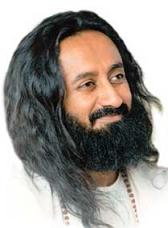 Expressing
concern over the fast-spreading protests against the proposed
reservation in educational institutions for OBCs, spiritual guru
and ‘Art of Living’ proponent Sri Sri Ravi Shankar on Monday
said that providing quota would not end disparities. Expressing
concern over the fast-spreading protests against the proposed
reservation in educational institutions for OBCs, spiritual guru
and ‘Art of Living’ proponent Sri Sri Ravi Shankar on Monday
said that providing quota would not end disparities.
“Caste-based
reservation will not end disparities in the society. While being
born in any particular caste should not be a curse, reverse
discrimination is not the way for justice,” he said in a
release issued in Chennai.
(source:
It
will divide India: Sri Ravi Shankar
- indianexpress.com)
***
Palash Sen slams UPA Govt for
'dividing India'
Hitting out against the UPA government's reservation policy,
doctor and singer Palash Sen on Monday said the government
should rather focus on removing the huge economic disparity in
the country than indulging in "vote-bank politics".
 "Poverty
is the major cause of concern in the country. It has created a
deep divide in the society. This needs to be bridged by creating
more employment opportunities than enforcing reservation. Poverty
comes by birth, not caste," said Sen, the lead
singer of rock band Euphoria. "Poverty
is the major cause of concern in the country. It has created a
deep divide in the society. This needs to be bridged by creating
more employment opportunities than enforcing reservation. Poverty
comes by birth, not caste," said Sen, the lead
singer of rock band Euphoria.
After
singer Rabbi Shergill and Art of Living proponent Sri Sri Ravi
Shanker, Sen is another celebrity to pledge his support to the
anti-reservation campaign. "It is appalling to
see that the political leaders are leading the nation towards
path of destruction."
A
practising medico himself, the singer said, "I know how
much I toiled to get a medical seat. We
put in our blood and sweat while the government gifts away seats
on a platter to some not even eligible for it."
"These
politicians partitioned our nation on the basis of religion. Now
they are dividing the country on caste basis.
While
we are trying to bridge the communal divide by having Pakistani
rock band Strings perform with us," Sen, whose troupe
members sported black arm bands to protest the government
decision, said. He also objected to every political leader
rushing abroad for medical treatment. "This shows that they
themselves don't have faith in our doctors," Sen said,
adding, "they continue to harness vote bank
politics."
(source: Palash
Sen slams UPA Govt for 'dividing India' - sify.com). Refer
to Anti-Brahmanism
should stop!
- By Francois Gautier - rediff.com).
Of reservation & retribution
A
law on 27 per cent reservation for Other Backward Castes
in the government's higher educational institutions being agreed
upon by one and all of our political animals in Parliament, the
yeoman strike by doctors will probably have ended by the time
this appears in print. The coming of the law is now certain, but
having got an assurance from the government that the number of
the general category of seats will remain unchanged, the knights
with stethoscopes will ultimately have died with their boots and
white coats on.
Never mind that they didn't get
the quota rolled back; never mind that they didn't get a
commission to review the entire reservation scheme; the fact of
the matter is that our bright, young medicos, oh some of them so
petite and pretty, have revived memories
of pre-Independence day civil disobedience agitations.
They have sown those very old seeds
again and it's a warning for those political animals who rule
this country for votes, votes and more votes, for more power,
more pelf and more prestige.

Pandit
Jawaharlal Nehru.
"I dislike any
kind of reservations…if we go in for reservations on communal
and caste basis we (will) swamp the bright and young able people
and remain second-rate or third-rate."
The
pro-business pragmatic BJP government which ruled in the late
1990s stoked economic growth and contained self-destructive
populism.
***
Jawaharlal
Nehru wrote, 'I dislike any
kind of reservations…if we go in for reservations on communal
and caste basis we (will) swamp the bright and young able people
and remain second-rate or third-rate…the moment we encourage
the second-rate we are lost...this way lies not only folly but
disaster.' And, mind you, Nehru wrote what he did
although reservation of seats and special representation were
principles enshrined in the Indian Constitution from its
inception in 1950.
But it would
have been a sight to see all Congressmen, from Arjun
Singh to Sonia Gandhi, squirm when confronted by a
placard, a poster or a banner bearing Nehru's warning in letters
of red. Intriguingly enough, the medicos chose to first meet the
HRD minister, then the prime minister and thereafter the
President, but not Sonia Gandhi. Why? What was the message the
young were delivering? That the Italian
Maharani wouldn't feel their feelings? Or that they
knew she just didn't care a damn for them?
 Meanwhile,
Francois Gautier's article
in rediff the other day
reveals the latest India tragedy: the plight of today's Brahmins,
once regarded as the Most Forward Caste. The
Frenchman showed in figures how the relentless pursuit of
reservations in our country has plunged the MFC to the position
of what once our Dalits were as a class. Meanwhile,
Francois Gautier's article
in rediff the other day
reveals the latest India tragedy: the plight of today's Brahmins,
once regarded as the Most Forward Caste. The
Frenchman showed in figures how the relentless pursuit of
reservations in our country has plunged the MFC to the position
of what once our Dalits were as a class.
(source:
Of
reservation & retribution - By Arvind Lavakare -
rediff.com).
How
reservations fracture Hindu society
The recent fuss
about caste-based admission quotas to educational institutions,
as well as the threat to force industry to adopt mandatory
quotas, inflames people's passions. But considered in context,
reservations a. are needed only because of poverty perpetuated
by the establishment, and b. have become principally a tool to
divide and rule Hindus.
The
'Lords of Poverty', that is the Congress
party and the Marxists, are pushing
this agenda. This alone should make the neutral
observer pause. These groups need people to be poor, so as to
seduce them with rhetoric about socialism and re-distribution.
It
is clear that the agenda behind this divisive and polarising
issue is to perpetuate this sort of status quo, pitting Hindu
groups against each other. The Kerala example is being
replicated all over the country: reservations are being misused
to keep Hindus disunited. It is 'divide and rule' in a new
incarnation
(source: How
reservations fracture Hindu society - By Rajeev Srinivasan -
rediff.com).
Empowering
through entrepreneurship
The empowerment of the weaker sections among the SC/STs and
OBCs must be through entrepreneurship and business rather than
by quotas." - says R.
Vaidyanathan - author is Professor
of Finance and Control, Indian Institute of Management
Bangalore.
(source: Empowering
through entrepreneurship - By R Vaidyanathan -
hindubusinessline.com).
Indian
media caught in a caste warp
Journalism
is called the fourth pillar of democracy and media has always
raised a vociferous debate on the caste cauldron in society. But
has the Fourth Estate itself ignored the principles of democracy
in their institutions?
The
survey covered over 300 top editors
working in 40 television and print news networks, and
profiled them in terms of age, religion, caste/community and
gender.
It
reveals that Hindu upper caste men, who constitute just eight
per cent of the total population of India, hold over 70 per cent
of the key posts across newsrooms in the country. The so-called
twice born Hindu castes dominate 85 per cent key posts despite
constituting just 16 per cent of the total population, while the
intermediary castes a represent meagre three per cent.
The
Hindu Other Backward Class groups, who are 34 per cent of the
total population, have a share of just four per cent in the
Indian newsrooms.
(source: Indian
media caught in a caste warp - ibnlive.com).
Refer
to Anti-Brahmanism
should stop!
- By Francois Gautier - rediff.com).
Top
of Page
Arun
Shourie questions very notion of quotas in new book
Amid the furore over reservations for OBCs in higher
education, former BJP Minister Arun Shourie has joined the
anti-quota chorus, egging on the judiciary to strip political
parties of their populist cover once and for all.
In his new book 'Falling Over
Backwards: An essay against reservations and against judicial
populism,' he documents what he says are attempts by
state legislatures and Parliament to bend the law for their
benefit, and how the courts - including the Supreme Court - have
been virtually ineffective in tackling arbitrary government
functioning. The book, which comes in the backdrop of the
government's proposal to reserve 27 per cent seats for Other
Backward Classes in higher education as well as a move to
reserve jobs in the private sector, charts the history of
reservations and and questions the very notion of quotas.

Arun
Shourie in his new book - Falling Over
Backwards: An essay against reservations and against judicial
populism.
Prime
Minister Jawaharlal Nehru, who said
quotas based on communal lines would lead to disaster.
Refer
to Shourie
for PM? - indiareacts.com - Relatively
young. Honest. Tough.
Visionary. And deep. Arun Shourie is a deep man. For emergent
India, he is quite a remarkable prime minister to have.
***
Shourie begins by quoting the country's first Prime
Minister Jawaharlal Nehru, who said
quotas based on communal lines would lead to disaster.
He then cites a number of instances to prove that
"affirmative action through reservations" has done
little to improve the lot of the underprivileged across India.
"By legitimising a programme
based on caste, they have perpetuated a tumour. They have not
just slowed down growth, they have lowered norms of conduct, and
thereby harmed the very ones whom they wanted to help. They have
done worse; they have lent their hand to dividing our people and
country," Shourie writes.
While discussing possible solutions to the quota issue
and to raise living standards of the poor, Shourie has a word of
suggestion for courts and anti-reservationists. "Judges
must reflect on the encouragement they have given to the worst
instincts of the political class," he says, and adds, "Those
who are making the new India by their innovations, hard work and
by striving for excellence must speak up. They must organise."
(source:
Arun
Shourie questions very notion of quotas in new book
- thehindu.com). Refer to
The
State As Charade: V.P. Singh, Chandr Shekhar and the Rest. For
more refer to chapter on
Quotes
***
The
Death of Meritocracy
in India
It was too good
to last.
For a little over a decade, it looked really real. At long last,
India was getting its act together and was beginning to compete
successfully in the global marketplace. The long night of being
led by Fabian socialists who were content with the Hindu rate of
growth was over. The world was just getting used to the natural
business acumen, the intellectual genius, and the creative
talents of Indians.
Newspapers and business magazines could
not refer to China without mentioning India in the same
sentence.
Stop the
presses. Party's over. Bad news, folks. It's the same old, same
old. Just as the world was turning flat, India has decided to
retreat into its own spherical bubble of class warfare. The
quota raj is over. Long live the quota raj. Plus ça change,
at least in Bharatvarsha. In all seriousness, the UPA-Left
Coordination Committee's decision
to introduce a 27 per cent quota in educational institutions
from June 2007 should be viewed as a defining moment in the
history of modern India. This is a battle for the very future of
India. And the battle is far from over.
(source: The
death of meritocracy - By Ram Kelkar - rediff.com).
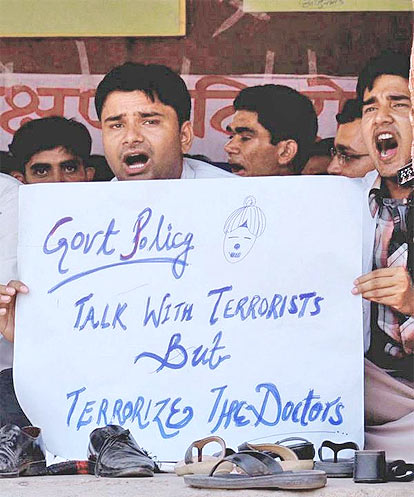
Like
their doctor-colleague in England, perhaps the agitating doctors
in India are crying out for something much more than just the
reservation of seats in colleges.
They
are fighting against the impending partitioning of India's soul.
***
Fighting
for India's Soul
The Next Partition of India
 The
die is cast. Manmohan Singh's government has announced
that the legislation to reserve additional 27 per cent seats in
higher educational institutions will be introduced in the
monsoon session of Parliament. This is the beginning of India's
second partition, which follows the one that took place 59 years
ago. That one was geographical; this one will go right through
every town and city. The
die is cast. Manmohan Singh's government has announced
that the legislation to reserve additional 27 per cent seats in
higher educational institutions will be introduced in the
monsoon session of Parliament. This is the beginning of India's
second partition, which follows the one that took place 59 years
ago. That one was geographical; this one will go right through
every town and city.
Nothing is forever. The great
centres of learning in India before independence -- like the
universities in Allahabad, Calcutta, Madras, Delhi and Bombay
that produced some of the world's leading scholars of the first
half of the 20th century -- are pale shadows of their
old selves.
One
would expect that the IITs, IIMs,
and AIIMS would also soon slide
into mediocrity.
Perhaps the
Indian elite are not particularly worried about all this. They
don't need excellent institutions in India as much as they did
twenty years ago. The world has become a village, and the rich
will adjust by sending their children to colleges overseas in
Europe, America, Australia, or Singapore.
Like
their doctor-colleague in England, perhaps the agitating doctors
in India are crying out for something much more than just the
reservation of seats in colleges. They are fighting against the
impending partitioning of India's soul.
(source: The
Next Partition of India - By Subhash Kak - rediff.com). Refer
to Anti-Brahmanism
should stop!
- By Francois Gautier - rediff.com).
Top
of Page
Hindu
temple in Lahore (Pakistan) demolished
 The
only Hindu temple in the Pakistani city of Lahore has been
demolished to pave the way for construction of a multi-storied
commerical building. The
only Hindu temple in the Pakistani city of Lahore has been
demolished to pave the way for construction of a multi-storied
commerical building.
The temple
was recently demolished after officials of the Evacuee Property
Trust Board, the government body maintaining properties of
minorities, specially Hindus and Sikhs,
reportedly concealed facts from the board chairman about the
nature of the building, daily Dawn reported on Tuesday.
A private developer was allowed to demolish 'Krishna Mandir'
at
Wachhoowali, Rang Mahal and raise a commercial building in its
place in violation of the EPTB's own scheme for management and
disposal of urban evacuee trust properties, it said. Quoting
documents, the paper said board officials did not mention that
the property being given to an influential jeweller of the area,
was a Hindu temple.
The
demolished Krishna temple
was the only Hindu place of worship in the city. This is the
second Hindu temple to have been permitted to be demolished by
EPTB administrator Chaudhry Javed Bashir, sources in the EPTB
said.
(source: Hindu
temple in Lahore (Pakistan) demolished - rediff.com).
Refer
to World Conquering Creeds in
chapter Glimpses
XVI.
Top
of Page
Japanese
embrace yoga to keep fit
Tokyo: A yoga boom that first began in United States is growing
fast in Japan with the world's largest yoga training
organisation being built which shall offer courses in Tokyo's
Ginza district.
 In
the one-month since Bikram Yoga, which teaches so called “hot
yoga”, launched its first training programme, about 2,200
people have signed up for the classes. In
the one-month since Bikram Yoga, which teaches so called “hot
yoga”, launched its first training programme, about 2,200
people have signed up for the classes.
"About
70 per cent of the learners are women in their 20s and 30s who
hope to lose weight or get rid of stress," said Kenji Ehara,
36, from the business division of Bikram Yoga, which runs about
1,500 fitness studios in various countries.
Bikram
Yoga plans to open four such studios in Tokyo and in Sendai,
Miyagi Prefecture in northeastern Japan, by the summer of this
year. There are plans of establishing 10 new courses this year.
Its Ginza studio is an answer to those found in India, which is
the cradle of yoga.
The
room temperature is set at 40 degrees Celsius and the humidity
at 55 per cent. About 40 people in T-shirts, including several
men, greet their instructor with bottles of water ready at their
feet.
The
distinctive feature of hot yoga is that its enthusiasts go
through a series of 26 different poses, including
one called ''Garudasana
(eagle pose),'' while practicing conscious breathing and
perspiring heavily.
The
creator of hot yoga, Bikram Choudhury, who is of Indian origin
said that his discipline is more akin to body care than exercise
during his recent visit to Japan
He
added that it places only a small burden on joints and muscles
because the high room temperature helps warm the body and
increases the healing power of the body and mind as a result the
blood circulation improves.
(source:
Japanese
embrace yoga to keep fit).
Top
of Page
Stealing
India's cultural and religious identity ?
Stolen
Lord Vishnu statue sent back to India
 New York: A stolen 9th century
stone statue with carvings of all the ten incarnations of Lord
Vishnu began its journey back home to be reinstalled
in the Varaha temple in Mandsour,
Madhya Pradesh, from where it was stolen six years
ago. New York: A stolen 9th century
stone statue with carvings of all the ten incarnations of Lord
Vishnu began its journey back home to be reinstalled
in the Varaha temple in Mandsour,
Madhya Pradesh, from where it was stolen six years
ago.
Indian Consul-General Neelam Deo
and Special Agent in charge of investigation at the United
States Immigration and Customs Enforcement (ICE) Martin D. Ficke
signed the papers at a brief ceremony on Monday, formally
handing it over to India. This was one of the two idols stolen.
The search for the other is still on. Despite its tortuous
journey to New York, the 127 cm tall and 71 cm wide idol is in
good condition with only a mark at the back from where it might
have been chipped off at the Mandsour temple. The recovery was
described by Indian and United States officials as the
``fruitful'' result of coordinated investigations in India and
the U.S. ``The Government and the people of India greatly
appreciate this gesture of goodwill from the government and
people of the United States,'' Ms. Deo said.
"When
someone steals a cultural artefact from a country, that country
loses a part of its identity and its heritage.
Today,
we are able to return the Varaha statue
to the government and people of India and restore a part of its
cultural heritage that had been stolen from her,'' Mr. Ficke
commented as he signed the papers.
Senior Special Agent James
McAndrew, who investigated the case, said the probe led the
investigators to Namkha Dorjee, owner of the Bodh Citta Gallery,
who was operating from his apartment in New York. Once agents
closed in, he voluntarily handed them the statue. Mr. McAndrew
said that it was particularly difficult to investigate
undocumented artefacts and a great deal depended on the way the
theft is investigated in the home country. No arrest had yet
been made in the U.S. as the crime could not be pinned on any
individual.
The statue was originally
destined for Switzerland but
was diverted to Britain and papers were altered somewhere along
the journey. The person who was responsible for sending it from
Britain to the U.S. was reportedly killed in Afghanistan some
time ago. He was apparently trying to smuggle out that country's
heritage, American investigators said. It was only in 2003 that
ICE received information from the Indian police and Interpol
that the statue was in the United States which ultimately led to
its recovery.

In
Varaha incarnation, Lord Vishnu is said to have rescued the
earth from being drowned by Hiranyaksha. Varaha, using his boar
attributes, saved the earth from being drowned in the cosmic
sea.
(For
more refer to chapter on Greater
India: Suvarnabhumi and
Sacred
Angkor).
***
The
principal subject of the sandstone statue is Vishnu in his third
incarnation as a boar and it shows the killing of Hiranya demon
and the liberation of the earth. On the left elbow, earth is
depicted as a feminine figure. Around the statue are the other
incarnations of Vishnu. In
Varaha incarnation, Vishnu is said to have rescued the earth
from being drowned by Hiranyaksha. Varaha, using his boar
attributes, saved the earth from being drowned in the cosmic
sea.
(source:
Stolen
Lord Vishnu statue sent back to India - hindu.com).
Top
of Page
Temple
gods that display a shocking beauty
 To
the Western eye, these gods and goddesses are, given their
sacred function, almost shockingly beautiful. Divinity and
sensuous, sexual beauty seem to be inextricably mixed. But the
appreciation of a god's physical beauty was one of India's
customary approaches to the divine. Perfection of the body was
considered a prerequisite for the flow of inner beauty and
supremacy of spirit. To
the Western eye, these gods and goddesses are, given their
sacred function, almost shockingly beautiful. Divinity and
sensuous, sexual beauty seem to be inextricably mixed. But the
appreciation of a god's physical beauty was one of India's
customary approaches to the divine. Perfection of the body was
considered a prerequisite for the flow of inner beauty and
supremacy of spirit.
If
we look at the Goddess Uma,
for example, she is portrayed as a slender, seductive and
exquisitely beautiful woman. She has a statuesque and graceful
figure, her full breasts are softly sculpted and her skirt is
slung so low as to reveal the curve of her stomach. Other
deities, too, such as the superb Shiva,
Lord of Dance, are exquisitely elegant with their
perfectly proportioned thighs and legs, plump and supple and
decorated with folds of tightly drawn cloth, and their long
curved feet and fingers.

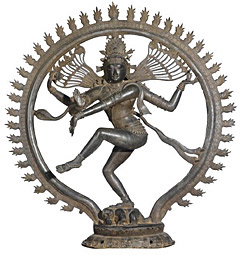
Goddess Uma
and Shiva Nataraja: Lord of the Dance.
There is grace in
elegance.
***
These
figures are nearly 1,200 years old, yet their details are still
remarkably crisply defined. The lost wax method of modelling was
done to such high standards, both technically and aesthetically,
that it is still used today unchanged.
No
wonder François-Auguste-René
Rodin (1840-1917),
one of our masters of bronze modelling, whose work can be seen at the Royal Academy, was overwhelmed when he saw
the Chola sculptures in 1913.
"There
are things that other people do not see: unknown depths, the
wellsprings of life," he said.
"There is grace in
elegance; above grace, there is modelling; everything is
exaggerated; we call it soft but it is most powerfully soft!
Words fail me then."
(source:
Chola:
Sacred Bronzes of Southern India - By
Joanna Pitman
at the Royal Academy
- The Times). For
more refer to chapter on Hindu
Art.
Top
of Page
Victorian
Prudery or Evangelical mindset of a British scientist?
Why
is a Hindu temple like a Soho phone box? - By Dr Terence
Kealey - excerpts
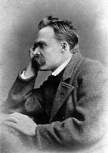 "The
Christian resolve to find the world evil and ugly, has made the
world evil and ugly."
"The
Christian resolve to find the world evil and ugly, has made the
world evil and ugly."
-
Friedrich
Nietzsche (1844-1900)
German philosopher. Refer
to Proving
that Bible is Repulsive video - godisimaginary.com.
The
Inquisitor who wrote the Malleus
Maleficarum, "the Hammer of the
Witches," explained that women are more likely to become
witches than men:
"Because
the female sex is more concerned with things of the flesh than
men; because being formed from a man's rib, they are 'only
imperfect animals' and 'crooked' whereas man belongs to a
privileged sex from whose midst Christ emerged."
(source:
The Heretics: Heresy Through the Ages -
By Walter Nigg p. 277 and The
Dark Side of Christian History - By Helen Ellerbe p.
114 - 118).
 Bertrand
Russell (1872-1970) English author, mathematician
and philosopher in his book Marriage
and Morals: Bertrand
Russell (1872-1970) English author, mathematician
and philosopher in his book Marriage
and Morals:
"The
Christian view that all intercourse outside marriage is immoral
was, as we see in the passages from St Paul, based upon the view that all sexual intercourse, even within
marriage, is regrettable. A view of this sort, which goes
against biological facts, can only be regarded by sane people as
morbid aberration. The fact that it is
embedded in Christian ethics has made Christianity throughout
its whole history a force tending towards mental disorders and
unwholesome views of life."
(source:
'Churchianity'
- An artifice for aggression
- By V Sundaram - newstodaynet.com). Watch
The
Bible is Bullshit - Penn
& Teller examine the Bible.
***
Sitting
on Judgment on Hindu Past?
Dr
Terence Kealey the
author has
been Vice-Chancellor at the University of Birmingham, UK since
April 2001. He is a well-known academic specializing in Clinical
Biochemistry,
writes:
"The
Hindu temples of central and southern
India can be startlingly erotic. The temples of Khajuraho are
the most explicit, being encrusted with statues of naked females
— big-breasted and narrow waisted — doing naughty things
with rampant men (see them on Google images). How can a religion
be so pornographic? The standard explanation is that Hinduism
harnessed sex in the service of mysticism, but we scientists are
materialists and we distrust spiritual accounts. How would
anthropologists explain pornographic temples?

Intolerant
tendencies
of Monotheism?
Victorian
Prudery in 21st century England?
"The
great pre-Christian civilizations of Greece and Rome had no
religious wars and had a far healthier view of their frolicking
gods and goddesses than the intolerant monotheistic Christianity
that later came to dominate Europe." - says Jean-Pierre
Lehmann
Adam
and Eve were supposed to be naked on Earth. Christianity and
nudity are two
substances that historically don't mix ?
***
Consequently,
DNA testing has confirmed that upper- caste females in India are
genetically indistinguishable from lower-caste females, because
pretty hoi polloi girls have always been imported into the
palaces. But the upper-caste males of India — who are the
descendants of the Aryan conquerors of 5,000 years ago — have
never allowed male proles to marry their daughters, and they
remain genetically distinct. They have, therefore, retained the
spoils of conquest for themselves and their sons.
Temple
prostitution was, therefore, a feature of Hinduism and other
imperial cultures — and a profitable one too. There were, for
example, some 400 women on the payroll at the Rajarajesvara
temple in Tanjore in the 11th century. They were procured by
priests who roamed the land in search of pretty young girls.

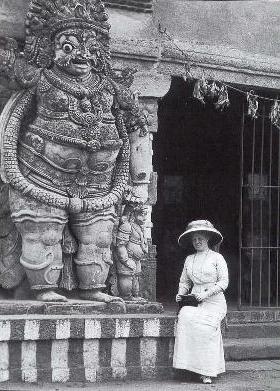
Author/Scientist Dr.
Terence
Kealey, Vice Chancellor of University of Birmingham, UK. His
prejudices seem
to be stemming from his Christian
background as well as total ignorance of Hindu iconography.
Victorian
Prudery - A woman British
tourist during the British Raj in India. Indian
temples were a popular destination for British tourist, but
escorts usually steered female sightseers away from the erotic
art featured on some temple facades. One 19th century
guide book advised women to tip local guides for not pointing
out suggestive temple carvings.
(image source: What
Life Was Like in the Jewel of the Crown: British India AD
1600-1905
- By The
Editors of Time-Life Books p. 156).
***
Doubtless
the girls were seduced by a theology of mysticism, just as the
widows who, as suttees, threw themselves on their dead
husbands’ funeral pyres believed they were attaining spiritual
purity, but the sexual economics of female exploitation provide
a candid explanation of what was happening. As do the statues on
the temples. Frankly, they are arousing, even in these jaded
times, being more explicit than the photos in today’s
telephone booths. In short, a millennium ago the temples of
India were brothels — they may have been more than that, but
they were brothels too — and they advertised their wares as
brothels always have. The erotic temple statues of India remind
us, therefore, that kings and priests — like politicians today
— have always been despots."
***
Infuriated
Comments
from readers on this article:
"One
has to wonder, if I was to write an article and title it,
"Why Are Mosques Terrorist Breeding Grounds" or "Why
Are Churches the Last Refuge of the Paedophile"
(Watch Sex
Crimes and the Vatican
video) to and then substantiate the title with historical fact, would the
Muslim and Christian communities accept that to be a respectful
way to address their faith? Using a headline in this manner is
an attempt to appeal to the innate human curiosity around sex in
a tabloid manner. To describe a temple, a place of worship, as a
brothel is frankly outrageous. These temples were created to
celebrate the union of man and woman as a spiritual encounter.
To state that sexual acts were carried out for the satisfaction
of the ruling and invading classes is simply not true. There is
a history of various beliefs celebrating this union, are
celebrations such as Hieros Gamos not exactly the same
celebration? Just because Hinduism does
not vilify sex, it does not make it shameful. After all, you
wouldn't be here without it."
"Its
not porn it's love. And hooray for a religion that
doesn't make us feel as though we are doing something disgusting
when we are only doing what humans are supposed to do -
reproduce - and why can't it be fun?"
"Well
this only confirms that you Westerners have scant respect for
other cultures. Get your basics correct. Your pet Aryan theory
is rubbish and this has been proven beyond doubt."
"His reliance on Aryan
Invasion theory is as baseless as his ignorance
of the Hindu dharma is total. East and West twain may meet but
never the Semitic religions and Sanatan dharma."
(source: Why
is a Hindu temple like a Soho phone box? - By Terence
Kealey
- science notebook -
timesonline.co.uk). Note:
Christians in Voltaire's
day carried the holy
(Jesus) foreskin in
processions and paid sacred homage to it. For more refer
to chapter on Glimpses
IV. Refer to
Christian
Nude art
.
Watch Sex
Crimes and the Vatican
video. Refer
to Why
The Christian Right Should Want To Ban The Bible - By
Denise Noe
and Watch
the movie - Indoctrination
in Jesus Camp.
For
more information refer to chapters on European
Imperialism, First
Indologists, Aryan
Invasion Theory and Conversion
and
Refer to Skeptics
Annotated Bible and Refer to
Pedophiles
and Priests: Anatomy of a Contemporary Crisis - By Philip
Jenkins. Refer
to Women's
Inferior Status in the Bible. Also
refer to History
of Chastity belts that were used in Europe.
Refer
to Gay
Bashing in the Bible - "If
a man also lie with mankind, as he lieth with a woman, both of
them have committed an abomination: they shall surely be put to
death; their blood shall be upon them." Leviticus
20:13. Church still has Dark Ages attitude on sex where gays are
still treated as "deviant and a threat to society.”
Vatican's most anti-gay rhetoric comes from the Pope calling
calling homosexuality "an intrinsic moral evil."
Infinite
Tolerance - the hallmark of Hinduism - Third Nature
In Vedic
India, homosexuality
is recognized as a separate and third
nature (tritiya-prakriti).
Third-gender citizens were fully tolerated and incorporated into
society. Whether it is
homosexuality or the promiscuous behavior, the fact is that
Hinduism tolerates the ignorant souls of this whole wide world
without crushing them with the weight of its scriptural
authority. Hinduism
does not encourage homosexuality nor condemn it very
badly.
There is no condemnation of
homosexuality in Hindu scripture. During
the British Raj, homosexuality was considered a sin. Two years
after the 1857 rebellion, the British passed
the anti-sodomy law of 1860 is enforced upon the entire
empire that now includes India. (Ironically,
while the British drafted Section 377 of the IPC, while
replacing a tolerant Indian attitude towards sexuality with a
highly oppressive one, this law was repealed in the UK in
1967). The law, which remarkably is still in place in
India today as Section
377 of the Indian Penal Code,
reads: “Whoever voluntarily has carnal intercourse against the
order of nature with any man, woman or animal, shall be punished
with imprisonment for life, or with imprisonment of either
description for a term which may extend to ten years, and shall
be liable to fine.” This law was taken to be an improvement
for Great Britain, which had previously punished homosexuality
by execution and torture, but for India it was a great step
backward since Hindu culture had never previously criminalized
homosexuality. For more refer to chapter on thoughts.
***
Four
Aims of Life of Ancient India
"The Cosmic Being created the world because by
himself he knew no joy. He wanted to be two. – Bridadaranyaka
Upanishad.
"Women is the image of Nature (Prakriti), and man
is the image of Being (Purusha). When they unite, they dissolve
into divine unity." (quoted in Siddanata
p. 275).
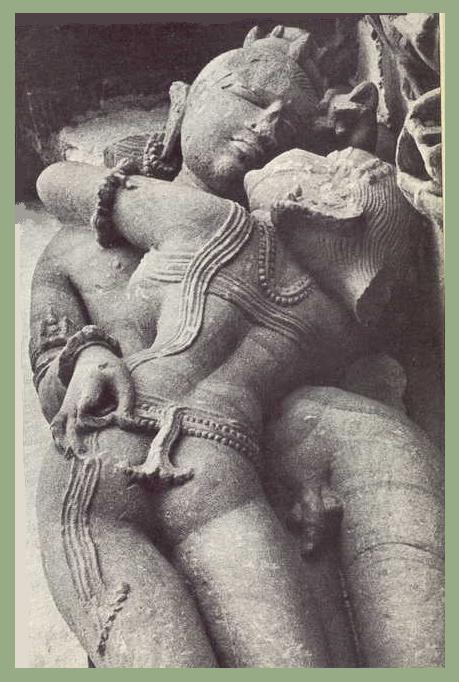
Artistic
Loving embrace and Divine Unity at Khujaraho temples,
India.
Sex
in Ancient India was considered an Art not a perverse, vulgar,
tasteless, titillating entertainment as it is in today's modernized TV/Hollywood world.
Sex was natural and was not repressed as in the Dark Ages of
Europe.
Sex (Kama) was one of the four aims of life, along with Dharma
(virtue), Artha (wealth), and Moksha (liberation).
Prudery
was quite unknown to ancient Indian artists, who had no
conception of ‘the sins of the flesh’ with which Western
civilizations are so preoccupied even today.
Surprisingly Modern, Bold and healthier concepts of
Hinduism. Unlike the intolerance of Christianity, Hinduism did not vilify sex.
To
the Westerner, imbued with the Puritan ethics of Christian
tradition and Victorian prudery, it is difficult to grasp the
meaning of these temples.
***
According to Alain
Danielou (1907-1994),
son of French aristocracy, author of numerous books on
philosophy, religion, history and arts of India, including Virtue,
Success, Pleasure, & Liberation : The Four Aims of Life in
the Tradition of Ancient India. He was perhaps
the first European to boldly proclaim his Hinduness, has
written:
"There are four aims of life – Dharma (virtue),
artha
(wealth, power, success), kama (pleasure) and
moksha
(liberation). At no stage of life, however, can any of these
aims be achieved if the others are neglected. "
(source: Virtue,
Success, Pleasure, & Liberation : The Four Aims of Life in
the Tradition of Ancient India p. 67 - 74 and 109
- 126).
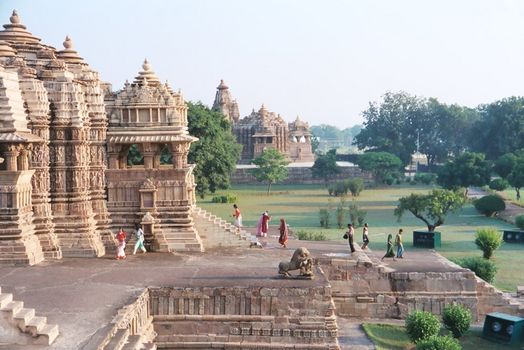
Khujaraho
temples, India.
The British
writing suffered from being imprisoned with the Victorian
framework. Their unwillingness to accept Indian art on its own
terms was certainly due to the puritanical norms of the Victorian
times.
Refer to Much
Maligned Monsters: A History of European Reactions to Indian Art
- By Partha Mitter
***
St. Augustine, the much
celebrated Father of the Church, thought that
sex was
intrinsically evil. “this diabolical excitement of the
genitals” as Augustine referred to sex, is evidence of
Adam’s original sin which is now transmitted “from the
mother’s womb,” tainting all human beings with sin, and
leaving them incapable of choosing good over evil or determining
their own destiny.
Sex as an act that empowers the individual threatens a
religion intent upon controlling society. As Clement
of Alexandria said, “lust is not easy to restrain, being devoid of
fear…”
Denying human free will and condemning sexual pleasure made
it easier to control and contain people. Christian history is replete with condemnations of human
sexuality. The witch hunts also demonstrated great fear of
female sexuality. The word “witch” comes from the old
English wicce and wicca,
meaning the male and female participants in the ancient pagan
tradition which holds masculine, feminine and earthly aspects of
God in great reverence. Hence, sexual desire was considered
ungodly.
St. Clement of Alexandria
wrote: “Every woman should be filled with shame by the thought
that she is a woman.”
The sixth century Christian philosopher, Boethius,
wrote in The Consolation of Philosophy,
“Woman is a temple built on a sewer.” The 13th
century St, Thomas Aquinas
suggested that God had made a mistake in creating woman:
“nothing (deficient) or defective should have been produced in
the first establishment of things; so woman ought not to have
been produced then.” And Lutherans at
Wittenberg debated whether woman were really human
beings at all. Orthodox Christians held
women responsible for all sin. As the Bible’s
Apocrypha states: “Of woman came the beginning of sin/ And
thanks to her, we all must die.” As I Corinthians 7:1 states,
“It is a good thing for a man to have nothing to do with a
woman.”
(source: The
Dark Side of Christian History - By Helen Ellerbe p. 30 – 33 - 114 - 125). Refer to QuickTime trailer and
Part One of the film The
God Awful Truth. Refer
to Proving
that Bible is Repulsive video - godisimaginary.com.
Watch Sex
Crimes and the Vatican
video.
Top
of Page
Religious
Pluralism?
Rev. David A Hart aka Anandakrishnadas
Thiruvananthapuram:
Can an Anglican Christian priest believe in Hindu way of
worship? The debate is spreading the whole world. Many,
particularly Christians, argue that a true Christian cannot
believe in any other God other than Jesus Christ. Based on the
age-old Hindu tradition, others argue that whatever be ones
religion one has the right to choose ones mode of worship.
Unconcerned
by the controversy and the wide publicity David
A Hart, an Anglican Priest settled in Kerala, recites
Gayathri Mantram with the same devotion with which he renders
the verses of the Bible. He has no hesitation in reciting Hindu
Hymns along with the Bible. At his residence photos of Sri
Krishna, Mahalaksmi and Ganesha adore the walls of his
pooja room along with that of Jesus Christ.
Recently,
due to his fascination for Lord Ganesha, he celebrated Vinayaka
Chaturthi (birthday of Lord Ganesha) along with his friends and
offered Pooja.
The
51-year-old Rev.Hart is an associate professor in Theology and
Religious studies at the University of Winchester in the U.K.
Recently Rev Hart renewed his orders for priesthood under the
Bishop of Ely, Cambridge shire. He says that his
‘Pilgrimage to the ocean’ on September 1 to immerse the idol
(of Lord Ganesha) would mark the culmination of a spiritual
journey he had undertaken since his school years.
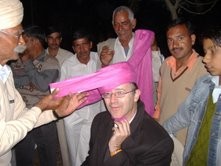

Rev. David A
Hart, Anglican priest and Lord Ganesha. Due
to his fascination for Lord Ganesha, he celebrated Vinayaka
Chaturthi (birthday of Lord Ganesha) along with his friends and
offered Pooja.
“The modern
world is no longer dominated by any single form of belief.
It is a world of religious pluralism.”
***
The
spiritual image of Ganesha as the remover of obstacles has a
special appeal for all. He says that in England the idol of
Ganesha is more popular than Krishna or any other Hindu God and
many households have Ganesha in the living room.
About the
criticism that a Christian priest is worshipping an Indian God,
he says, “The modern world is no longer dominated by any
single form of belief. It is a
world of religious pluralism.” Rev. Hart is the
international secretary of the World Congress of Faiths based in
London. He officiates the Holy
Communion at St.James Parish Church in Stretham,
Cambridge, when he is in England. “God is the same
irrespective of whether you pray to him in a temple, church or
mosque,” he adds.
(source:
Interview
with Rev. David A Hart (Anandakrishnadas) -
haindavakeralam.org).
Top
of Page
Vile Attack on Hinduism
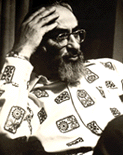 Abraham
Kaplan (1918-1993) was an American philosopher, in
his book, The
New World of Philosophy p. 207says: Abraham
Kaplan (1918-1993) was an American philosopher, in
his book, The
New World of Philosophy p. 207says:
“It
is paradoxical that we, (the West) who put so much emphasis on
individualism in economics and politics, have so little room for
it in morality and religion, as compared with Indian thought.”
(source: Ways
of Thinking of Eastern Peoples: India-China-Tibet-Japan -
Hajime Nakamura p. 171 - 172). Watch
An
Invasion through Conversion
- videoyahoo.com
"Evangelical
Christianity, born in
England
and nurtured in the
United State, is leaving home."
- Paul
Nussbaum, author of Evangelical
Christianity shifting outside West - Philadelphia Inquirer
Feb 20, 2006.
***
Christian Evangelist Diatribe against Hindu Gods and Goddesses
 "The Christian God,
Nietzsche taught, was pitiable, absurd and "a crime against
life."
"The Christian God,
Nietzsche taught, was pitiable, absurd and "a crime against
life."
– Friedrich Nietzsche
(The
Twilight of the Idols and The Antichrist).
(source: Famous
Dead Nontheists). Watch
An
Invasion through Conversion
- videoyahoo.com
and
Refer
to World Conquering Creeds in
chapter Glimpses
XVI.
Refer
to Columbus,
The Indians, and Human Progress
- By Howard Zinn
and
Refer
to Proving
that Bible is Repulsive video - godisimaginary.com.
Watch the
movie - Indoctrination
in Jesus Camp.
Watch
Ganapati
Om Kirtan - By Dave
Stringer.
Watch Kirtan
in Boulder, CO. USA.
***
Samuel
Thomas, involved in a conspiracy to publish a controversial book
'Haqeequat'
which has certain inflammatory
references against Hindu and Jain deities,
was today arrested in NOIDA on the outskirts of Delhi by Rajasthan
police.
Hindu-bashing
is nothing new for Christian evangelists in India - they do it
with as much ease as they distort Islam or Buddhism in other
countries.
 Nor is the concept of harvesting souls in
distress a novel method to add numbers to followers of Christ.
From Indonesia to Sri Lanka, there were howls of protest against
the manner in which evangelists tried to convert victims of the
2004 tsunami by preying on their emotional vulnerability. Nor is the concept of harvesting souls in
distress a novel method to add numbers to followers of Christ.
From Indonesia to Sri Lanka, there were howls of protest against
the manner in which evangelists tried to convert victims of the
2004 tsunami by preying on their emotional vulnerability.
What is new is the brazenness with which
evangelists have begun to abuse objects and symbols of Hindu
reverence, a trend that began a decade ago with Pat
Robertson's proselytising visit to Rajahmundry where
he infamously chided Hindus for "washing away their sins in
the sperm of the God," the God being Lord Shiva.
Pat
Robertson, on that occasion,
characterised Hinduism as having "evil tendencies".
Later, on 'Club
700', his immensely popular TV show, he expounded on this thesis
by claiming
"Shiva (is) the God of Destruction, and his
consort, the Goddess of death (Kali) - that black, ugly statue
there with all those fierce eyes."
Instead of denouncing
Emmanuel Mission's scurrilous screed called 'Haqeeqat', Evangelists
are brazenly abusing the Rajasthan Government. On Monday, March 20, Assist News Service, based in Lake
Forest, California, USA, which circulates news about the work of
evangelists around the world, put out a story by Michael
Ireland, its chief correspondent, headlined 'India's Prime
Minister launches investigation into arrest and persecution of
Indian Christians'.
 Hopegivers
Executive Director Michael Glenn says, "India's Prime Minister, Dr Manmohan Singh, has
launched an investigation into the arrest of Hopegivers
International President Dr Samuel Thomas. The story then goes on
to urge Christians in the US to petition Senators, Congressmen
and the US President against what it portrays as outrageous
action by the Government of Rajasthan, prodded by 'Hindu
fascist. Hopegivers
Executive Director Michael Glenn says, "India's Prime Minister, Dr Manmohan Singh, has
launched an investigation into the arrest of Hopegivers
International President Dr Samuel Thomas. The story then goes on
to urge Christians in the US to petition Senators, Congressmen
and the US President against what it portrays as outrageous
action by the Government of Rajasthan, prodded by 'Hindu
fascist.
What it does not
mention, however, is the reason why Dr Thomas and his associates
have been booked for violating Sections 153(a) and 295(a) of the
IPC, "which deal with deliberately outraging religious
feelings or insulting the religious
beliefs of another community."
In
reality, it is unadulterated abuse of Hindu scriptures, faith,
ritual and tradition. It denigrates every tenet of Hinduism and
pours undiluted scorn on Hindu icons and gurus. It casts
aspersions on the chastity of Hindu women and questions received
wisdom.
***
Abusing
freedom, falsifying Hindu
Gods
Here are some
samples of what Haqeeqat, which was being used by the Thomases
and their associates to convince Hindus in Kota to abandon their
faith and embrace Christianity, has to say:
* "Hindu
gods and goddesses are fictitious and were invented to persecute
Dalits" (Page 9).
* "To
prevent indigenous people from acquiring knowledge, Saraswati
invented difficult Vedas (which nobody can understand)".
(Page 16)
* "With
the progression of time, people all over the world (except
India) were freed of their ignorance and they began to disown
wicked and cruel gods and goddesses. But in India, because
people are (enveloped) in the darkness of ignorance, imaginary
gods and goddesses are still worshipped." (Page 17)
* "Naked
sanyasis are worshipped by (Hindu) women. The moment (Hindu)
women see naked sanyasis, they fall on the ground and prostrate
themselves before the sanyasis. (Hindu) women pour water on the
sanyasis' penises and then happily drink that water. Ling Devata
is gratified when he sees all these repulsive things and feels
empowered... These people are ignorant and do not know the
difference between what is right and wrong." (Page 93)
* "Sita
was abandoned in the forest as per Ram's wishes... Ram later
asked Lakshman to kill Sita. In the end, Ram frustrated with
life, drowned himself in Saryu. Such are the teachings of
half-naked rishis who are praised by Hindutvawadis." (Page
100)
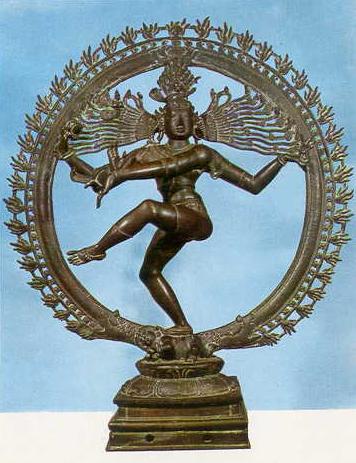
Shiva
Nataraja, processional bronze. 12th century. National Museum.
Delhi.
"This
conception itself is a synthesis of science, religion and art.
The clearest image of cosmic activity of God which
any art or religion can boast of. This conception itself is a
synthesis of science, religion and art.
"The
most elegant and sublime of these is a representation of the
creation of the universe at the beginning of each cosmic cycle,
a motif known as the cosmic dance of Lord Shiva." - Carl
Sagan.
***
* "Lord
Shiva, to get people to worship him, dropped his penis on Earth
(Devi), shaking the ground and the sky! ... . Poor Dharti Devi
was shaken by the weight of his penis. Seeing this, all the Gods
were scared. It seems Gods would use their penises as bombs!
Whenever and wherever they wanted to, they would drop their
'penis bombs' to terrorise the people. Thus, they were able to
enslave the people... But compared to foreign bombs, these penis
bombs were a damp squib." (Page 106-107)
*
"(Ramakrishna) Paramahansa should have known that Ganga is
the world's filthiest and dirtiest river. How many dead bodies
float down this river every day? How many half-burnt dead bodies
are dumped into it every day? And Hindus call it the holy river!
In fact, all the rivers of India are dirty and polluted...
Hindutvawadis pollute the rivers... and then depend on their
false Gods to cleanse them..." (Page 122-123)
* "(For
Hindus) men can be Gods, women can be Goddesses... animals are
gods, snakes are gods... they (Hindu Gods) fight among
themselves, marry among themselves, throw out their wives, run
away with others' wives, they steal, get intoxicated, drink
blood, are reincarnated as animals, fish and tortoise, some of
them can lift mountains... Some Gods are in same-sex
relationships and are yet able to produce babies. These Gods and
Goddesses are always armed because they believe in killing and
plunder. Some Gods think their penises are more powerful than
nuclear bombs. Others like animals live naked among their
followers. Some of them spend their time in yogic exercises,
others are in samadhi and happy to see the number of blind
followers swell... You can wash away your sins by worshipping
the penises of Gods" (Page 146)
* "How
could Arya Hindus bring Aryanisation on this earth. To be Arya,
one has to be born of an Arya womb... If Arya Hindus want to
bring Aryanisation then they must lend or rent out all Arya
wombs to non-Aryans. Non-Aryans should be given Brahmin women so
that children are born from Brahmin womb" (Page 182-183).
* "In
modern India, many Ramas of this belief are living a carefree
life. They marry several times, desert their wives, marry
several times, and leave them. Many Ramas kill their Sitas. They
are following their God Rama." (Page 269)
* "(Lord)
Krishna had a despicable sex life... Shri Krishna is famous
because of his love life. He had 16,008 wives. And all Yadav
women were his illegitimate lovers. (Hindu) women are drawn
towards him because of pornographic and vulgar tales of his sex
life." (Page 391)
 About
the national song Vande Mataram
'Haqeeqat says: 'For India the only use of
Sanskrit is by
Hindutvawadis to sing Vande Mataram.' About
the national song Vande Mataram
'Haqeeqat says: 'For India the only use of
Sanskrit is by
Hindutvawadis to sing Vande Mataram.'
This is not the
first time that the Emmanuel mission has run foul of the local
administration and upset Hindus. On February 24, 2005, there was
a near riot situation following the mission's crude attempt to
convert Hindus through allurement and false propaganda. On that
occasion, the mission head, Mr M A Thomas, had promised not to
continue with such provocative activities.
In recent
years, the issue of conversion/re-conversion has also become a
major cause of communal tensions in some parts of the country.
Allegations of forced conversions/ reconversions and subsequent
communal tensions have surfaced from time to time. On many
occasions even apprehensions, not founded on facts, on this
account have given rise to communal tensions. Cases in point are
the recent events on the occasion of the annual religious
Assembly of the Emmanuel Bible Institute Samiti at Kota,
Rajasthan, in February 2005. The situation was controlled due to
prompt measures taken by the District States of Arunachal
Pradesh, Orissa, Madhya Pradesh and Gujarat have already passed
legislations to regulate conversions by coercive means or
offering allurements." And yet,
there is outrage over action against the Thomases.
Such
perverse drivel, such horrendous hate, as exemplified by the
contents of Haqeeqat, the operating manual of Emmanuel mission,
of course, is of no consequence to those who have taken up
cudgels on behalf of its peddlers masquerading as Good
Samaritans and Christian evangelists.
Instead,
they are faxing letters to the White House, the US State
Department, the United Nations, and Indian ambassadors to the US
and the UN to paint the Government of Rajasthan in communal
colours.
 Percy Bysshe Shelley (1792 - 1822) was one of the major English Romantic poets,
did not belong to the R S S or Sangh Parivar. This fact by
itself should gladden the hearts of vermin like Mathew, Dr D M
Thomas and Samuel Thomas. Percy Bysshe Shelley (1792 - 1822) was one of the major English Romantic poets,
did not belong to the R S S or Sangh Parivar. This fact by
itself should gladden the hearts of vermin like Mathew, Dr D M
Thomas and Samuel Thomas.
But P B Shelly in his immortal lines
of poetry gives a death blow to them not as a Prophet or as a
Poet, but as an able lawyer! I would like Shelly speak on his
own behalf:
"Who
was Jesus Christ?
The divine teacher yes
He led
The crowd, he taught them justice, truth and peace,
In semblance; but he lit within their souls
The quenchless flames of zeal, and blessed the sword
He brought on earth to satiate with the blood
Of truth and freedom his malignant soul!
"
(source:
Abusing
freedom, falsifying Hindu Gods
- Op ed dailypioneer.com March 24 2006 and After
green doves, it's white pigeons!!
- By V Sundaram - newstodaynet.com).
Refer
to Jyllands-Posten
Muhammad cartoons controversy and
Refer
to World Conquering Creeds in
chapter Glimpses
XVI.
Refer
to Luigi
Cascioli - "The Fable of Christ
- Signor
Cascioli’s contention - is that there was no reliable evidence
that Jesus lived and died in 1st-century Palestine apart from
the Gospel accounts, which Christians took on faith. There is
therefore no basis for Christianity, he claims. Signor
Cascioli maintains that early Christian writers confused Jesus
with John of Gamala, an anti-Roman Jewish insurgent in
1st-century Palestine. Church authorities were therefore guilty
of “substitution of persons”.
 The
God Who Wasn't There,
Jesus
Seminar
fellow Robert
M. Price tells us
the excuse that early Church
fathers offered for this very inconvenient fact.
Price is a former fundamentalist Christian who, upon
investigating his religion in seminary, became convinced that Jesus
Christ most likely did not exist at all.
Newsweek says
"irreverently lays out the case that Jesus Christ never
existed." In this provocative, critically
acclaimed documentary, you will discover: The
God Who Wasn't There,
Jesus
Seminar
fellow Robert
M. Price tells us
the excuse that early Church
fathers offered for this very inconvenient fact.
Price is a former fundamentalist Christian who, upon
investigating his religion in seminary, became convinced that Jesus
Christ most likely did not exist at all.
Newsweek says
"irreverently lays out the case that Jesus Christ never
existed." In this provocative, critically
acclaimed documentary, you will discover:
The early founders of
Christianity seem wholly unaware of the idea of a human
Jesus
The Jesus of the Gospels bears a striking resemblance to other
ancient heroes and the figureheads of pagan savior cults
Contemporary Christians are largely ignorant of the origins of
their religion
Fundamentalism is as strong today as it ever has been, with an
alarming 44% of Americans believing Jesus will return to earth in their lifetimes. And God simply
isn't there .
***
Hypocrisy
of Christian organizations in the West ?
Christian
organizations have shown a blatant lack of respect for Hinduism
with hate and perverse drivel in manuals like Haqeeqat by Hopegivers
International
and yet are upset at depiction of Jesus Christ -
refer to 'Jesus
with erection' ignites outrage - A Catholic activist
organization has written to Oregon's governor and state
lawmakers to protest a University of Oregon student newspaper
for having published cartoons showing Jesus Christ naked and
with an erection.
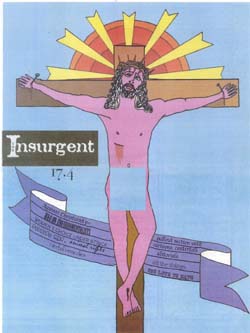
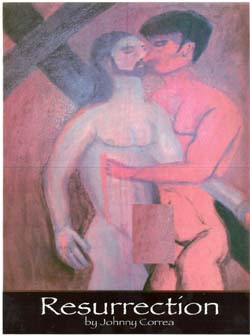
In its March
edition, the Insurgent, an "alternative" student paper
on the Eugene, Ore., campus printed 12 hand-drawn cartoons of
Jesus as a response to rival paper the Commentator having
published the controversial cartoons of Muhammad originally
published in Europe that sparked Muslim riots worldwide.
***
(source:
Jesus
with erection' ignites outrage -
worldnetdaily.com). Watch
An
Invasion through Conversion
- videoyahoo.com
and
Refer
to World Conquering Creeds in
chapter Glimpses
XVI.
Refer to Vatican
Tries to Break "Da Vinci Code - The Vatican has stepped up its denouncement of
the hotly anticipated movie, upgrading its disapproval of the
book's supposedly anti-Christian theories from pulpit-spewing
rants to full-blown boycott. Cartoon
controversy in Denmark
-
Afraid of violent reaction from the Muslim world -
Church
leaders urge dialogue with muslims following cartoon controversy
and Welsh
Archbishop Apologises for Prophet Cartoon. Refer
to Jyllands-Posten
Muhammad cartoons controversy
Top
of Page
Is
Yoga Without Hindu Influence Still Yoga?
The origins of yoga reach all the
way back to the Hindu religion, before Christ was even born.
But many faithful churchgoers are chanting phrases from the
Bible when they do their Downward Dog, and it's causing yoga
purists to lose their cool.
Susan Bordenkircher teaches a Monday night Christian yoga
class called "Outstretched in Faith." "I approach
each class as a way to share with people something great about
their faith," she said. But which faith?

Sage
Patanjali. North facade garbhagraha - Melakkadormbur. South
Arcot. Sri. Amrtakatesvam temple.
(courtesy: French Institute of Indology. Pondicherry.
India)
The origins of yoga reach all the way back to the Hindu
religion, before Christ was even born.
***
Traditional yoga, with it's roots in
the Hindu religion, predates Christianity. Its original goal was
to develop self-awareness and find divinity within oneself.
Those Hindu ideals offend some Christians. Pope
Benedict XVI has warned that yoga
"can degenerate into a cult of the body."
When Bordenkricher, a devout Methodist, was first exposed to
Yoga, she loved the exercise, but was turned off by some of the
Hindu-based chanting. "It made me feel uncomfortable,"
she said. "It made me feel as if those were elements that I
certainly did not want to participate in." So Susan joined
a growing trend, modifying traditional yoga, replacing many of
the Hindu chants with biblical phrases, or Christian themes.
There are clear physical benefits to this kind of activity.
It stretches the muscles and relaxes the body.
But
Yoga purists say that Yoga without Hinduism, isn't Yoga at all.
"If you take a tree an chop off
it's roots, then you don't have a tree, do you?" said
Professor Subhas Tiwari, a professor of Yoga philosophy at Hindu
University.
Tiwaris says yoga is not something
that can be edited with the Hindu parts cut out.
"Yoga is mind body
spirit," he said. "You want to make those separations
then you live in a schizophrenic world."
(source: Is
Yoga Without Hindu Influence Still Yoga?
- abcnews.com). For more
refer to chapter on Yoga
and Hindu Philosophy.
Top
of Page
Europe's
contempt for other cultures can't be sustained
 Pitrim
Alexandrovitch Sorokin (1889-1968)
Russian-American sociologist
of Harvard University had said: Pitrim
Alexandrovitch Sorokin (1889-1968)
Russian-American sociologist
of Harvard University had said:
"During
the past few centuries the most belligerent, the most
aggressive, the most rapacious, the most power-drunk section of
humanity has been precisely, the Christian Western world. During
these centuries western Christendom had invaded all other
continents; its armies followed by priests and merchants have
subjugated, robbed or pillaged most of the non-Christians.
Native Americans, African, Australian, Asiatic populations have
been subjugated to this peculiar brand of Christian
"love" which has generally manifested itself in
pitiless destruction, enslavement, coercion, destruction of the
cultural values, institutions, the way of life of the victims
and the spread of alcoholism, venereal disease, commercial
cynicism and the like."
(source: History
of Hindu-Christian Encounters - By Sita Ram Goel
ISBN 9990049173 p. 370).
A
continent that inflicted colonial brutality all over the globe
for 200 years has little claim to the superiority of its values.
Europe
has never had to worry too much about context or effect because
for around 200 years it dominated and colonised most of the
world. Such was Europe's omnipotence that it never needed to
take into account the sensibilities, beliefs and attitudes of
those that it colonised, however sacred and sensitive they might
have been. On the contrary, European countries imposed their
rulers, religion, beliefs, language, racial hierarchy and
customs on those to whom they were entirely alien. There is a
profound hypocrisy - and deep historical ignorance - when
Europeans complain about the problems posed by the ethnic and
religious minorities in their midst, for that is exactly what
European colonial rule meant for peoples around the world. With
one crucial difference, of course: the white minorities ruled
the roost, whereas Europe's new ethnic minorities are
marginalised, excluded and castigated, as recent events have
shown.
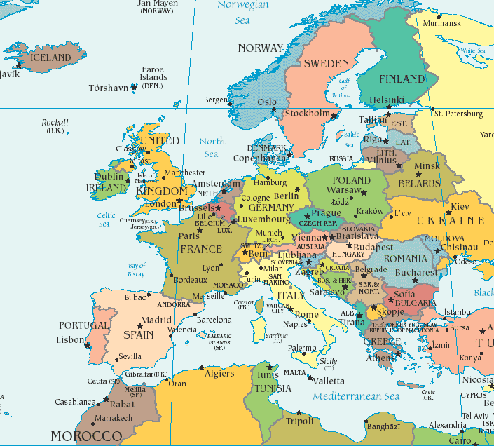
A
continent that inflicted colonial brutality all over the globe
for 200 years has little claim to the superiority of its values.
This
kind of mentality - combining Eurocentrism, old colonial
attitudes of Supremacism, Racism, provincialism and sheer
ignorance - will serve our continent ill in the future.
***
But it is no longer
possible for Europe to ignore the sensibilities of peoples with
very different values, cultures and religions. First, western
Europe now has sizeable minorities whose origins are very
different from the host population and who are connected with
their former homelands in diverse ways. If European societies
want to live in some kind of domestic peace and harmony - rather
than in a state of Balkanisation and repression - then they must
find ways of integrating these minorities on rather more equal
terms than, for the most part, they have so far achieved. That
must mean, among other things, respect for their values.
This
kind of mentality - combining Eurocentrism, old colonial
attitudes of supremacism, racism, provincialism and sheer
ignorance - will serve our continent ill in the future. Europe
must learn to live in and with the world, not to dominate it,
nor to assume it is superior or more virtuous. Any continent
that has inflicted such brutality on the world over a period of
200 years has not too much to be proud of, and much to be modest
and humble about - though this is rarely the way our history is
presented in Britain, let alone elsewhere. It
is worth remembering that while parts of Europe have had free
speech (and democracy) for many decades, its colonies were
granted neither. But when it comes to our "noble
values", our colonial record is always written out of the
script.
This
attitude of disdain, of assumed superiority, will be
increasingly difficult to sustain. We are moving into a world in
which the west will no longer be able to call the tune as it
once did. China and India will become major global players
alongside the US, the EU and Japan. For the first time in modern
history the west will no longer be overwhelmingly dominant. By
the end of this century Europe is likely to pale into
insignificance alongside China and
India. In such a world, Europe will be forced to
observe and respect the sensibilities of others.
A
small example is the bitter resistance displayed on the
continent to the proposed takeover of Arcelor by Mittal Steel:
at root the opposition is based on thinly disguised racism. But Europe had better get used to such a phenomenon:
takeovers by Indian and Chinese firms are going to become as
common as American ones. A profound
parochialism grips our continent. When Europe called the global
tune it did not matter, because what happened in Europe
translated itself into a global trend and a global power. No
more: now it is simply provincialism.
For
200 years the dominant powers have also been the colonial
powers: the European countries, the US and Japan. They have
never been required to pay their dues for what they did to those
whom they possessed and treated with contempt. Europeans have
treated this chapter in their history by choosing to forget.
We
might think the opium wars are "simply history"; the
Chinese (rightly) do not. We might think the Bengal famine
belongs in the last century, but Indians do not.
(source: Europe's
contempt for other cultures can't be sustained - By Martin
Jacques
- guardian.co.uk).
Top
of Page
We
are always taught to hate India - says a woman from Pakistan
I
grew up in Pakistan and we were always taught to hate India,
Israel and America. Our school books described Christians, Jews
and Hindus as evil people, and unfortunately most Pakistanis
exhibit a lot of hatred because of this. I was ashamed when
Pakistanis celebrated on the streets after innocent people were
killed in the Sept. 11 attacks.
Fortunately, I had the chance to leave Pakistan and find freedom in
America. Now, I do not have to cover myself with a burqa.
I learned that one can be a good person even without being a Muslim
and I got the confidence to question Islam. Islam
is an artificial religion of medieval Arabs. Why should I accept
any religion that forces me to wear a burqa and prevents my
education?
Mr. Altaf's letter talks about caste system in India. I
want to point out that the caste system is alive and well in
Pakistan as well. It is hypocritical of Pakistanis to talk of a
caste system.
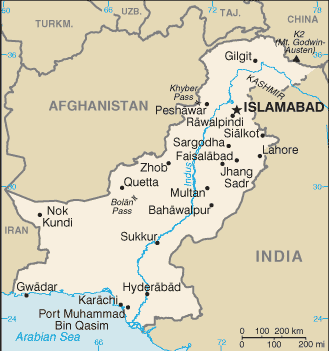
We
are always taught to hate India
I
want to point out that the caste system is alive and well in
Pakistan as well. It is hypocritical of Pakistanis to talk of a
caste system.
***
The
people of Pakistan are no different from the people of India
except that we are born into Islam. This unfortunate difference
gave birth to Pakistan, which has the dishonor of being created
as the world's first religion-based country. We should never
have left India because forming a country based on religion
tells the world that we are hateful people.
Ironically,
my own life has been one where the differences between Indians
and Pakistanis have been buried. After leaving Islam, I searched
for spiritual peace and met a wonderful man who is a Hindu from
India. Today, he is my husband and
I find that I have a lot of freedom. Women
in Islam do not have any freedom and four women are considered
to be equal to one man.
(source: We
are always taught to hate India, says a woman from Pakistan
- milpitaspost.com).
Pakistani
pamphlets link militants to Hindus, Jews
Pakistan's military airdropped pamphlets this week over towns
in restive tribal regions near the Afghan border urging
tribesmen to shun "foreign terrorists", saying they
were part of a Hindu and Jewish plot.
The pamphlets were dropped over Wana, the main town in South
Waziristan, and Miranshah in North Waziristan as part of a
campaign to win support among tribesmen who have shown sympathy
for both Taliban and remnants of al Qaeda living among them.
A Reuters reporter in Tank, a town close to the boundary with
the semi-autonomous tribal agency of South Waziristan, obtained
one of the pamphlets, bearing the sign-off "Well Wishers,
Pakistan's Armed Forces".
Titled "Warning", the pamphlets said the foreign
militants were fighting against Pakistan in connivance with
"Jews and Hindus", a term that would play on
traditional prejudices among the region's Muslim
conservatives.
(source: Pakistani
pamphlets link militants to Hindus, Jews - yahoo.com).
Top
of Page
Bio-piracy
of India's ancient Knowledge ?
Neem
- India's tree of life
 The Neem tree grows prolifically throughout South Asia,
especially in India, Sri Lanka and Burma. Its
medicinal properties have been known about for thousands of
years - Neem
features in ancient Sanskrit texts
- and its uses are so varied that this tree is called the
"Village Pharmacy" of South Asia. Recently, there has
been a growing interest from the international agro-chemical
business over the potential of Neem as an organic alternative to
industrial pesticides. Patents on the use of Neem have been
taken out by international companies, one of which was at the
centre of a 10-year court battle. An international group led by
the Indian environmentalist Dr Vandana Shiva took the case to
the European
Patent Office,
claiming you can't patent ancient knowledge, and calling it
bio-piracy. "We
wanted to reveal what bio-piracy is, this patenting of
indigenous knowledge and bio-diversity,"
she says. "We thought a patent that's held by the biggest
superpower of the world and one of the biggest chemical giants
would be an effective patent to take on." The patent was
revoked.
The Neem tree grows prolifically throughout South Asia,
especially in India, Sri Lanka and Burma. Its
medicinal properties have been known about for thousands of
years - Neem
features in ancient Sanskrit texts
- and its uses are so varied that this tree is called the
"Village Pharmacy" of South Asia. Recently, there has
been a growing interest from the international agro-chemical
business over the potential of Neem as an organic alternative to
industrial pesticides. Patents on the use of Neem have been
taken out by international companies, one of which was at the
centre of a 10-year court battle. An international group led by
the Indian environmentalist Dr Vandana Shiva took the case to
the European
Patent Office,
claiming you can't patent ancient knowledge, and calling it
bio-piracy. "We
wanted to reveal what bio-piracy is, this patenting of
indigenous knowledge and bio-diversity,"
she says. "We thought a patent that's held by the biggest
superpower of the world and one of the biggest chemical giants
would be an effective patent to take on." The patent was
revoked.
Daily
life
In
the villages of Rajasthan near Jodhpur, the Neem tree is still
essential to daily life.
A large Neem tree usually stands in the centre of each village,
providing shade and cool underneath its branches - it is said
that the temperature under a Neem tree is always two or three
degrees cooler than in any other shade. When the British laid
out the Indian capital, New Delhi, at the beginning of the last
century, they planted avenues of Neem as a natural air
conditioner for the new city. The traditional uses of Neem are
many and varied; when a child has a fever or chickenpox, Neem
leaves are put on the bed. For eczema, psoriasis, ulcers or any
other skin problems, a paste of Neem bark or leaves is made up
and applied directly to the skin. When winter clothes are put
away for the summer, Neem leaves are put between them to keep
away moths, and its leaves are boiled to make a bitter drink to
cure worms and diarrhoea. Animals eat Neem leaves as fodder in
this desert climate where little else grows, and the seeds of
the fruit are ground to make a natural pesticide.

The
tree is so crucial to life in this part of India that the Hindu
villagers described how they worship it as a God, and told the
story of Lord Krishna comparing himself as a God amongst men as
the Neem tree is a God amongst trees.
(For
more refer to chapter on Greater
India: Suvarnabhumi and
Sacred
Angkor).
***
'Antiseptic'
The
tree is so crucial to life in this part of India that the Hindu
villagers described how they worship it as a God, and told the
story of Lord
Krishna
comparing himself as a God
amongst men as the Neem tree is a God amongst trees.
Perhaps the most prolific use of the Neem tree throughout India
is as a natural antiseptic toothbrush. People break off a small
twig, peel off the bark and then chew it into a soft brush at
one end, which they then rub around the gums and teeth. Finally,
they split the twig in two and use the flat hard surface to
scrape their tongues.
Global
impact
The
most valuable part of Neem for modern scientific research is the
oil produced from pressing the Neem kernel. Scientists call the
active ingredient in this oil Azadirachtin - and the strength
and quality of this is central to using Neem as a pesticide or
fungicide. Dr Ramesh Saxena, head of the Neem Foundation in
India, has pioneered the use of Neem as a natural pesticide in
South Asia, the Philippines, East Africa and Australia. He says
Neem has been in his blood for the past 40 years, and believes
it can have a global impact on some of world's greatest problems
including malaria, dengue fever, Aids and human population
growth. However, he warns that India has to act fast to realise
Neem's potential and profit from it as China and Brazil are
rapidly overtaking India, each cultivating millions of Neem
trees each year.
Digital
library
Crucial
to unlocking the potential of Neem is finding a way for
multi-national companies to work in cooperation with South Asian
governments' Neem research. For the past 10 years, the right to
patent a fungicidal use of Neem has been fought over and lost in
a bitter bio-piracy case. Part of the Indian government's answer
to the threat of bio-piracy was to set up the Traditional
Knowledge Digital Library in Delhi. Here the director, Vinod
Gupta, explained how his team has translated millions of recipes
of traditional ayurvedic medicines from ancient texts into
modern medical terms and collated them into an online library.
This will be made selectively available in different languages
to patent offices around the world to enable them to check
whether a request for a patent is for a genuinely new use of an
ancient medicine like Neem, or one that has been known about and
used for thousands of years.
(source: Neem
- India's tree of life - BBC.com). For more refer
to chapter on Nature
Worship.
Top
of Page
Dalits
build their own temple in Orissa
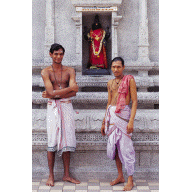 Kendrapada,
Orissa: Denied entry into a temple in Orissa by the upper
castes, Dalits of a village have built a shrine of their own and
appointed a Brahmin priest. Kendrapada,
Orissa: Denied entry into a temple in Orissa by the upper
castes, Dalits of a village have built a shrine of their own and
appointed a Brahmin priest.
Chauriberhampur
village on the outskirts of Kendrapada town in the coastal
district of the same name is home to nearly 1,400 people from
different castes as well as Muslims. It has a temple dedicated
to Hindu God Shiva where
Dalits and other lower castes were being denied entry as part of
an age-old practice.
"There
are 900 people in the village who belong to the 'hadi'
(scavenger) community and considered lower castes," said
Dalit leader Abhumunya Naik. Most
of them clean streets, toilets and do other odd jobs.
"We
have been worshipping Hindu Goddess
Maa
Mangala in an open
place. We decided to build a temple in that place for the
deity," Naik told.
"People
from our caste not only contributed financially but also built
the 30-feet high temple. It was completed last month at a cost
of nearly Rs.200,000." Naik
said Krupasindhu Patri, a Sanskrit scholar, had been appointed
the priest of the temple at a monthly salary of Rs.1,000.
"We
appointed a Brahmin priest because they know how to perform the
rituals," he said.
(source: Dalits
build their own temple in Orissa -
timesofindia.com).
Top
of Page
 Did You
Know?
Did You
Know?
Soaring Through Ancient Skies
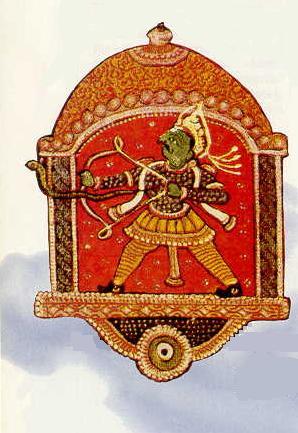 The
writing of ancient India are perhaps the richest in tales of aviation. The
Mahabharata, an epic tells of an "aerial chariot", with the
sides of iron and clad with wings," The
writing of ancient India are perhaps the richest in tales of aviation. The
Mahabharata, an epic tells of an "aerial chariot", with the
sides of iron and clad with wings,"
The Hindu Samara Sutradhara,
a 11th century AD collection of texts dating back to antiquity holds
a wealth of information on flight, treating many aspects of aircraft design and
even advising on the proper clothing and diet for pilots.
"The aircraft which can go by its own force like a
bird is called a Vimana," runs one passage. "The body must be strong
and durable and built of light wood, shaped like a bird in flight with wings
outstretched. Within it must be placed the mercury engine, with its heating
apparatus made of iron underneath."
The text goes on to describe "the energy latent in
mercury" at some length; unfortunately, though, it offers little
information on how that energy was utilized.
The Ramayana, the great Indian epic describes a double decked
circular aircraft with portholes and a dome – a configuration reminiscent of
20 th century flying saucer reports. Fueled by a strange yellowish
white liquid, the craft was said to travel at the "speed of wind"
attain heights that made the ocean look like "a small pool of water"
and stop and hover motionless in the sky.
(source: Feats and Wisdom of the Ancients
- Time Life Books p. 29).
For more refer to chapter on Vimanas.
Top
of Page
|